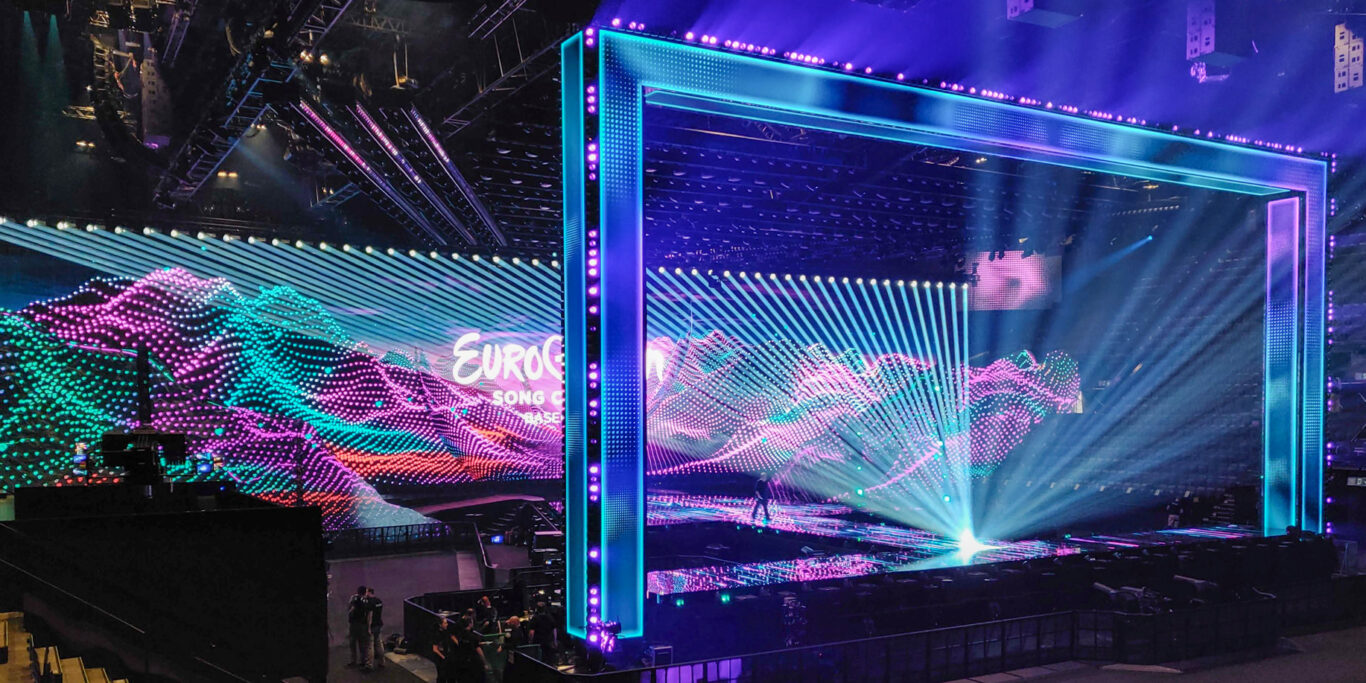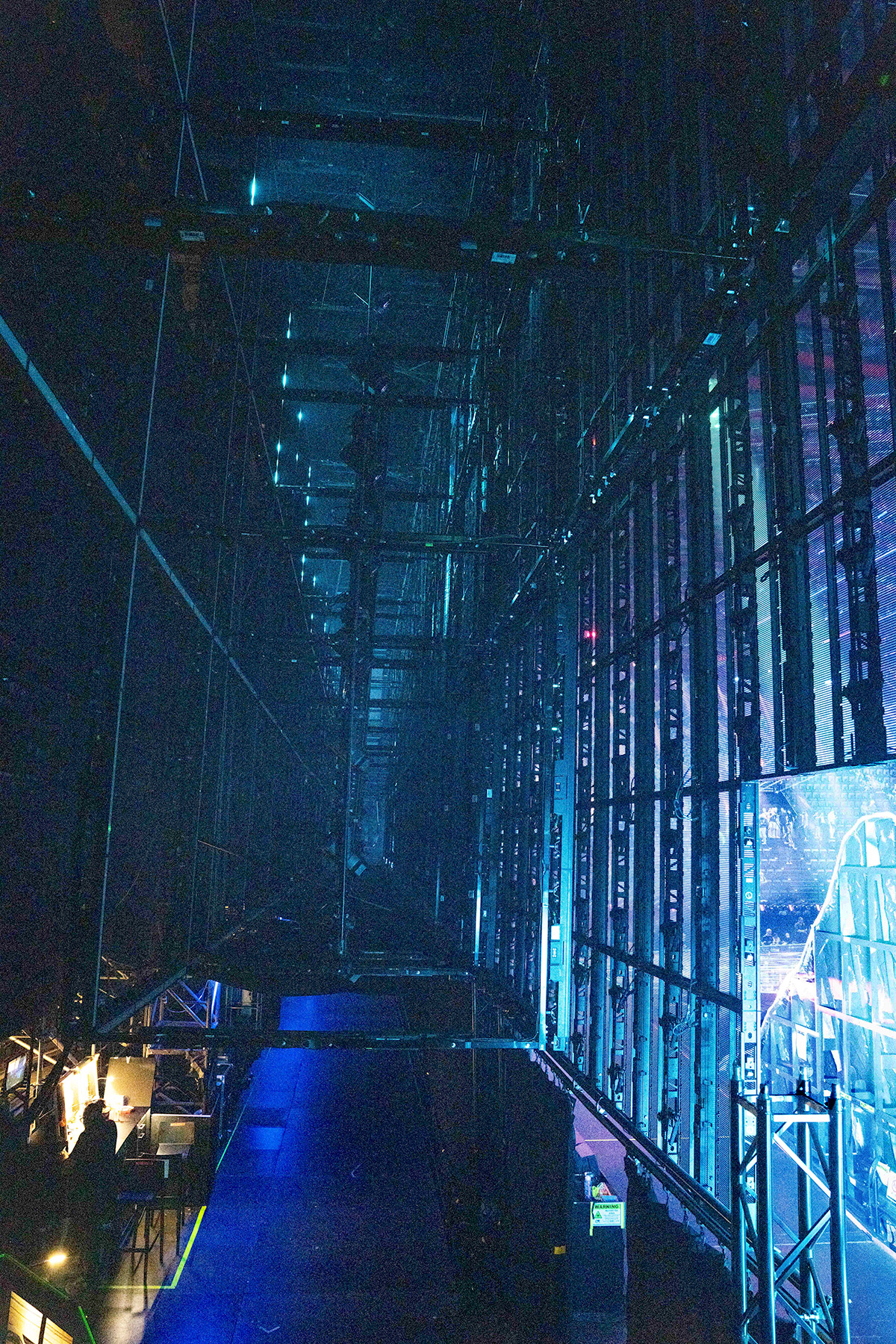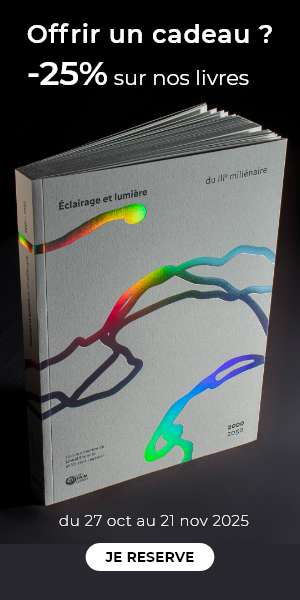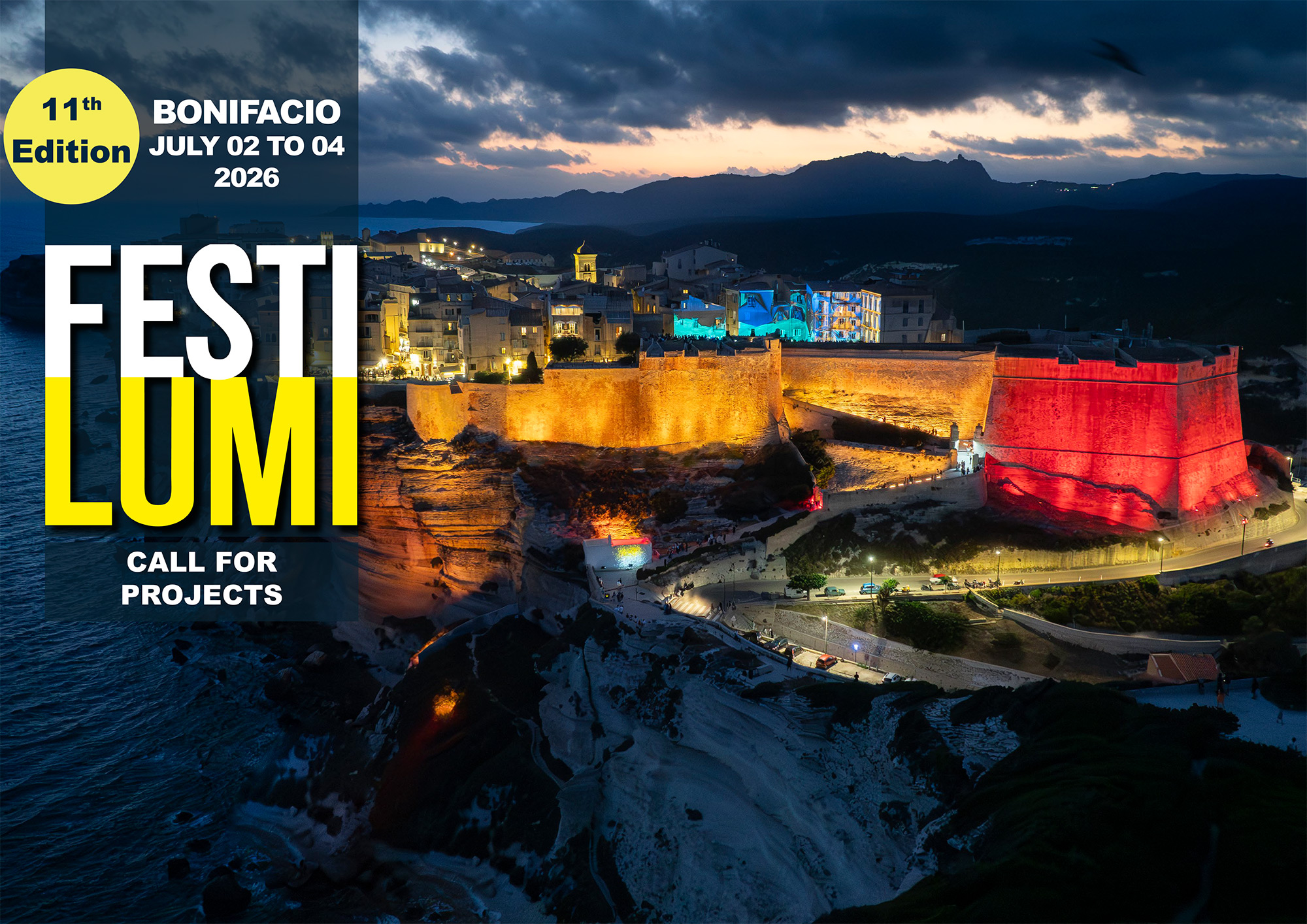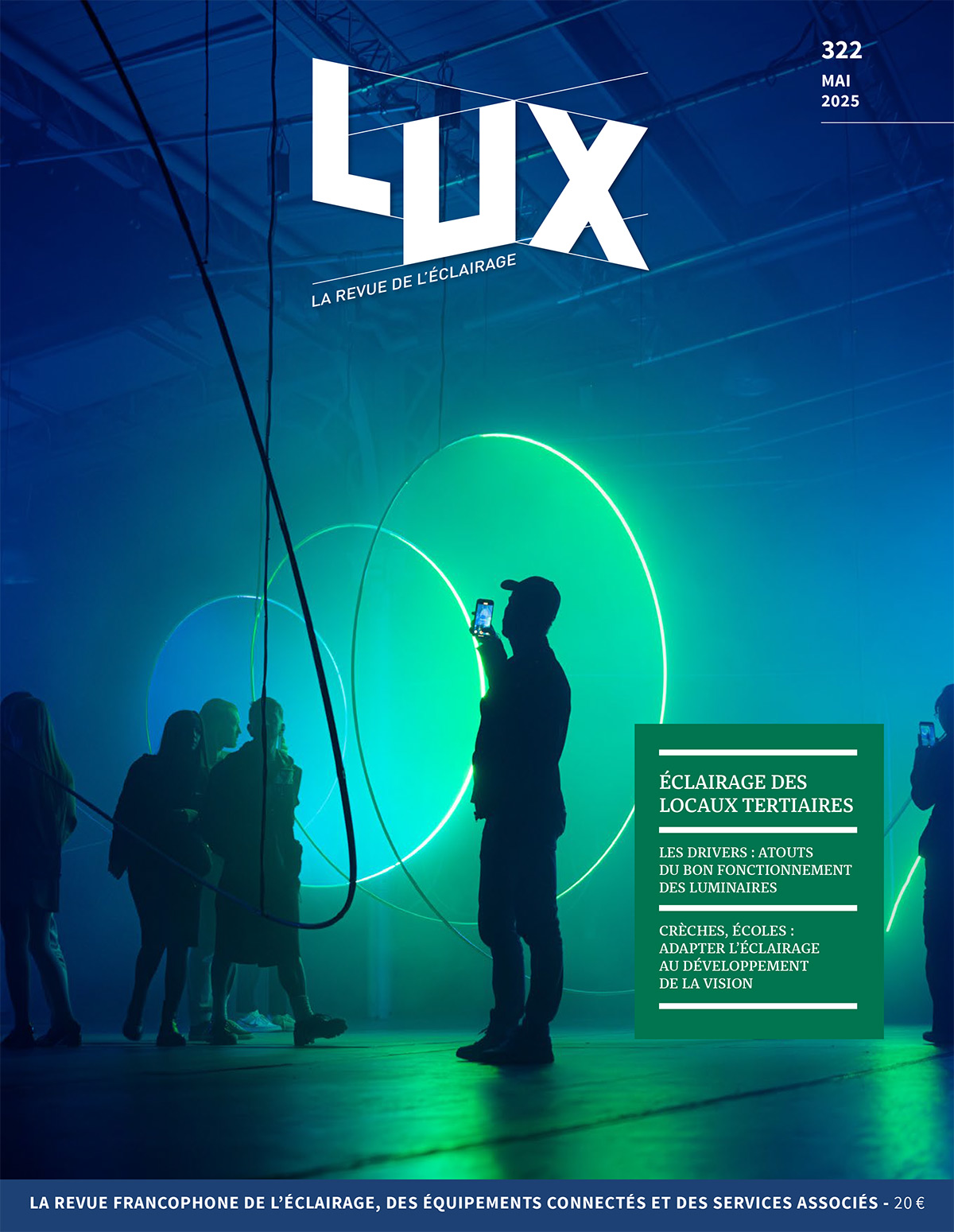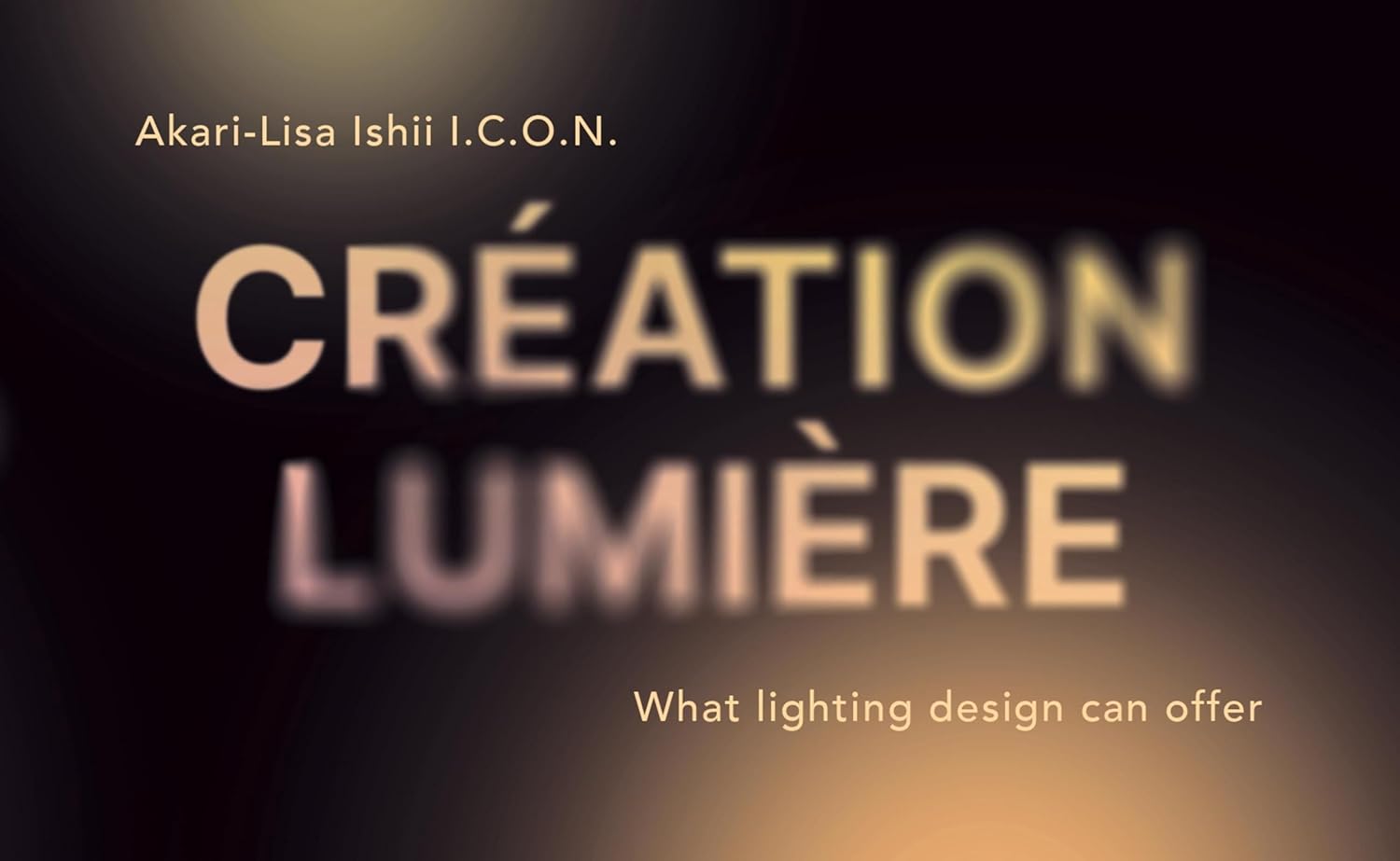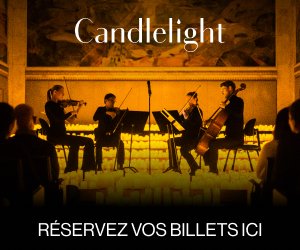Eurovision 2025: From song to LED stage lighting
More than ever, Eurovision 2025 is truly impressive. Firstly, due to the variety of the singers’ performances. This edition showcased an even greater diversity in musical styles. Secondly, the scenography and LED stage lighting implemented were remarkable. This year, a real stage cage was constructed in the arena dedicated to the song contest. It consists of a frame, a stage, light bridges, and a stage background. The upstage featured mountains, a giant screen, and a light grid, creating the impression that the backstage was opening up to the audience.
To celebrate the 10th anniversary of articles dedicated to this annual European TV event, I travelled to Basel, Switzerland. It presented an opportunity to interview the key individuals from the ESC 2025 production team. They work behind the scenes, supporting the talents who sing and dance, and are nevertheless essential to the show’s success. Ladies and gentlemen, I present to you:
- Damaris Reist, Deputy Director of Production.
- Keara Gutzwiller, Production assistant.
- Peter Aellig, Technical Director of TV Broadcasting.
- Florian Wieder, Set Designer.
- Tim Routledge, Lighting Designer.
- Markus Brockmann, Director of Sound.
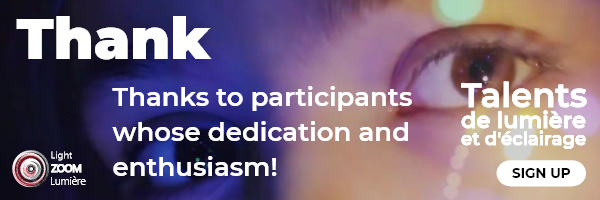
In this article, you will discover the behind-the-scenes workings of an extraordinary television production. What artistic choices has the team made? How does stage lighting contribute to the television show? What technical innovations have been implemented? What LED screens are used? How is the machinery of the show constructed? What is the lighting design of the 2025 winning song?
Enter through the main door to the television set and uncover the foundations of a spectacular and luminous scenography. Congratulations to the team!
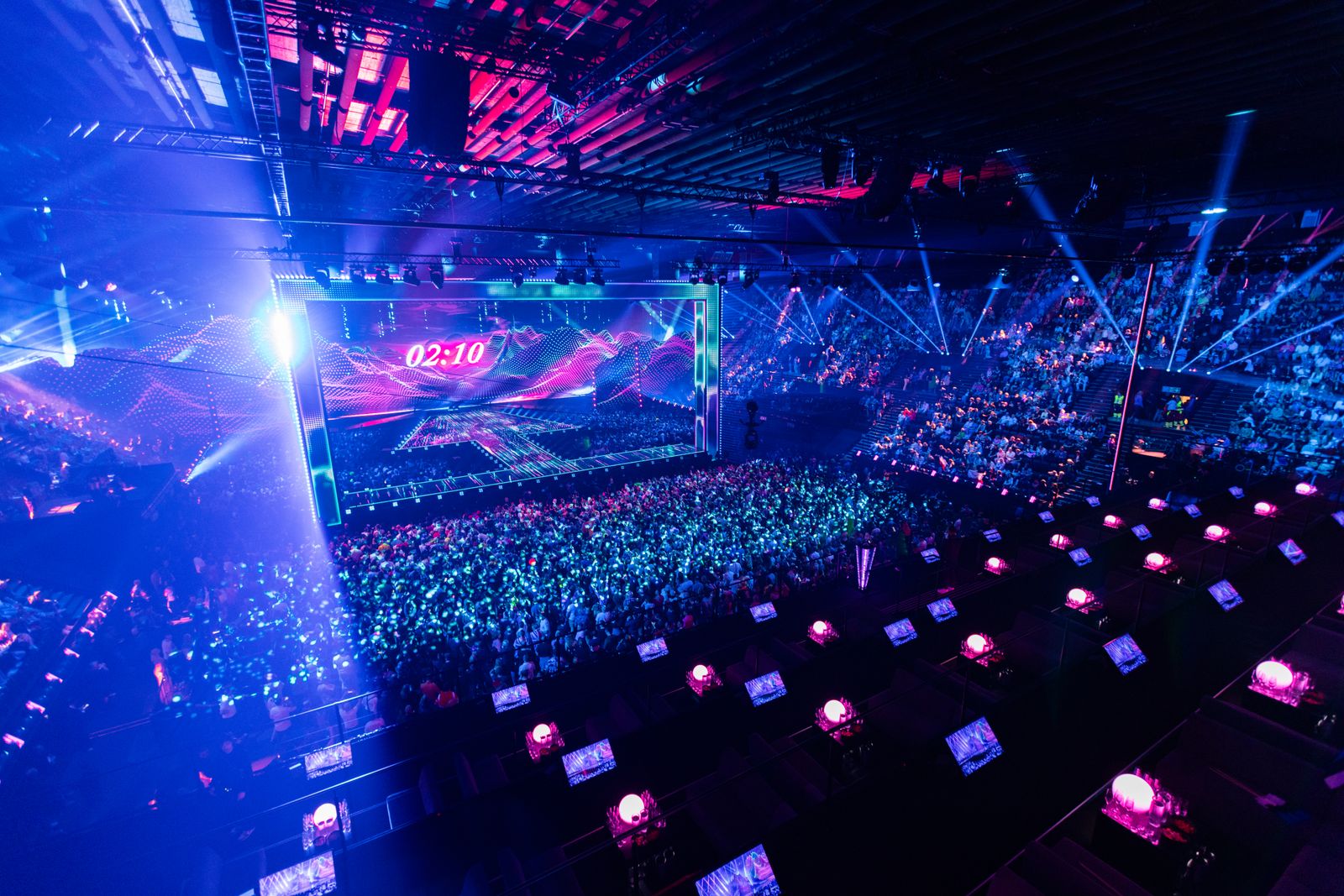
Contents
- Interview with Florian Wieder, Eurovision 2025 set designer for the song
- Interview with Tim Routledge, lighting designer of stage lighting
- Dimensions of the Eurovision 2025 TV set
- TV production and broadcast figures, Eurovision 2025
- Photos of the lighting control room, LED screen and TV broadcasting
- Eurovision 2025 winner: Austria, Wasted Love by JJ
- Eurovision 2025: France, Louane, maman, 7th place
- Thank you for the welcome at Eurovision 2025!
- Dig deeper (in French)
- Commentaires

Interview with Florian Wieder, Eurovision 2025 set designer for the song
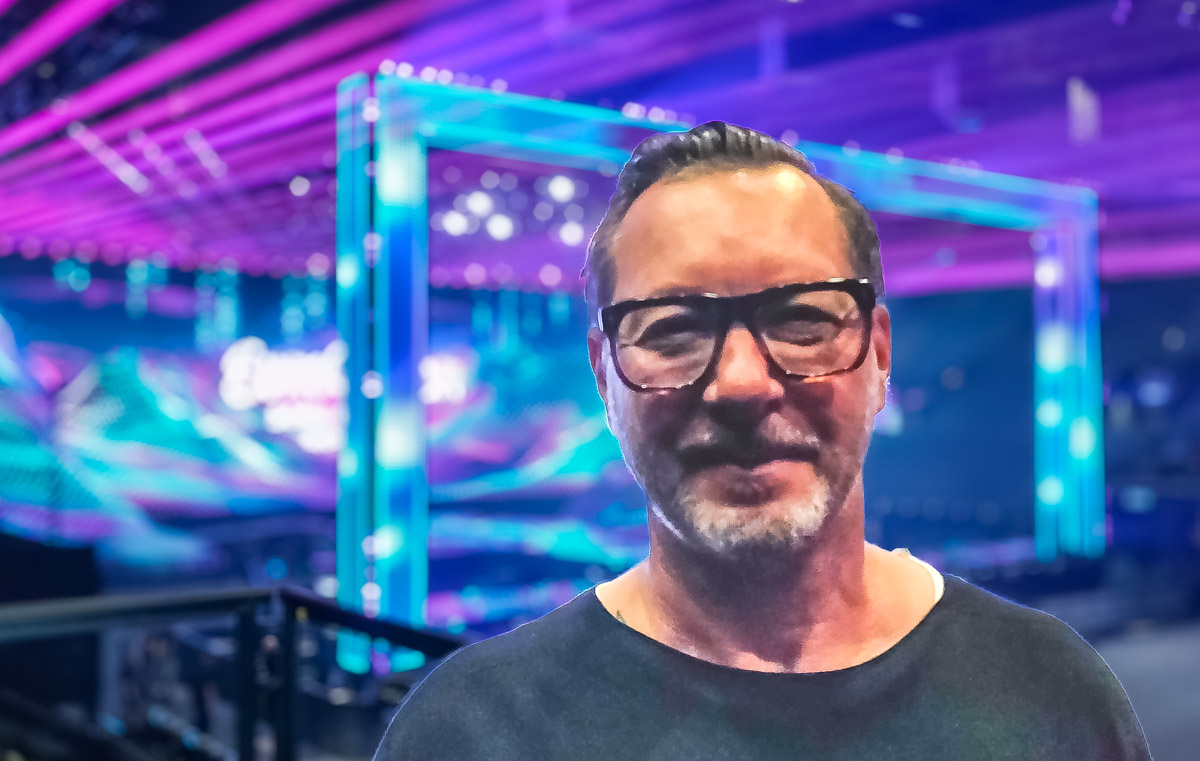
What was the most important challenge in this arena?
Florian Wieder: The biggest challenge was that the ceiling can’t carry any weight. Everything you can see up in the air is ground supported. We decided to go for four massive truss legs. Two of them are hidden behind the 3D grid structure and the LED Screen. The two downstage legs are incorporated in the frame. I think we found a very elegant way to visually work around this issue.
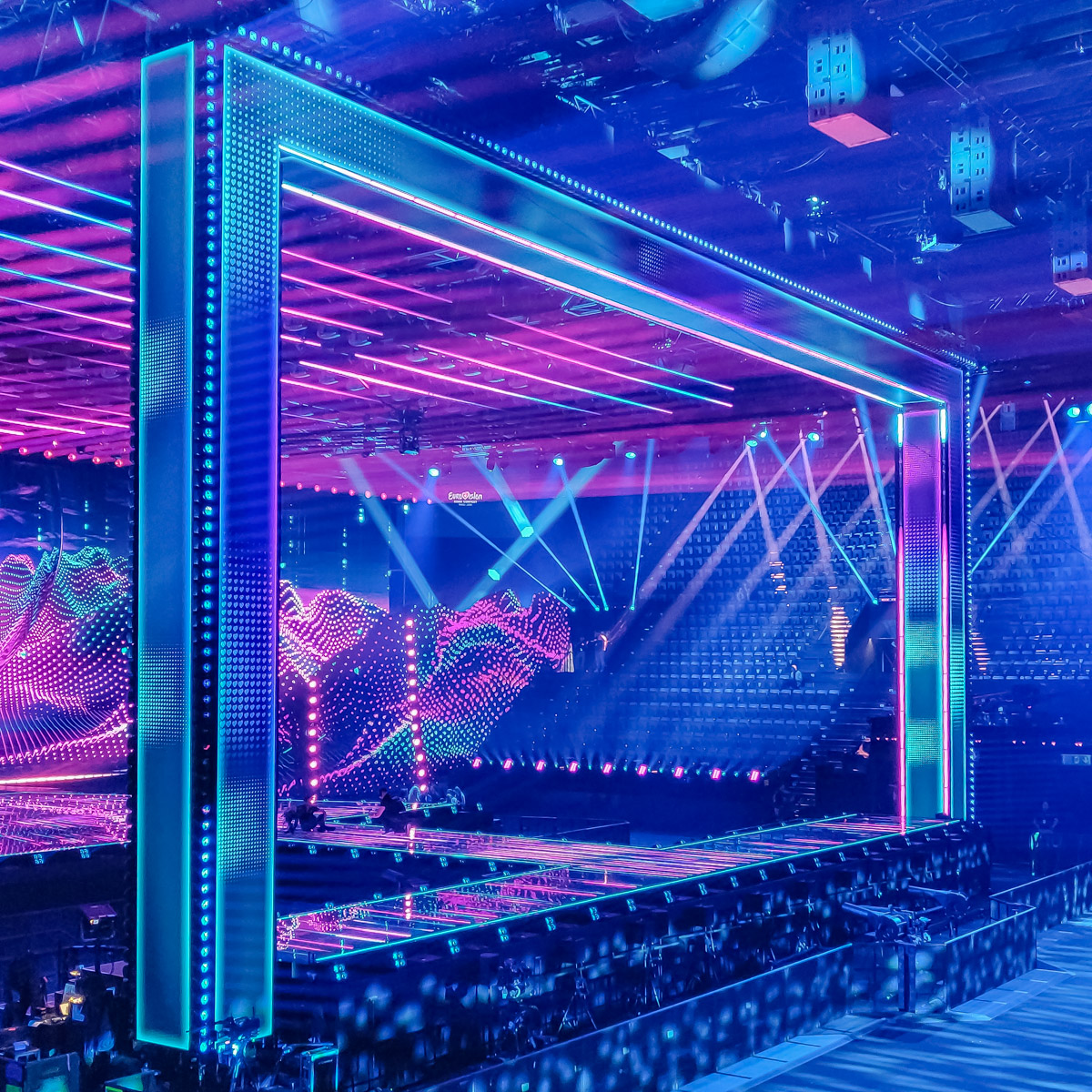
If you don’t know it, you imagine it’s an arch.
Florian Wieder: Yes, we turned it into a design piece dominating the room. The frame / letterbox idea works well in the room.
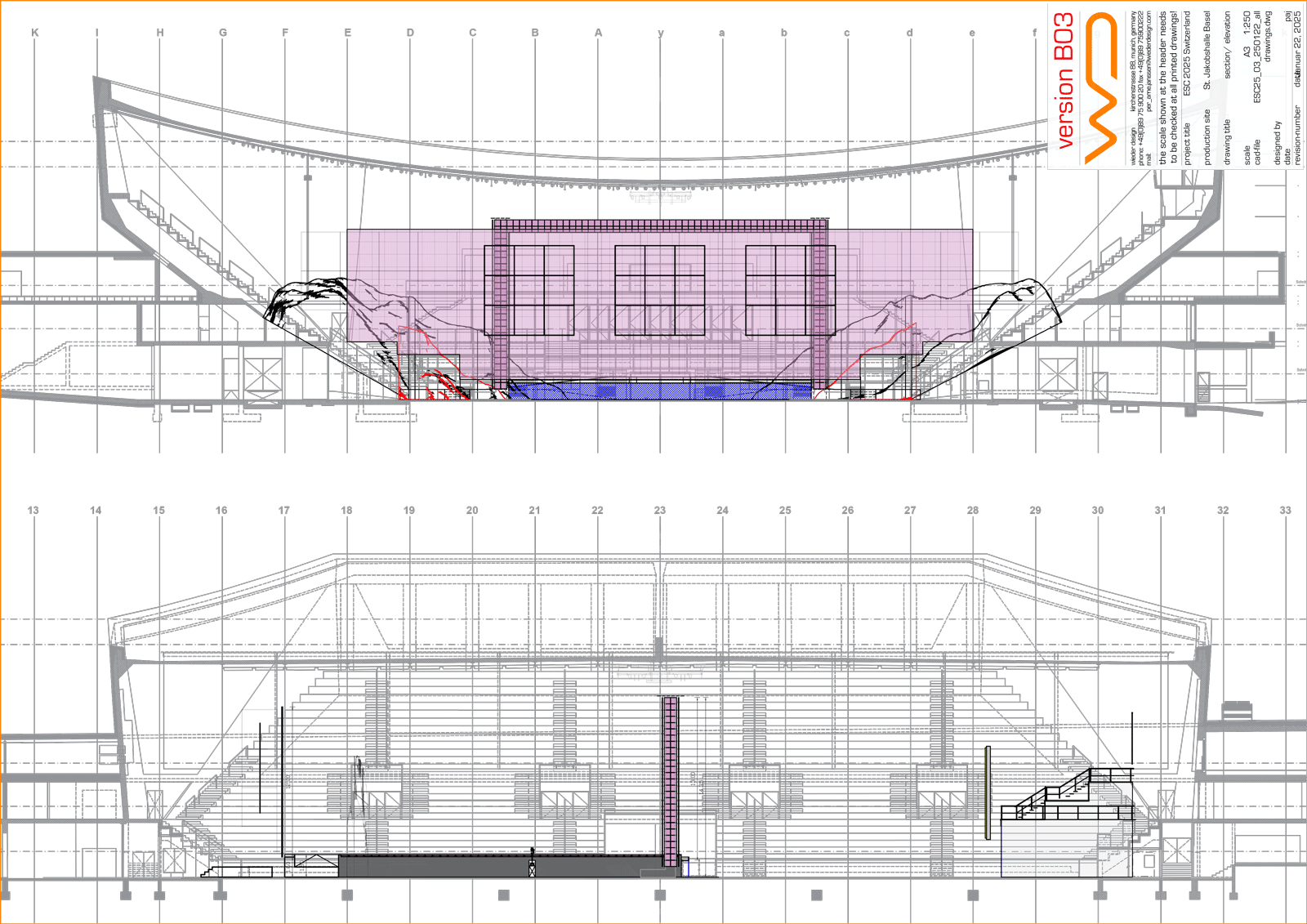
How do you turn the concept into reality?
Florian Wieder: The design almost didn’t change from the very first draft to what’s now in the room. There only have been minor changes. Our goal is always to bring the audience as close as possible to the talent on stage. For this we created 2 audience pits left and right between the main stage and the frame.
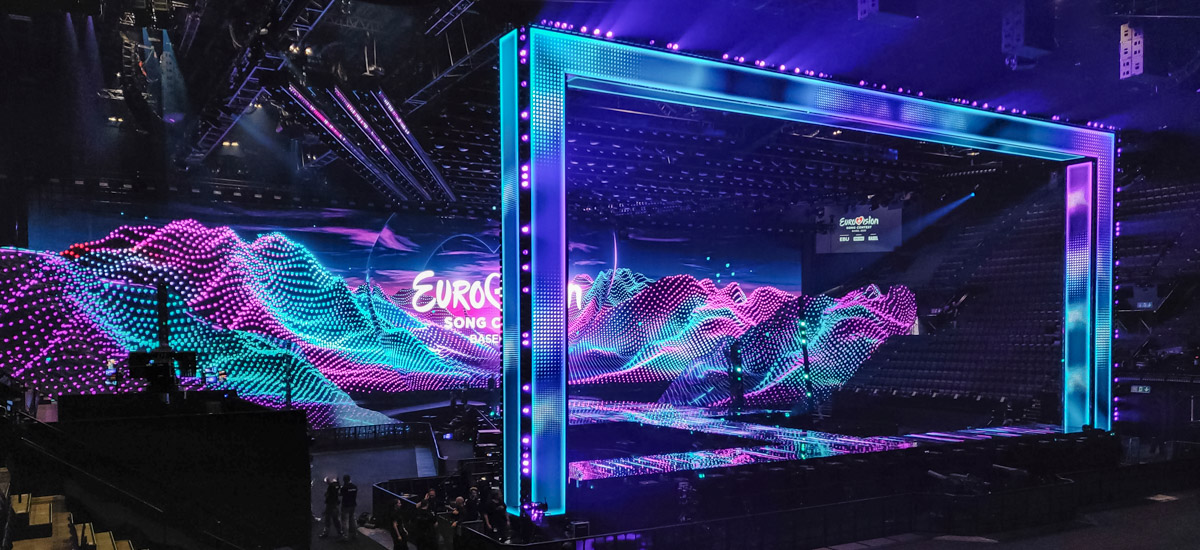
In our initial draft we had a third performance incorporated. It turned out that this is killing too much audience space. This is why we reduced it down to two stages.
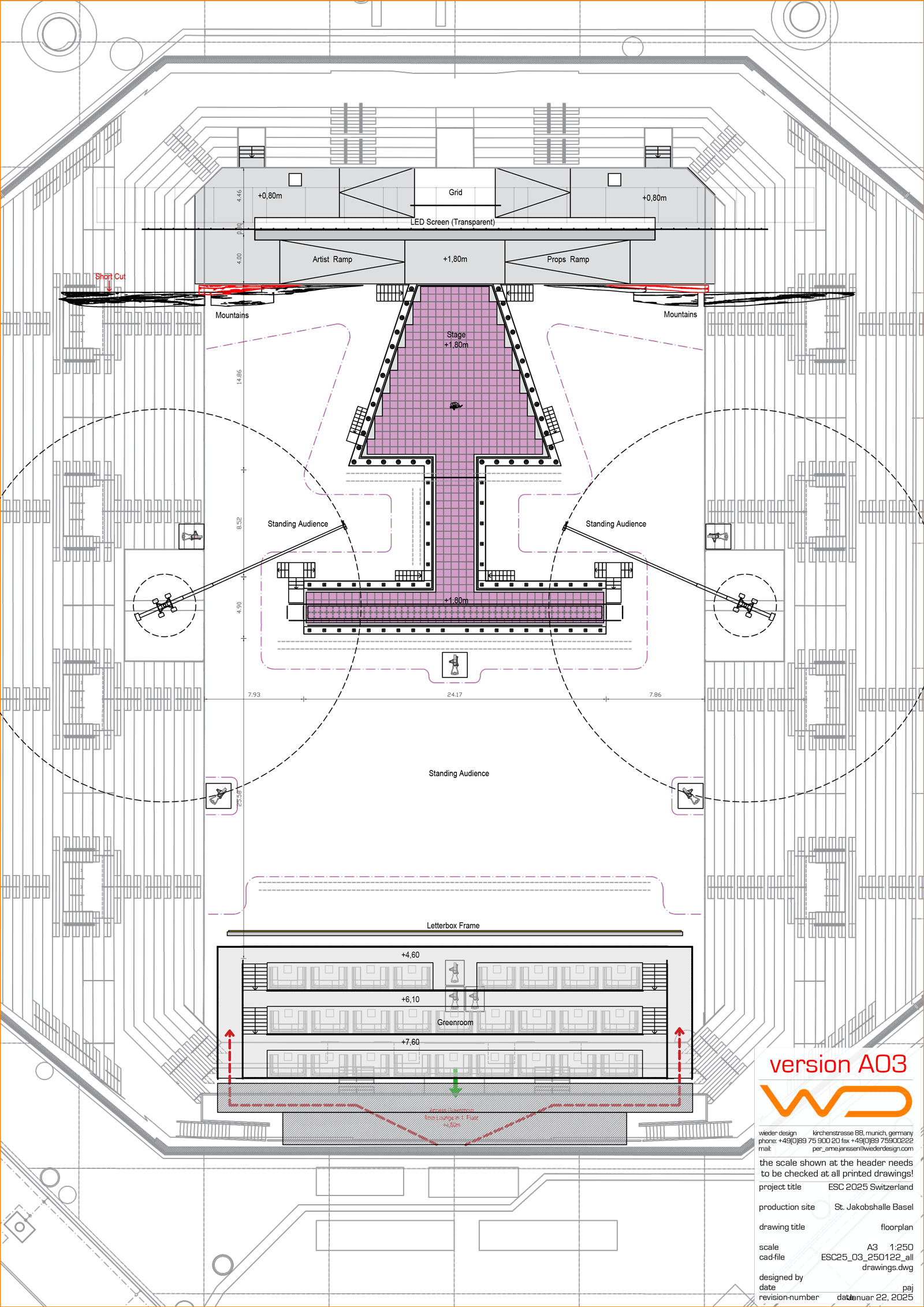
Quelles sont les dimensions de la scène ?
Florian Wieder : The main stage is approximately 15 meters wide and 14 meters deep. It’s designed in a forced perspective.
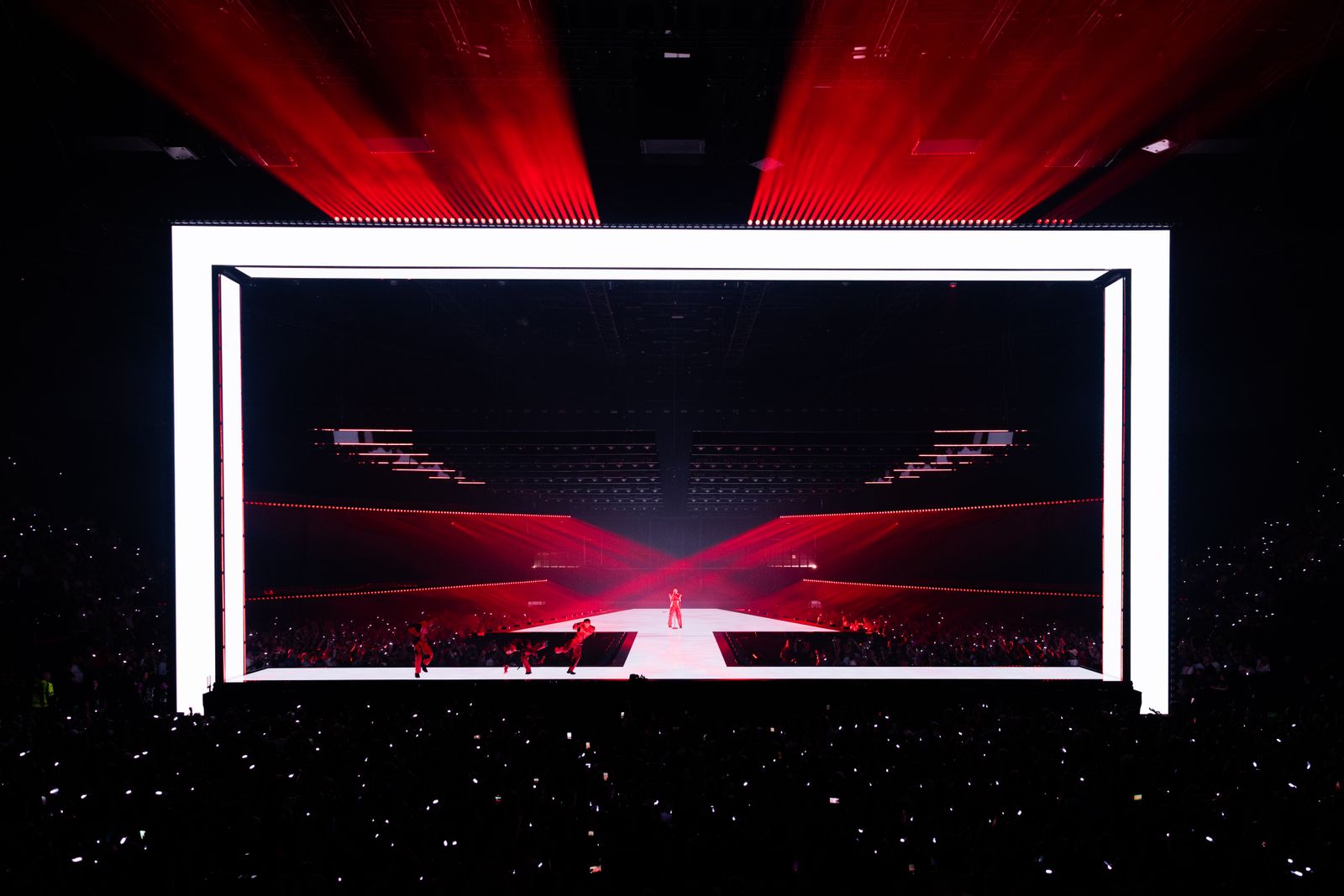
There is a second stage incorporated into the frame, one of the signature pieces dominating the room. This stage is 24 meters wide and 3.5 meters deep. Both areas are connected by a runway.
How do you build a stage with an LED screen?
Florian Wieder: In terms of fixtures and toys, we incorporated LED into the floor. It’s a shiny floor product. In this case, it’s Roe Black Marble when there is no screen content on the floor, it’s black high gloss.
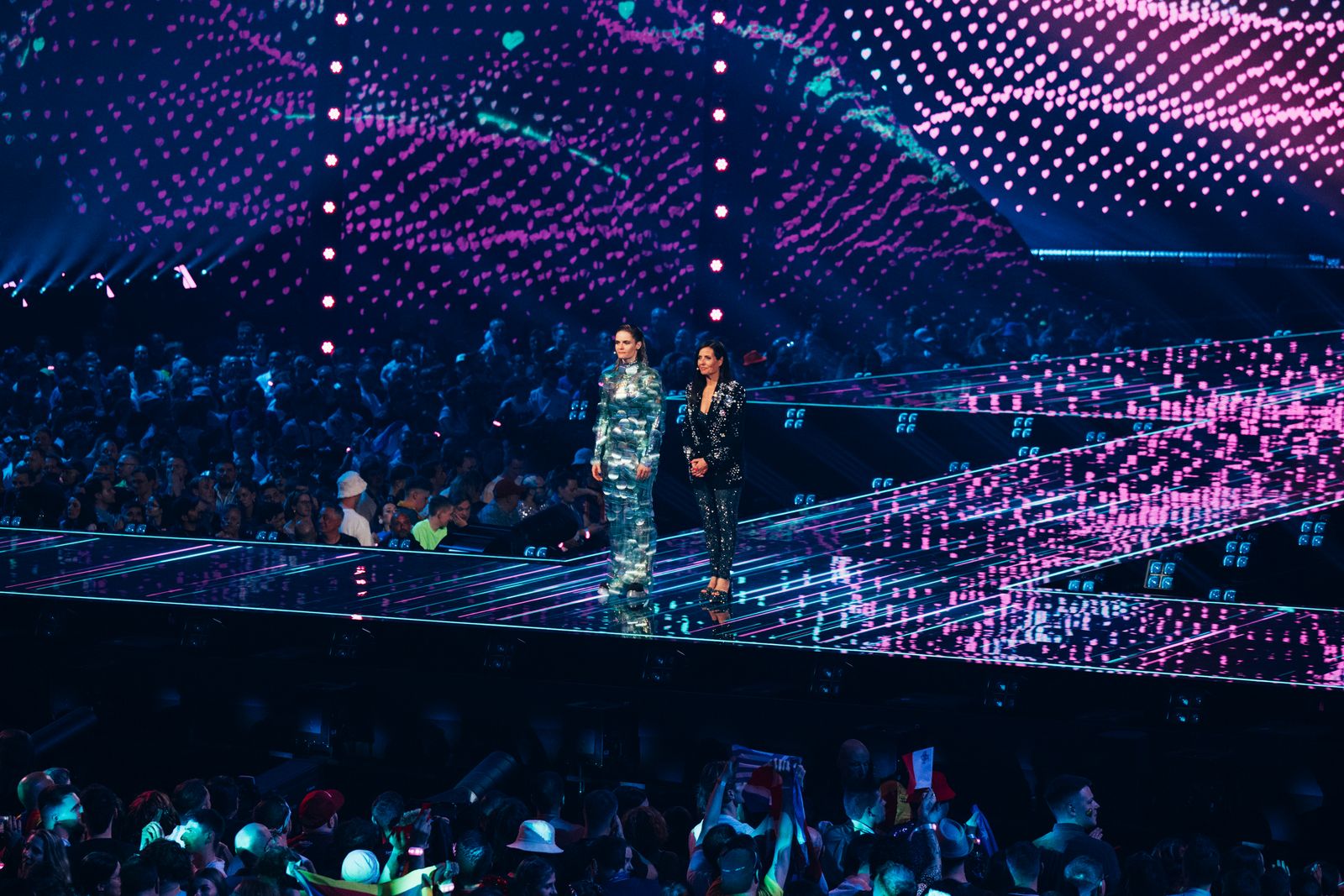
Depending on what the screen content is, you can change the shape and appearance of the stage. You can feature certain areas and lose other – or you can flood the entire stage with content.
How is the stage background built in multilayers?
Florian Wieder: We do have our huge LED screen, which is a transparent product. We decided to go for Roe Vanish 8. It’s one of the best products when it comes to transparent LED screens.
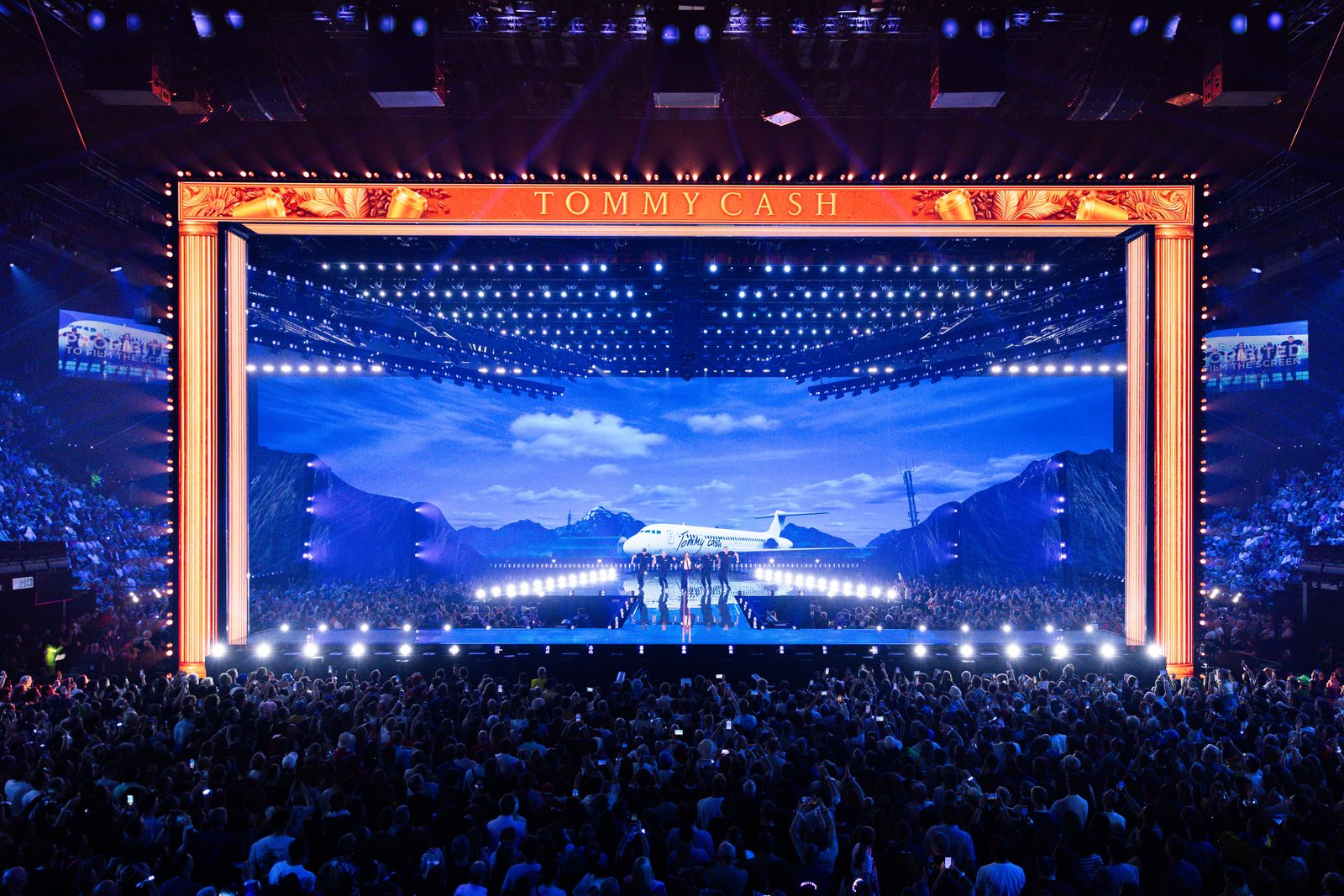
Behind the LED screen, we have a huge multilayered 3D grid structure.
This entire grid structure is active and has lighting fixtures and LED products attached to it.
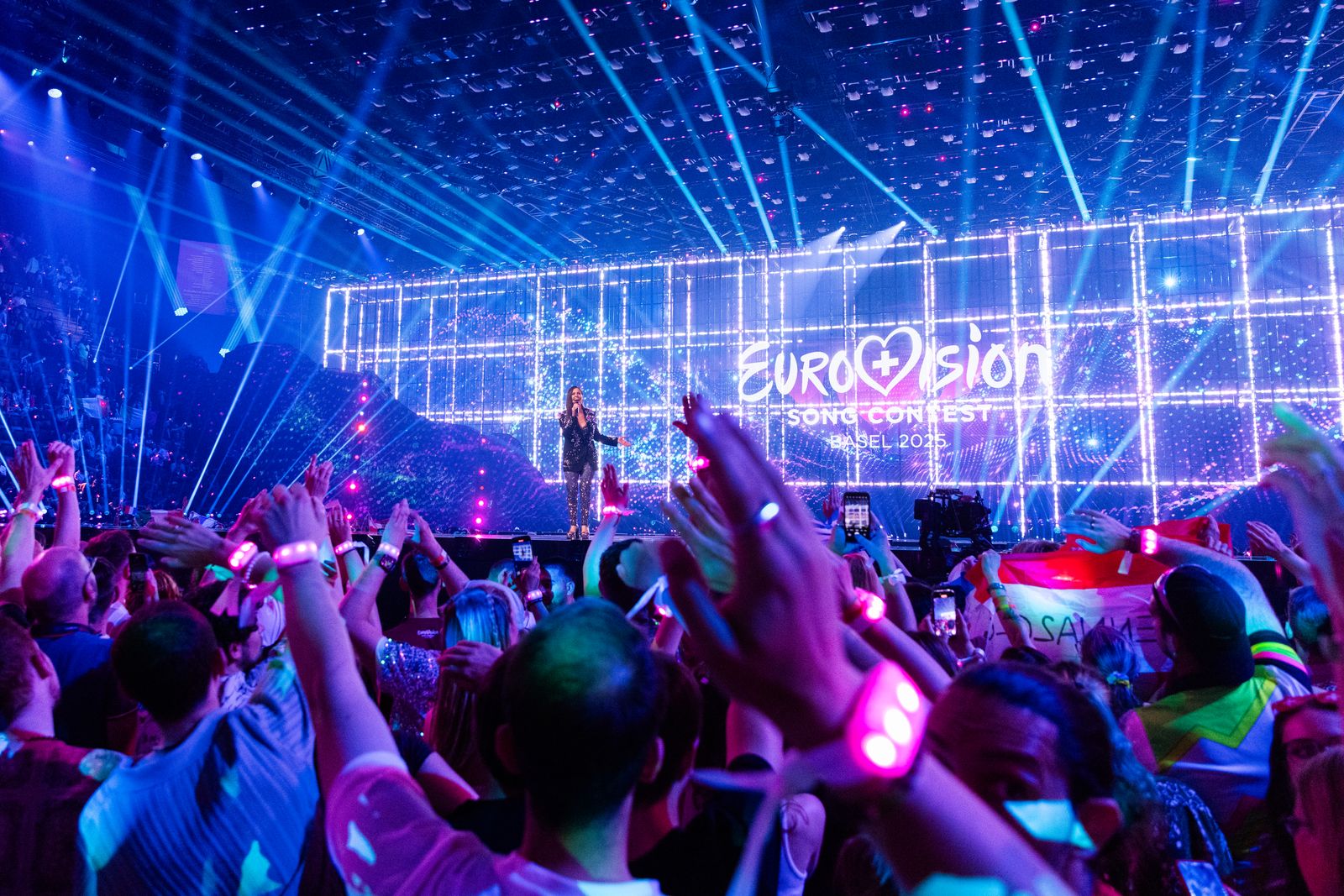
We can feature the grid or lose it completely. This is giving us a lot of flexibility, and we can get many different looks out of it.
What is it about the Swiss mountains on the stage?
Florian Wieder: My intention was to come up with a design that has a physical and theatrical approach.
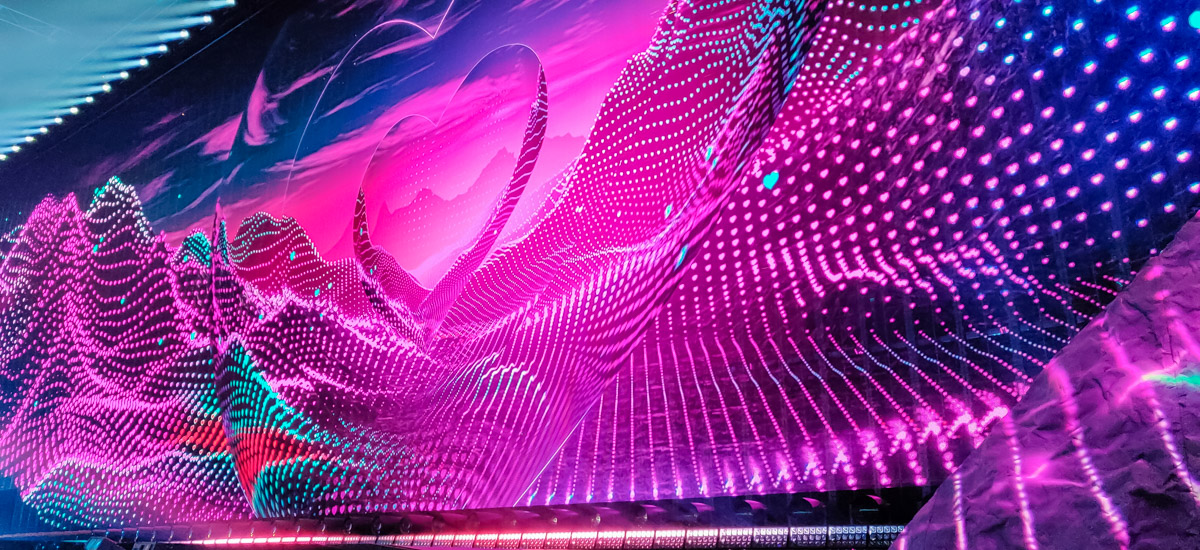
One of the main elements in terms of concept are these two layers of mountains. We do some projection mapping on the mountains. It works well.
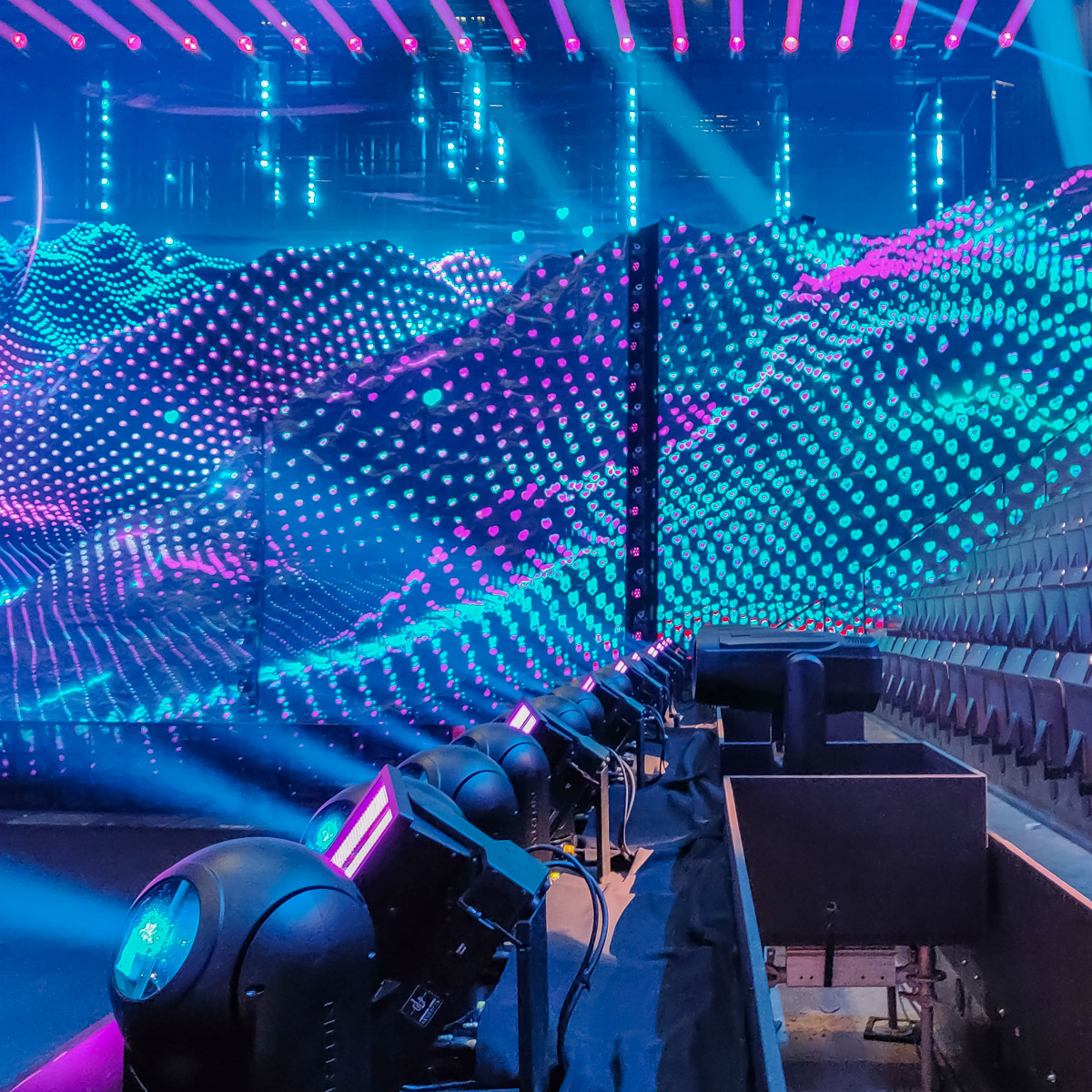
Could you tell me more about the frame?
Florian Wieder: We created this huge letter box, a massive 3D frame cladded with LED and lighting fixtures attached to it.
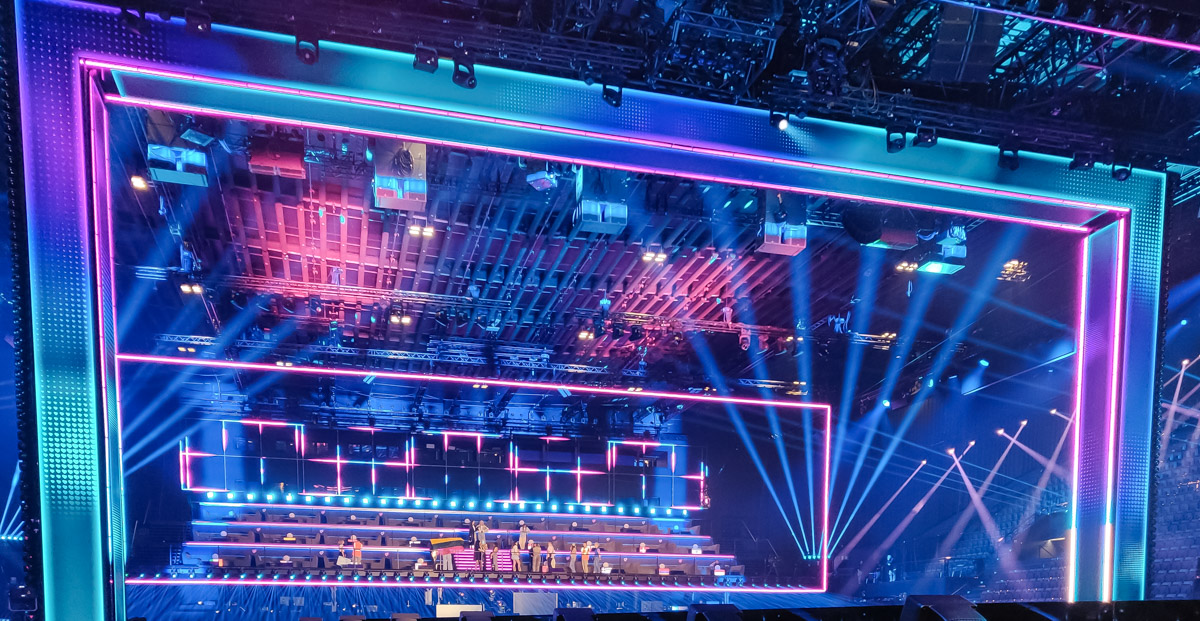
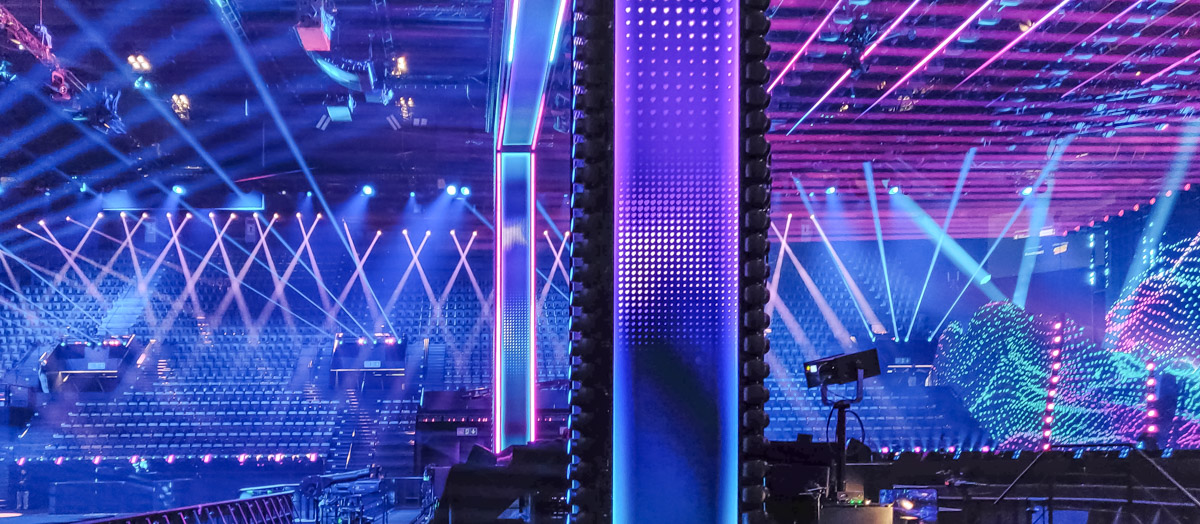
What happens to the ribs above the stage?
Florian Wieder: It works like a kinetic sculpture. We have multiple different fixtures attached to it. Some are more linear and architectural mixed up with conventional lighting fixtures.
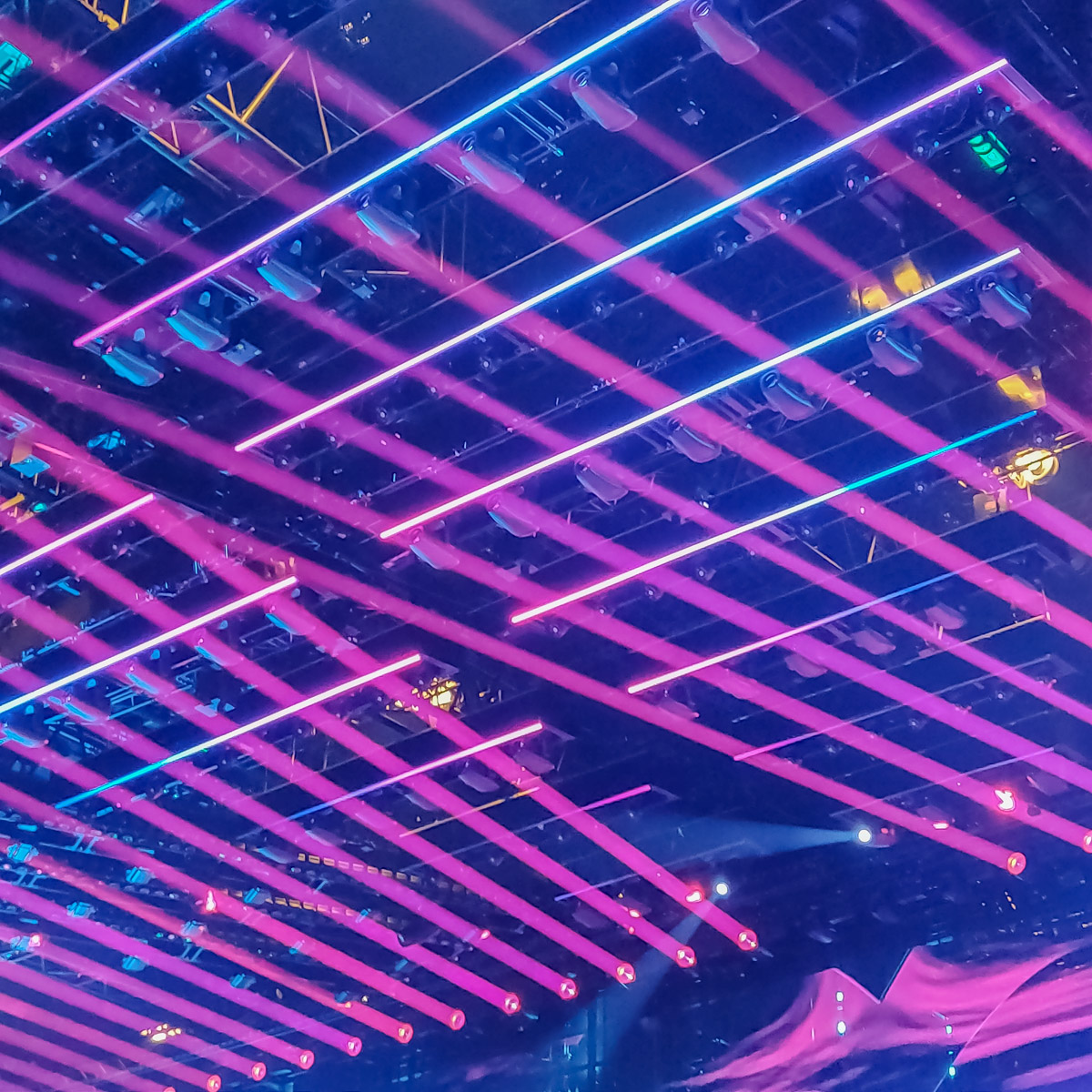
From one song to another, the stage is changing completely.
Florian Wieder: The interesting thing is that you can create intimate moments if you lower the ceiling.
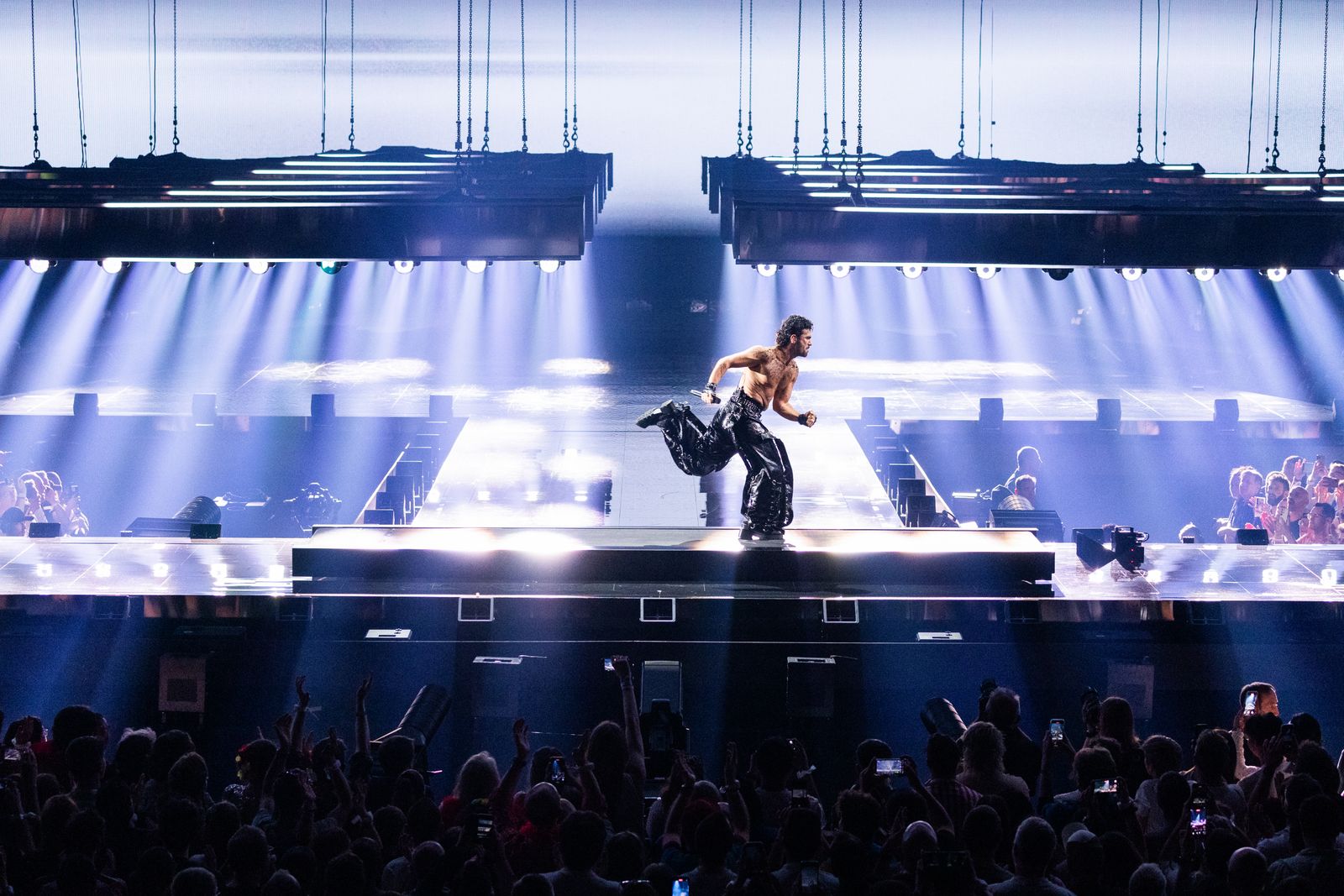

You can create different shapes with it. It can be a roof or an arch, or whatever is needed.
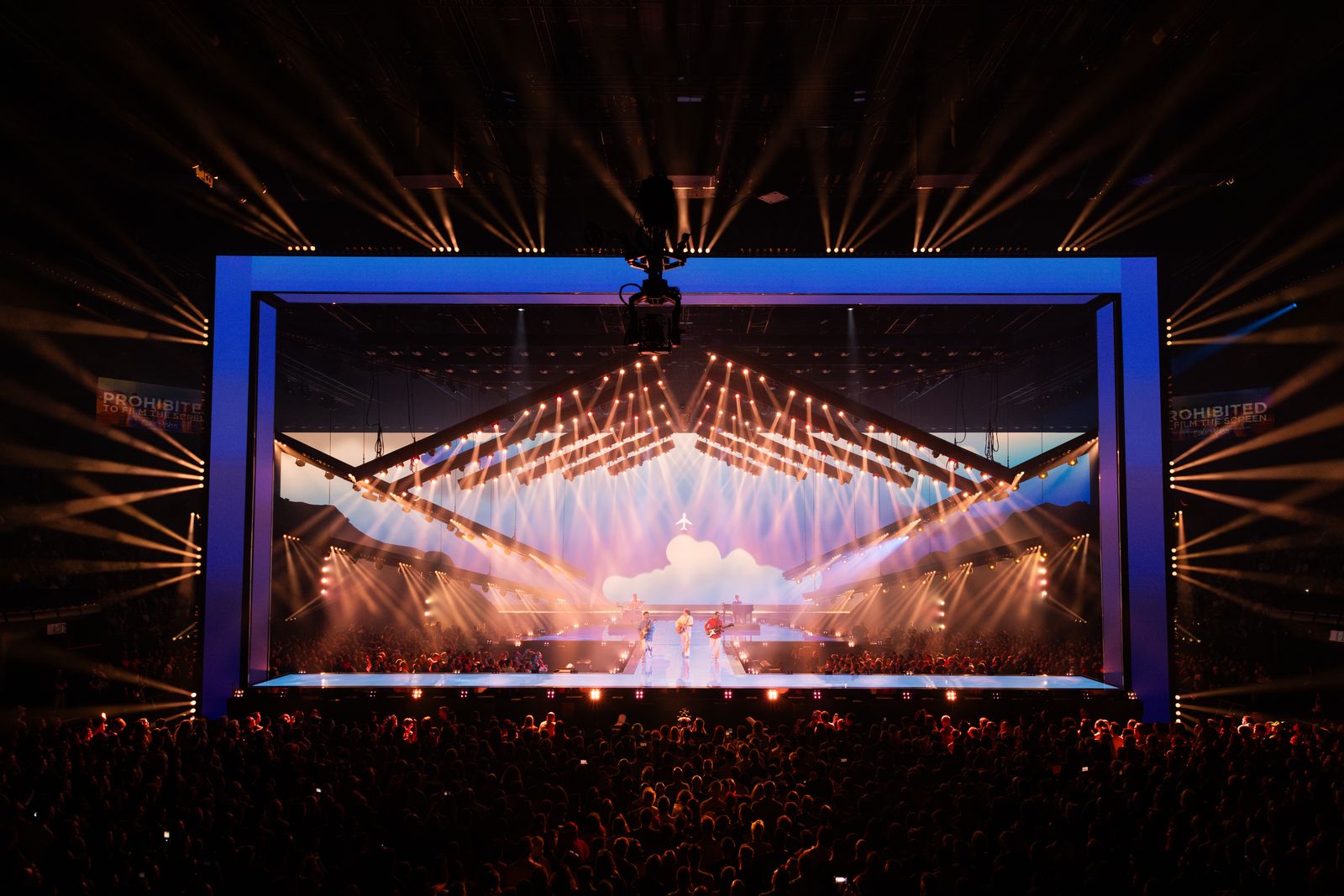
Is the hall smaller compared to previous years?
Florian Wieder: Its one of the smaller venues. It works well for the TV show. In terms of the audience, being bigger is always better. What counts is that the show looks big on TV. That’s why the stage is built in a forced perspective. However, a smaller venue usually has better energy in the room because the audience is closer to the talent on stage.
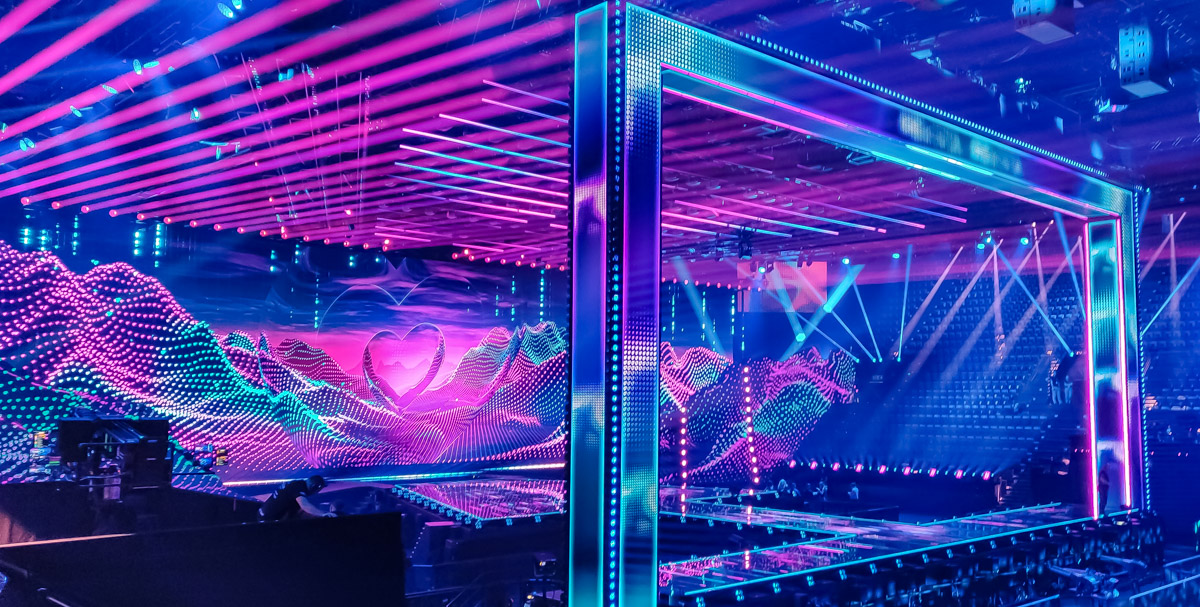
Utilises-tu certaines innovations dans la scénographie ?
Florian Wieder: People were asking me “Do you have some stuff you haven’t used before”? The way I work has a creative approach. I’m not driven by technology. The idea comes first – than I start thinking of technical solutions and how to execute this in the best possible way. To me it’s more important what the product can do and if it’s the right tool to support creative.
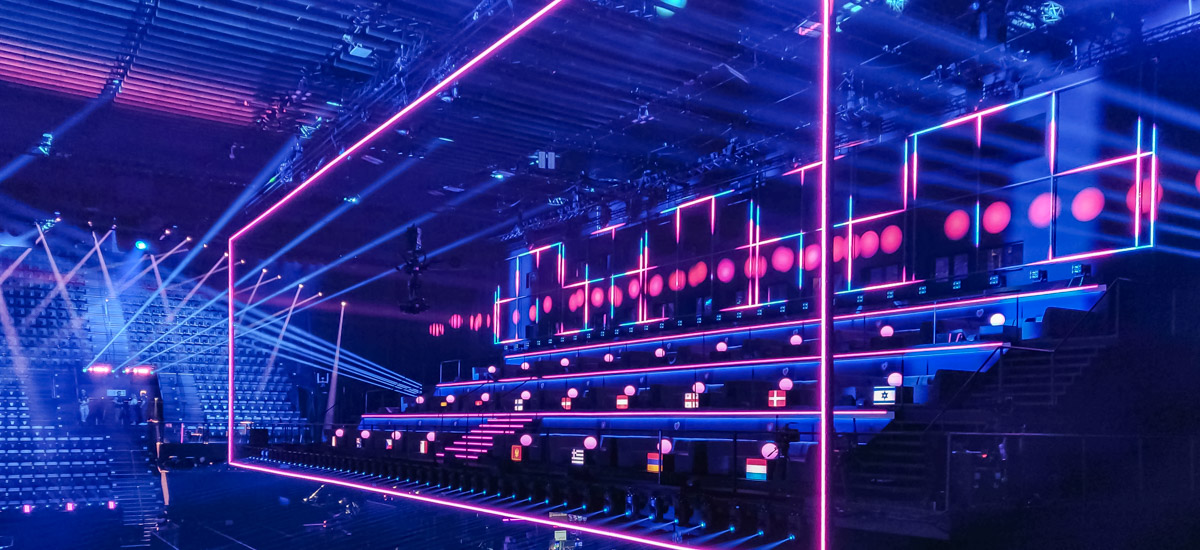
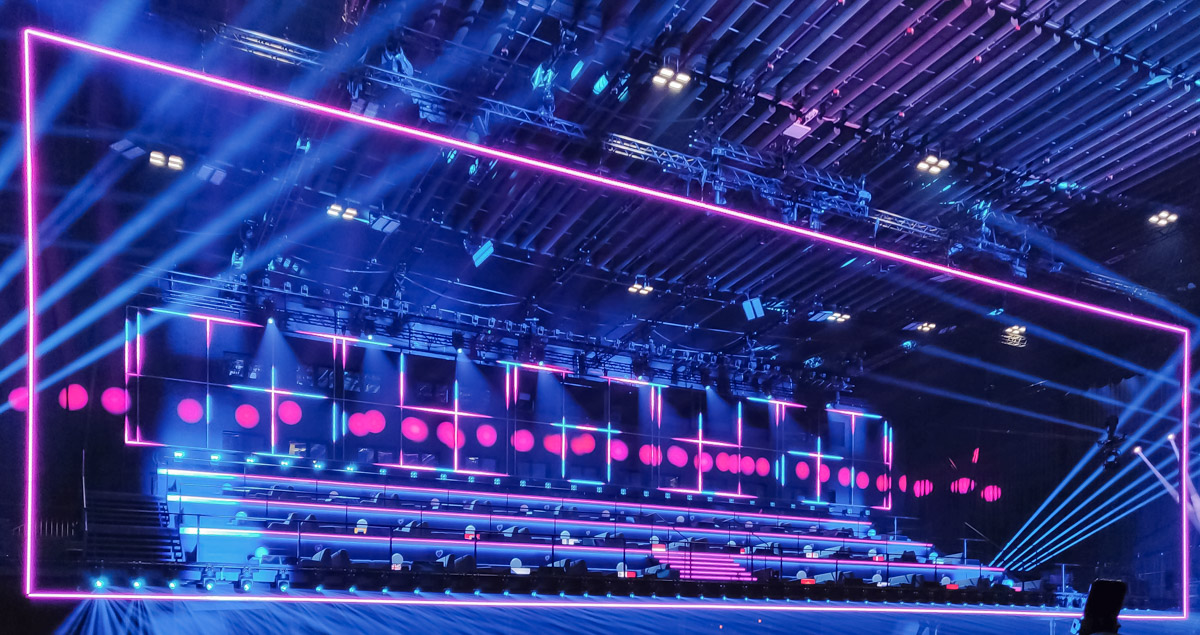
Tim incorporated some brand-new lighting products. Super interesting stuff. The way he uses it is just incredible. It has an amazing effect. It looks like he is bending light, this is physically impossible.
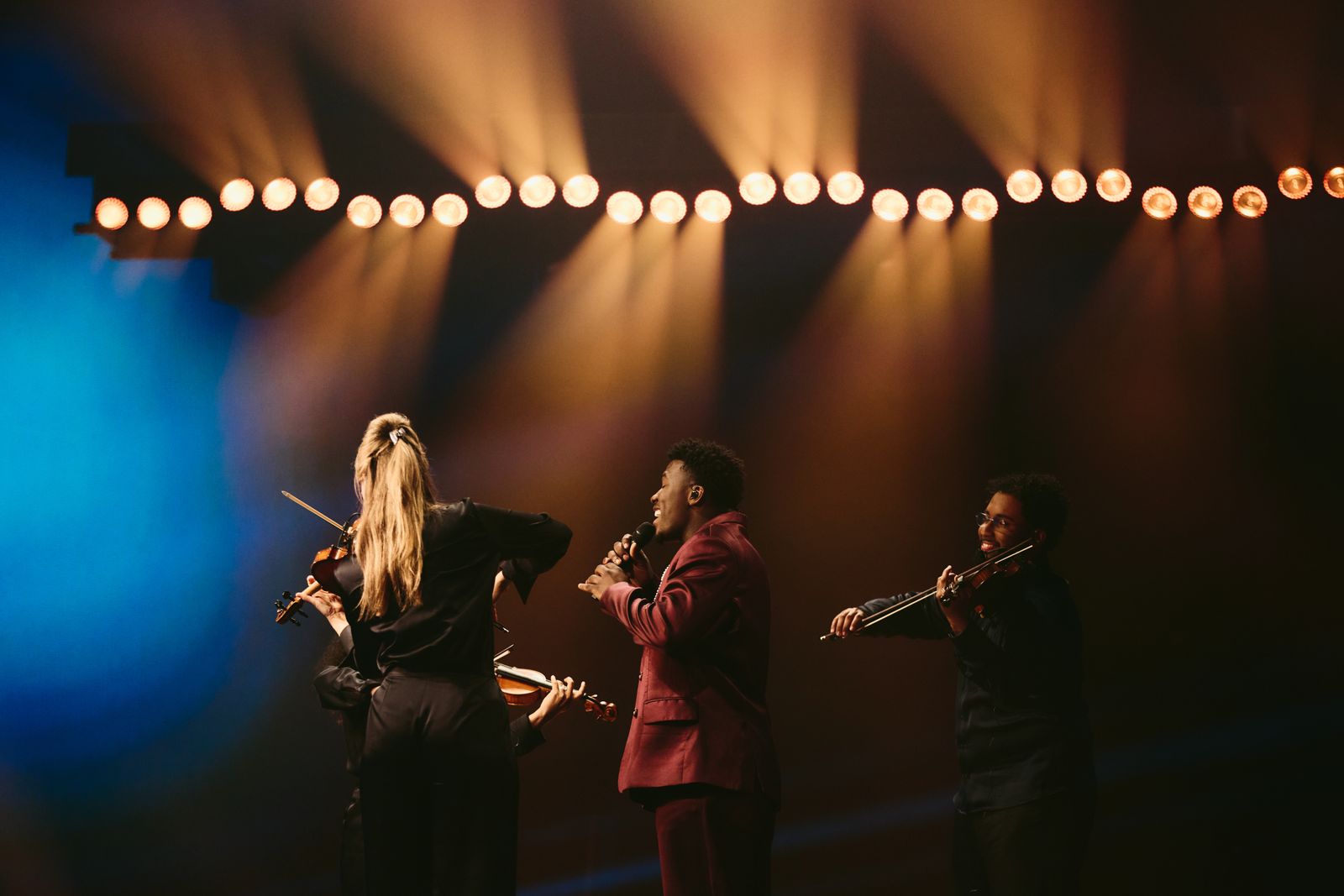
Are you viewing your scenography in a way that you didn’t expect?
Florian Wieder: I have seen many unexpected looks, because I have seen all the performance is actions. So, when you come about the concept for show like this one thing is to come up with an iconic signature look for the show. Let’s call “generic look”.

The other important thing is to create the best possible playground for the delegations. Giving them a space full of opportunities for all the amazing stuff they come up with. Some of them need a little more support, others don’t need any support because they know exactly what they are looking for. I’ve been excited to see how many different ideas the delegations came up with.
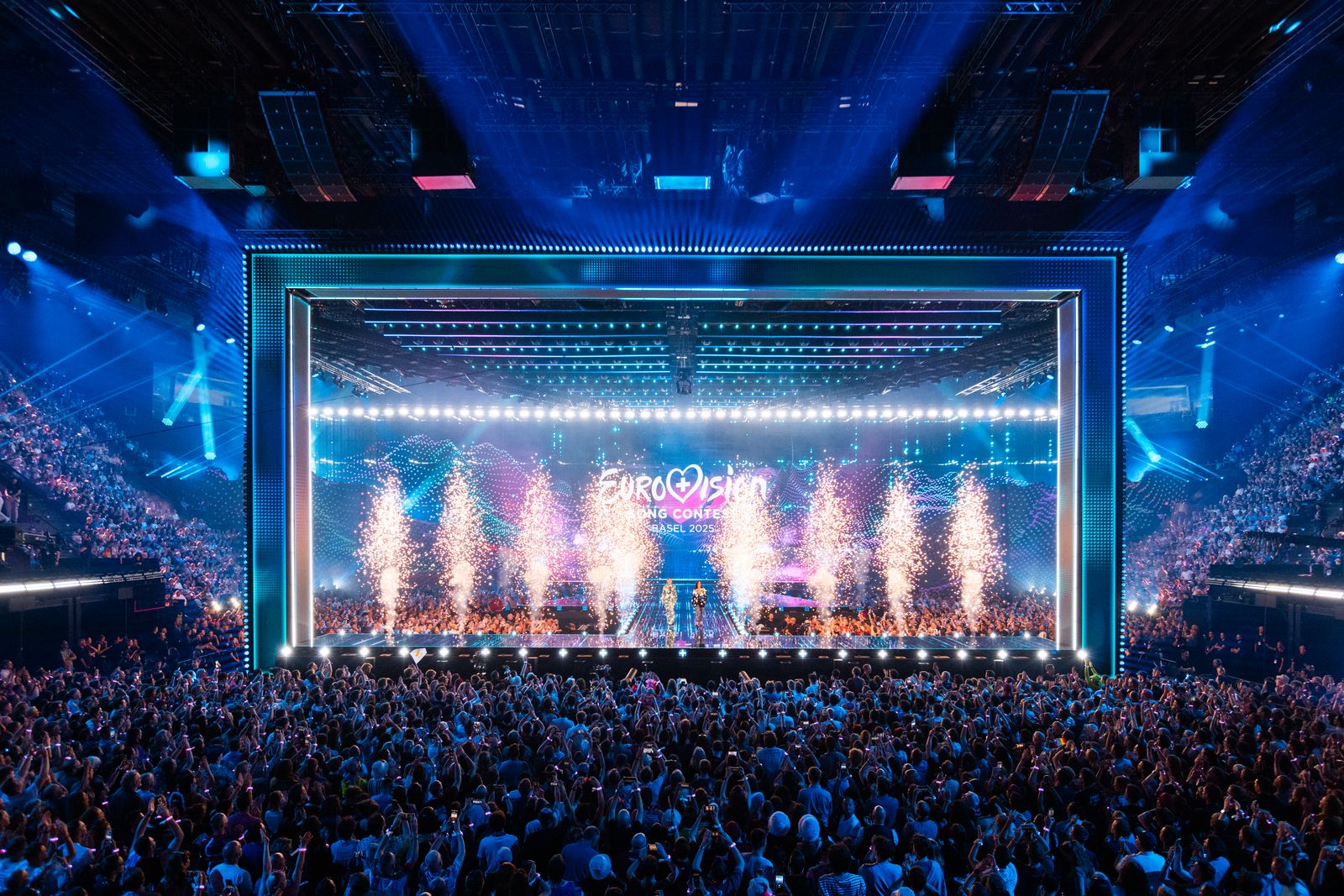

Comment l’éclairage joue-t-il dans ta scénographie ?
Florian Wieder: Tim and I have a wonderful collaboration on this project. My stage wouldn’t work without what he does – same the other way around. He is an amazingly talented lighting designer and it’s great to see how he brought our set to life. The show is about variety. So, every performance should look different. We try to get as many different looks out of it. Tim did an amazing job!
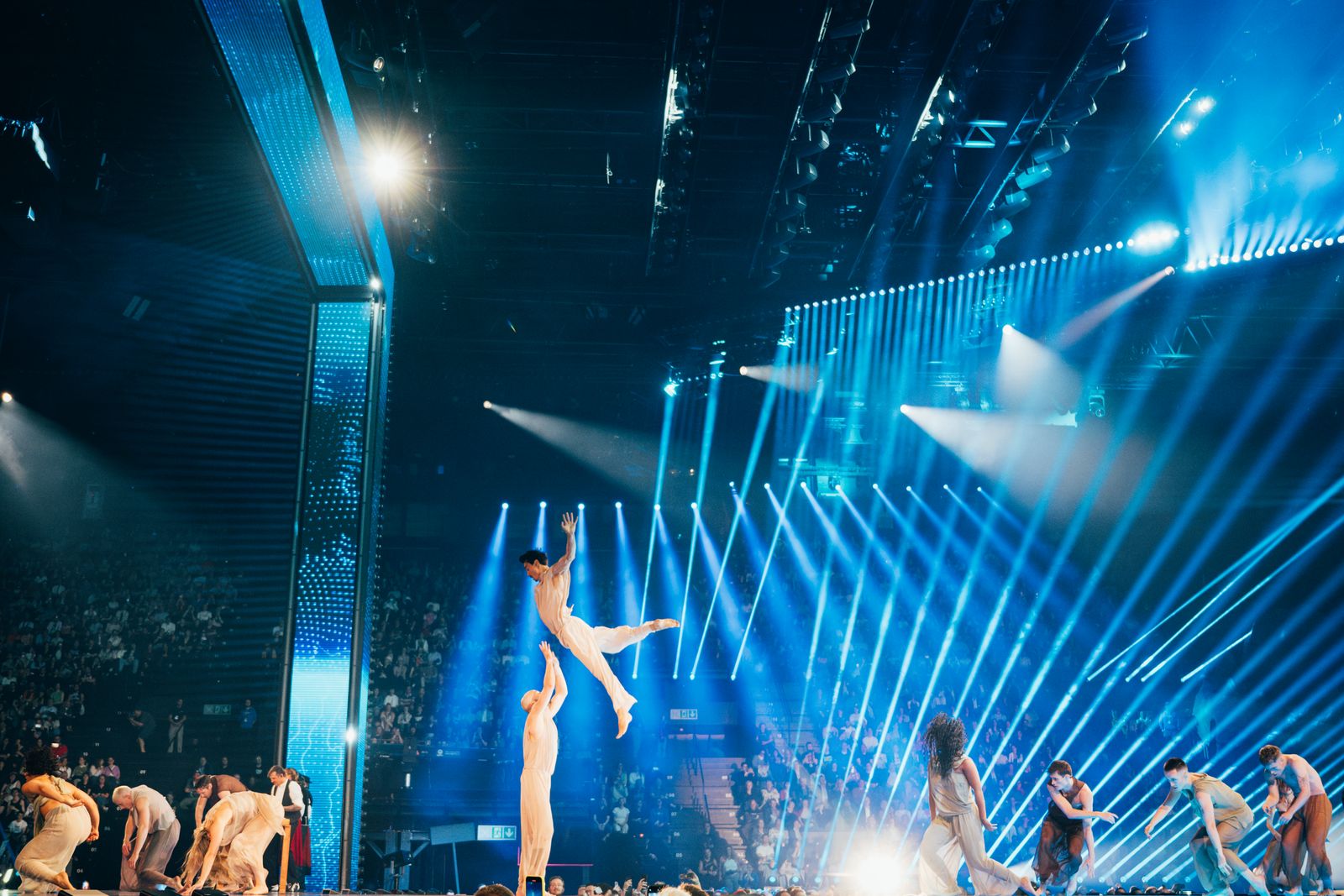
Why is scenography so important in a TV show?
Florian Wieder : Eurovision is a quiet complex show. So, you must make it right in an ideal world for everyone. The scenography is super important because it’s giving to the show an identity in a way. But there is so many other thing that have to work when you are doing it with an audience.
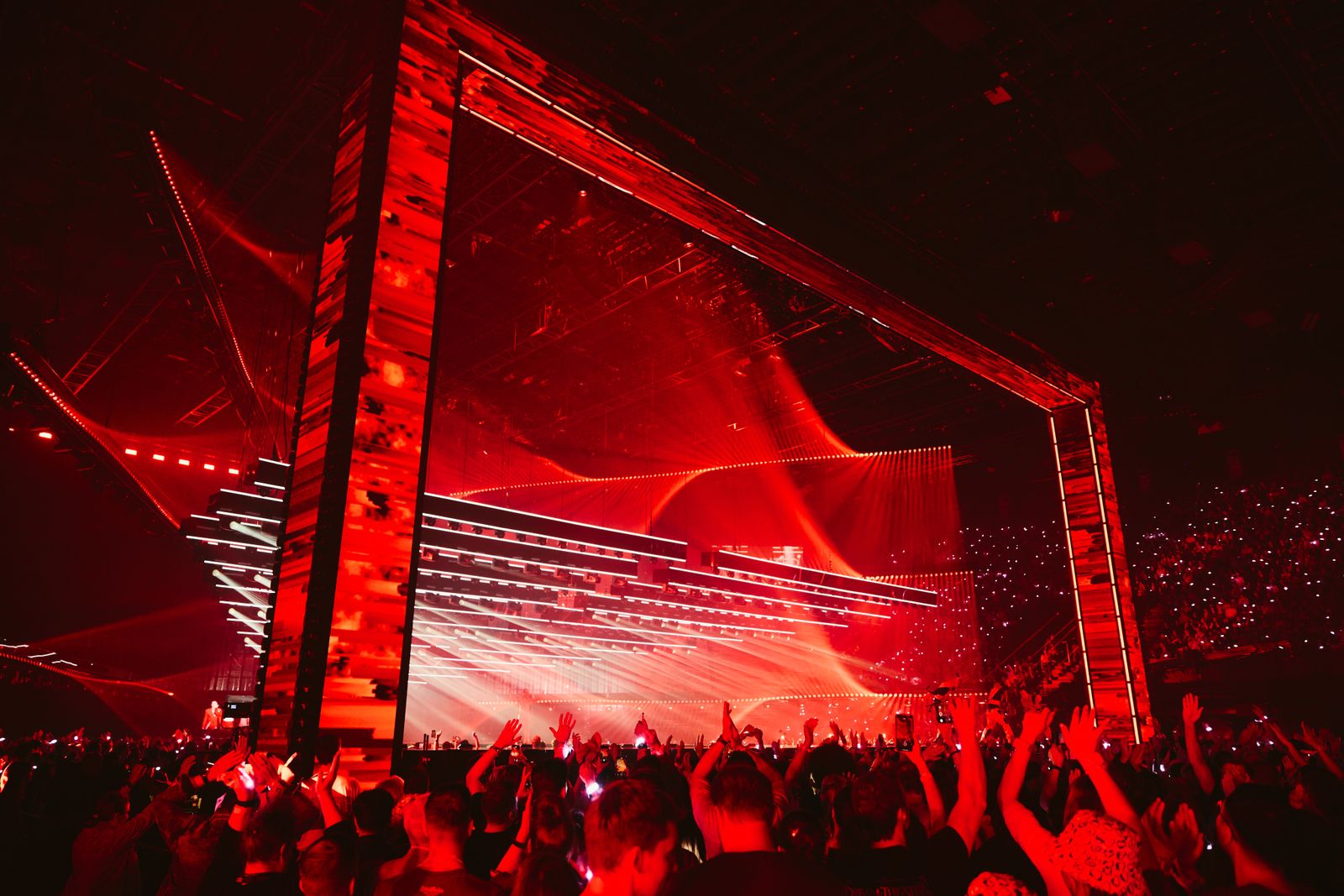
One of our most important goals is always the connection between the fans and the talents. Because you have fans on every show but here, they are very enthusiastic. And just bring them as close as possible to be together. This is something super important on TV.
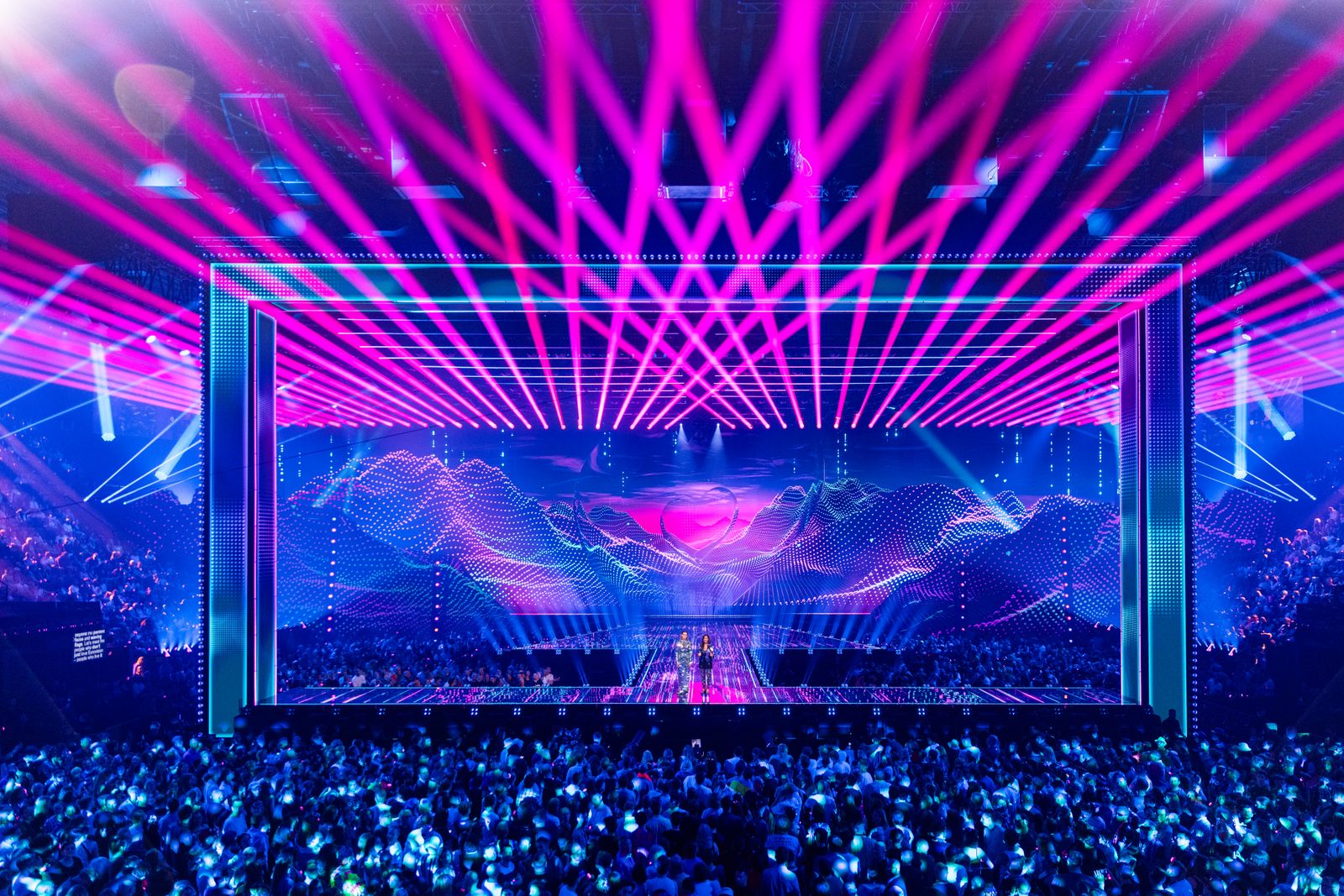
So, we create the entire footprint, for example, with this pocket. You always have people in the foreground. You always see. It makes it easy for the director to show this connection between audience and talent. You can of course use the audience, if you don’t want to see it, but one important part of the concept is that you get this energy in the room someone captured on camera.
Interview in the St. Jakobshalle Basel of Eurovision 2025 on May 14, by Vincent Laganier.
Interview with Tim Routledge, lighting designer of stage lighting
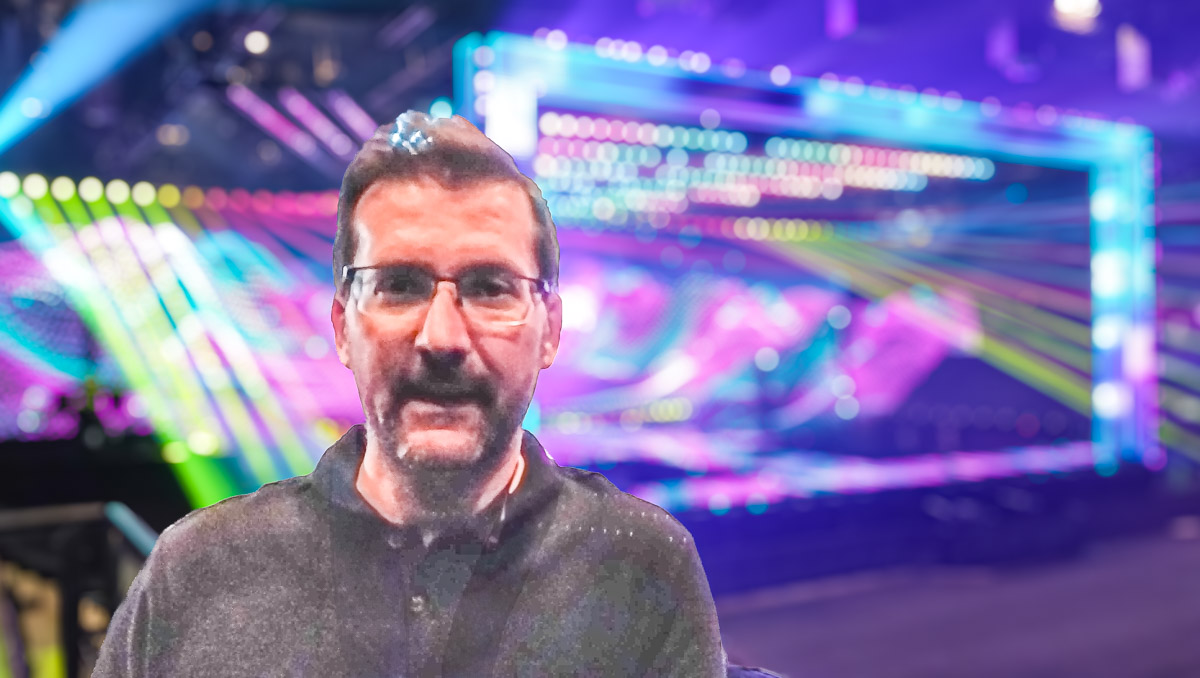
What lighting effect do you create for the Eurovision show?
Tim Routledge: I am creating every single look of the show. We start with start with the set, the Florian design. It’s my role is to integrate lighting and makes the set works with light, make it work on camera and make it work for all the performance. Every single performance is different.
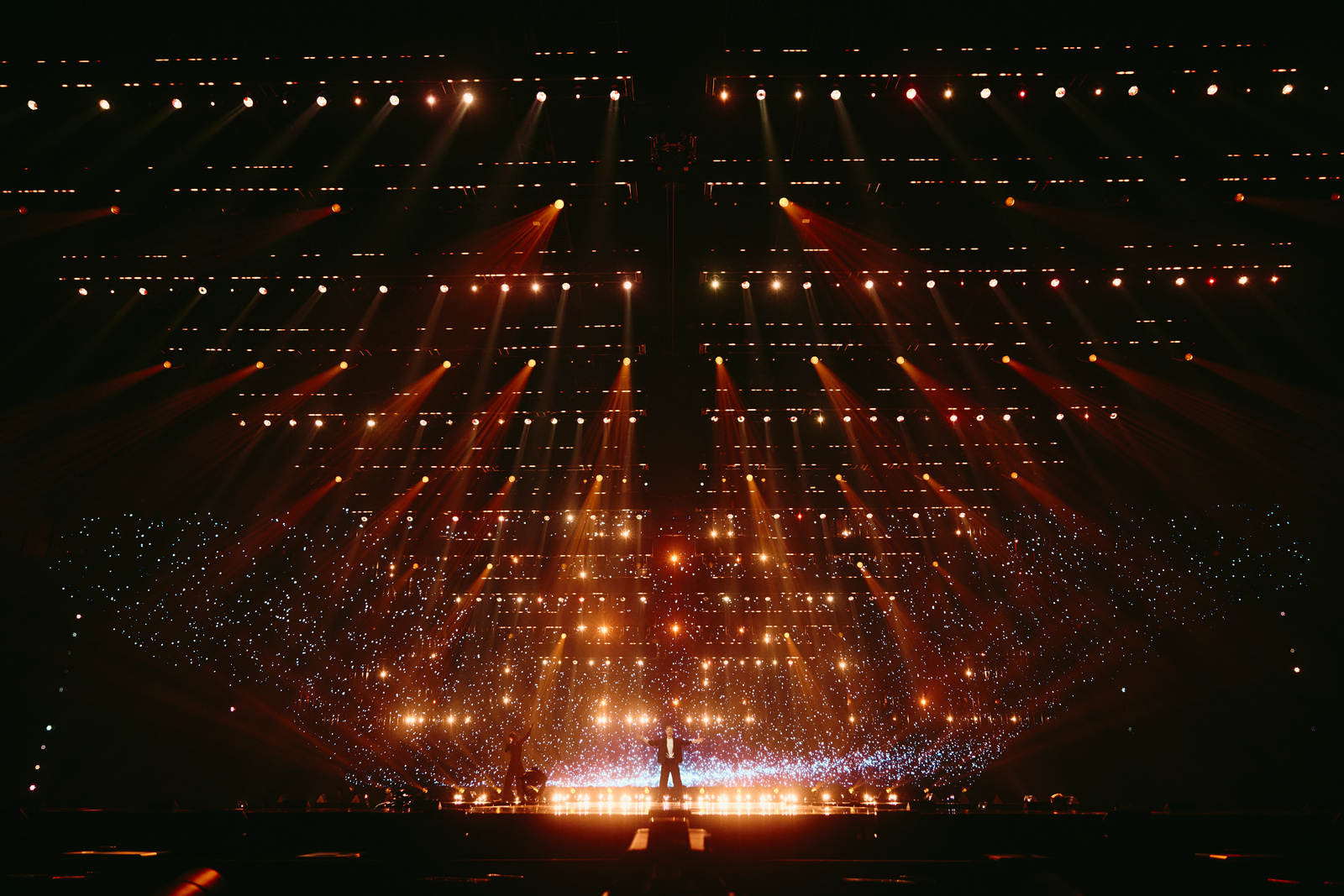
We are in small venues for this Eurovision usually. We are virtually going spreader in this small room. We must find a lot of different way to change the architecture of the reach of every performance.
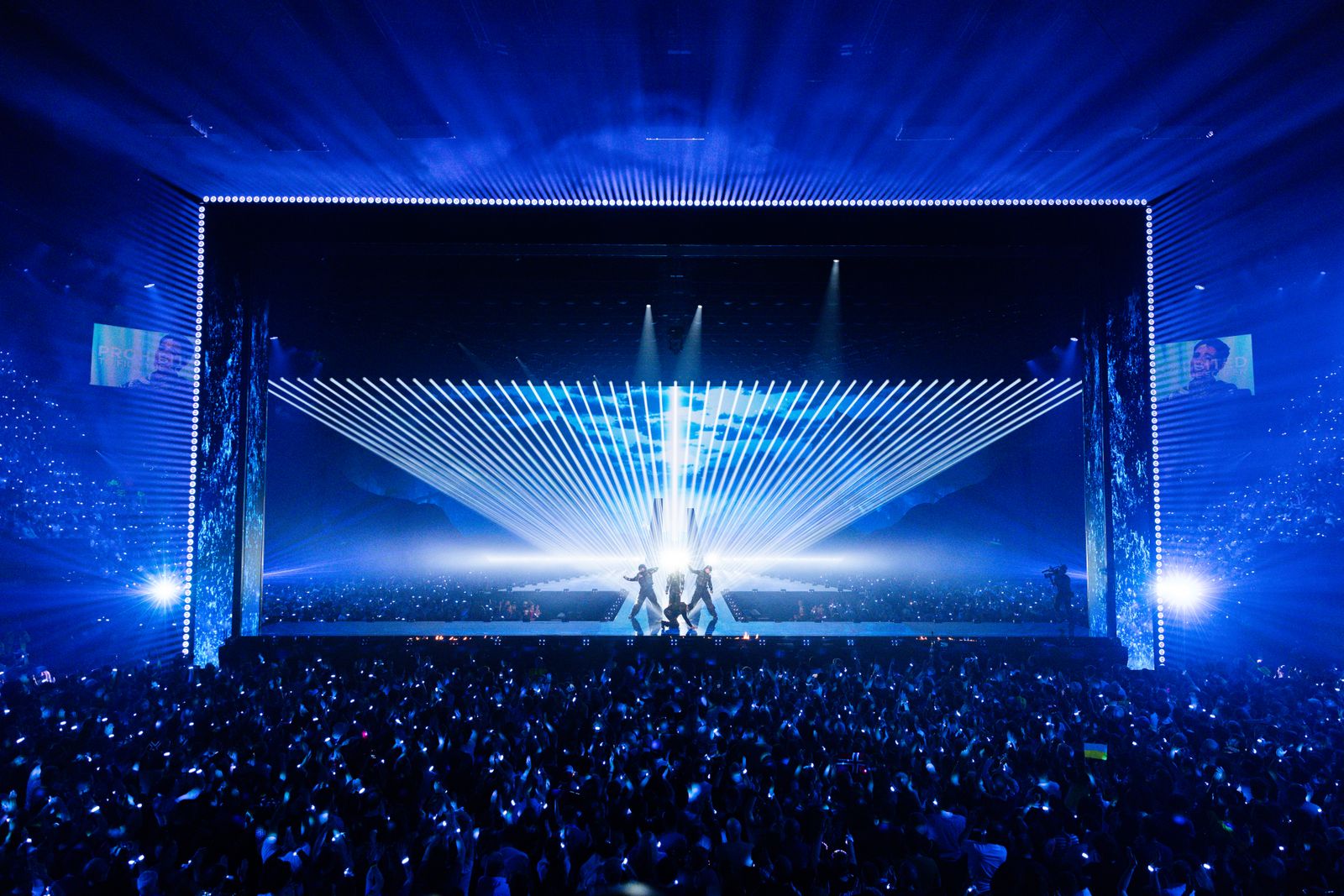
How do you incorporate light into the scenography?
Tim Routledge: Yes, there is two mains’ elements with Florian design the frame and the 3D-grid. Florian has the concept in 3D-grid and the frame. And we talk together length we can put it there. I wanted to put this type of power strobe here and the moving lights in between. We will do that together and how much we can get in there. We didn’t just the previous frame that was, video only, because it gets boring. So, what’s light I like, there is hidden there.
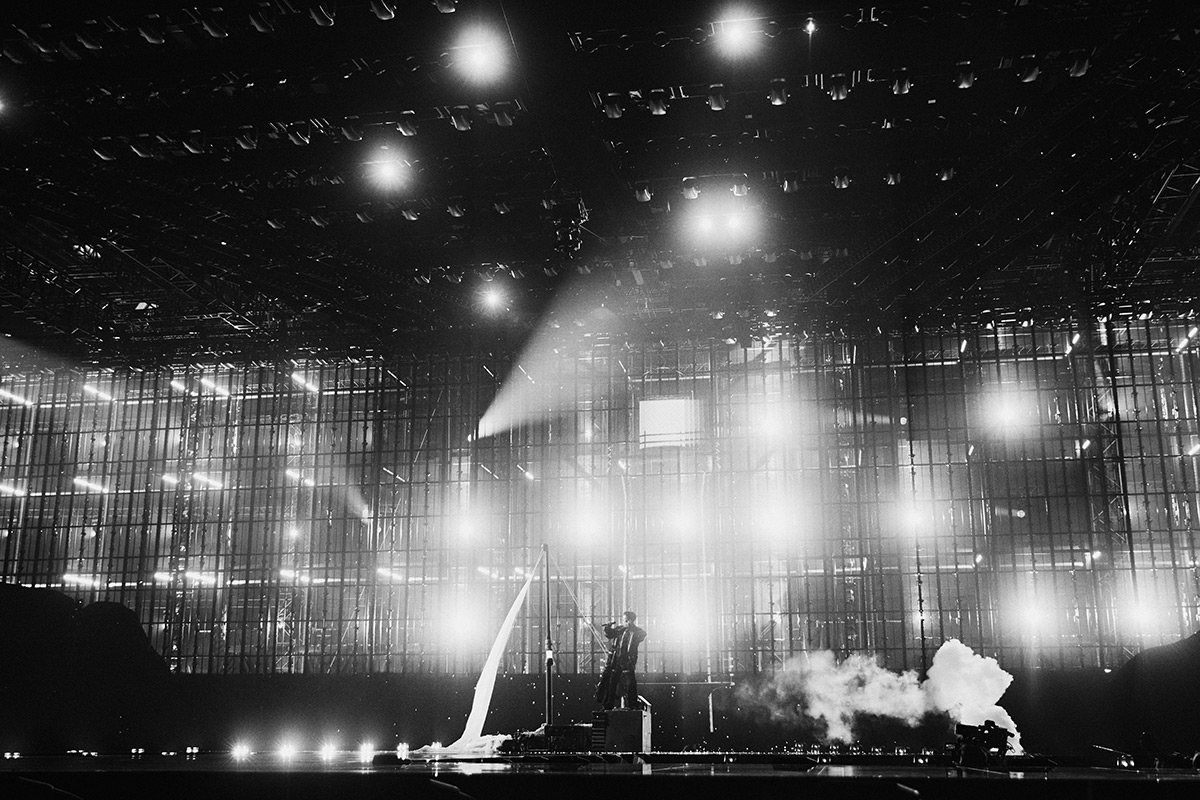
The next part of the ribs is what’s happens between the screen and the frame, and my real estate. My place to fully play. We put the thirty trusts that move, call the ribs, they create and come down during the show. We have 24 ribs. They are split in the middle, so they can travel through. They can move in any speed, angles and twist and turn.
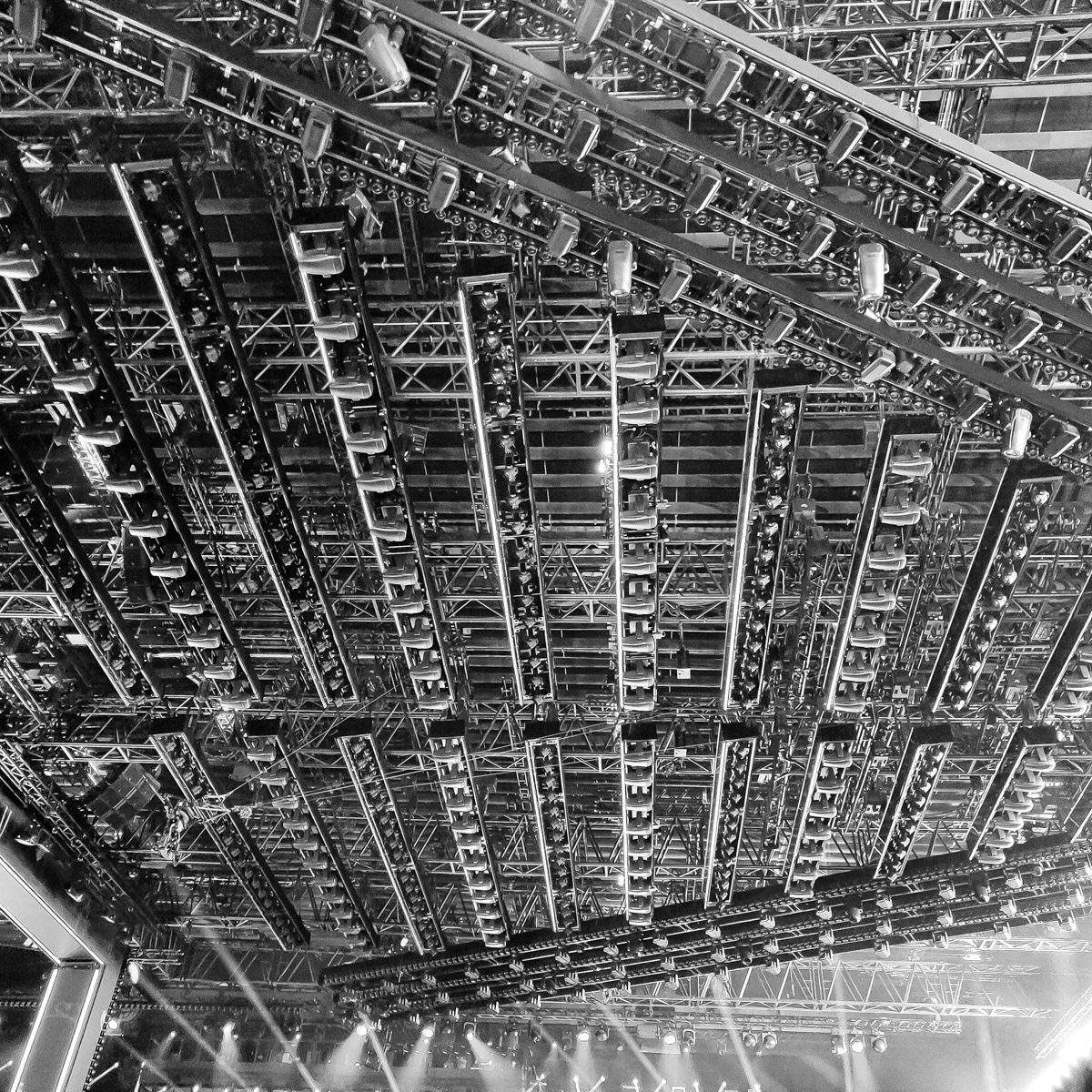
There are also some positioned on both sides of the stage.
Tim Routledge: We also have the 6 long perspectives. They run from the front to main screen.
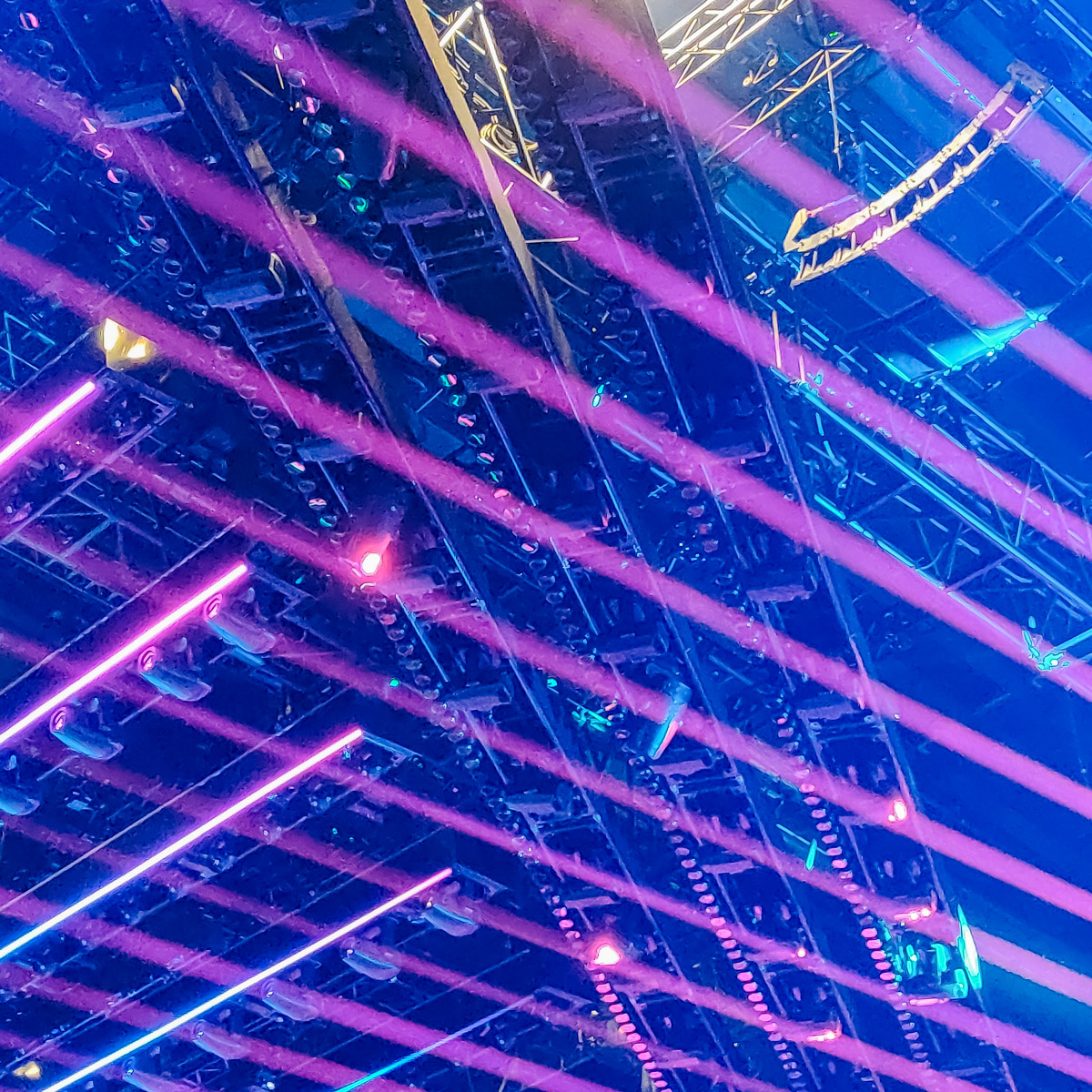
We just bring those things and that just bring your attention to the stage. So, it makes a cage run almost.
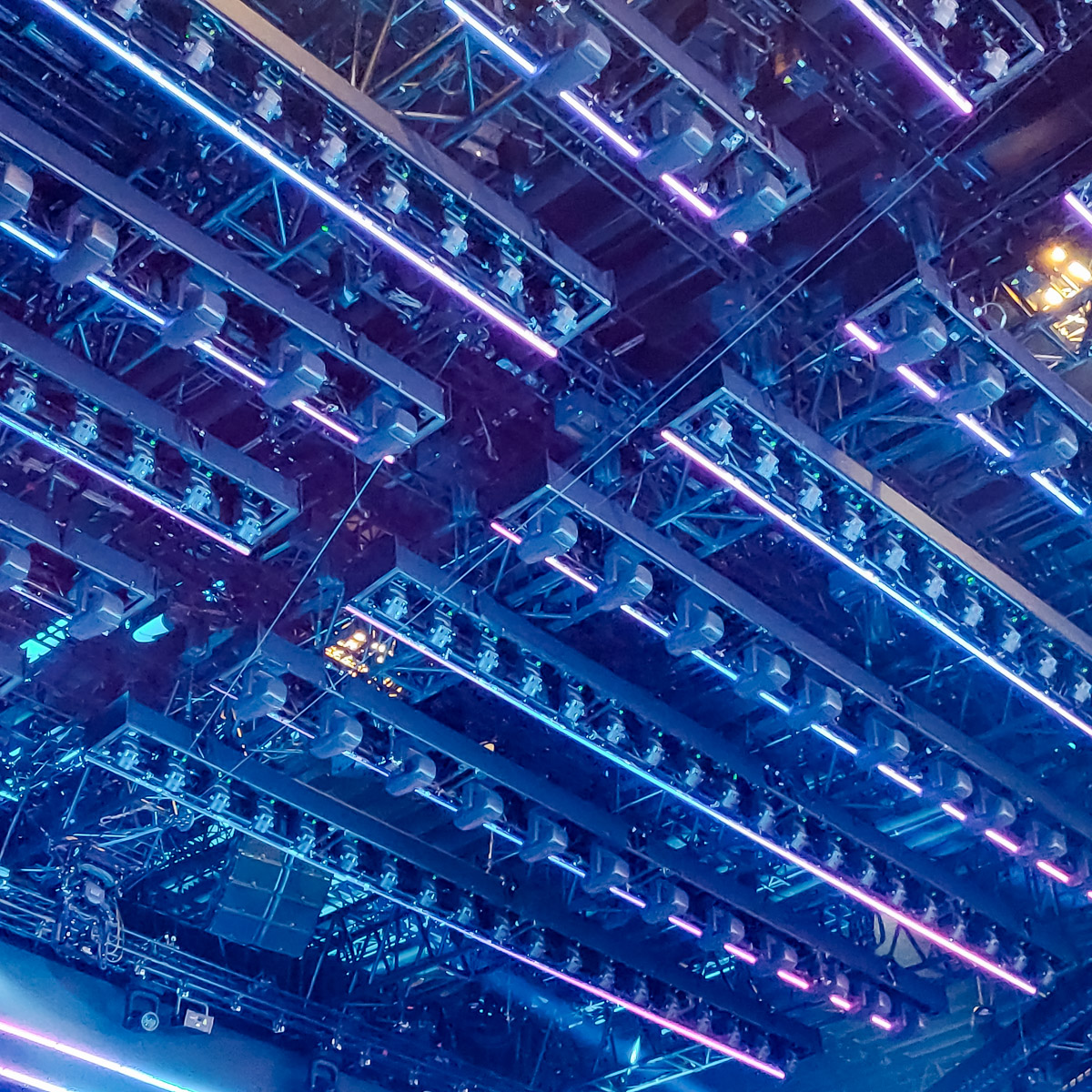
All the lights above the stage floor, they are lifts as weel. They can come to 0,5 meters.
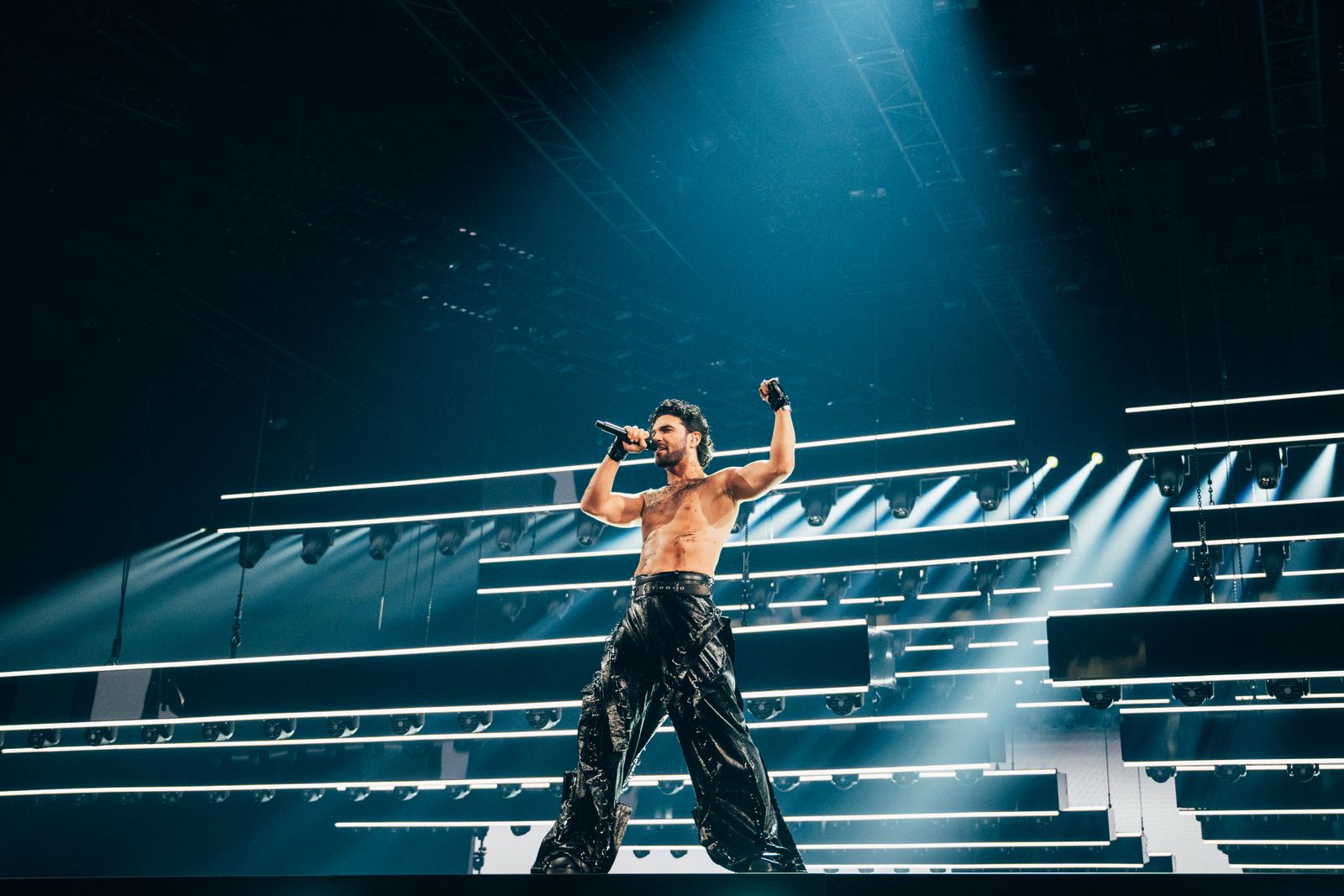
So, we can hide the lights bring they a little for dance or make it cool and do rock style. They are quite a lot of things that moves.
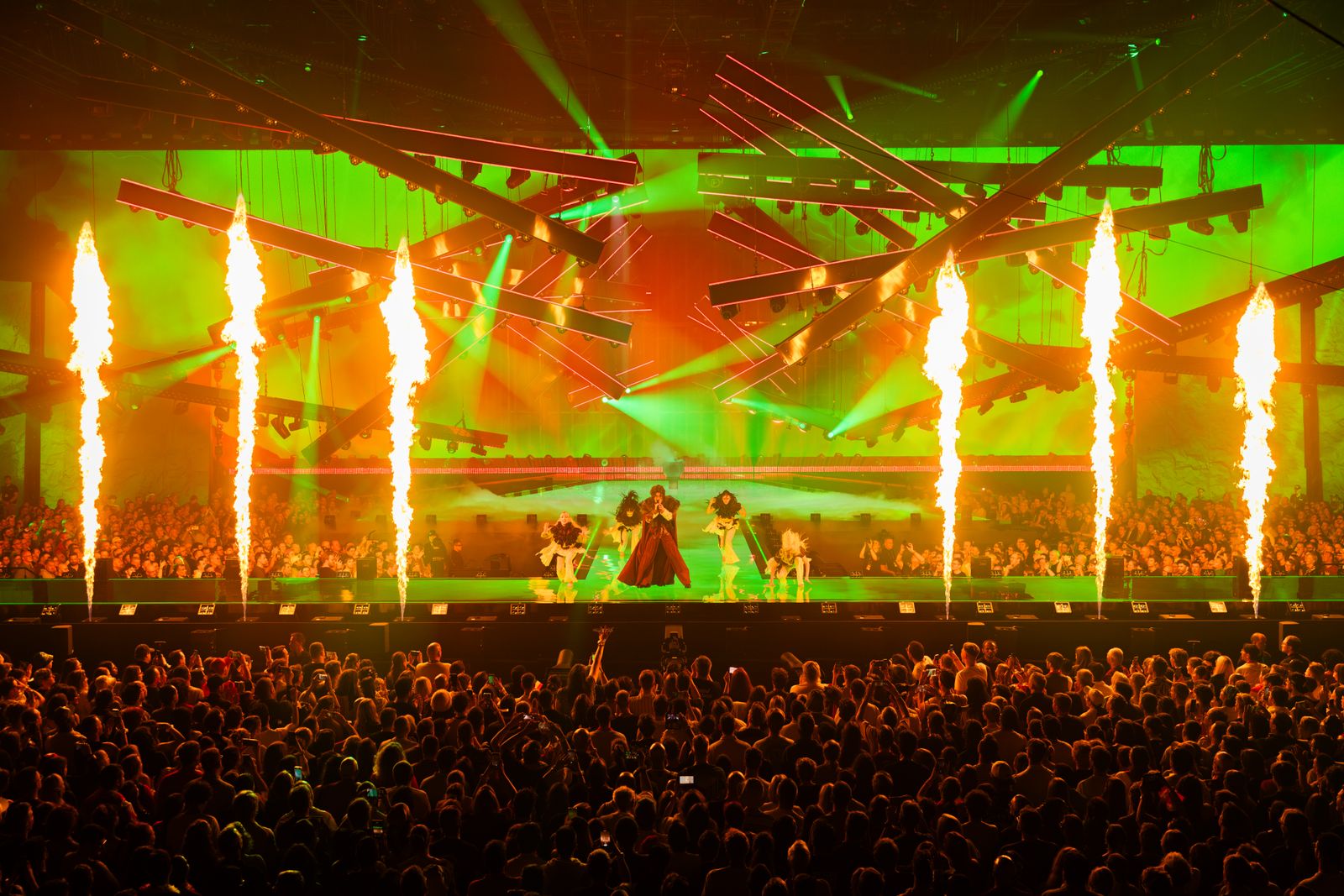
Qu’en est-il du cadre de scène ?
Tim Routledge : The frame is lit with Tornado. Each fixtures have five heads inside.
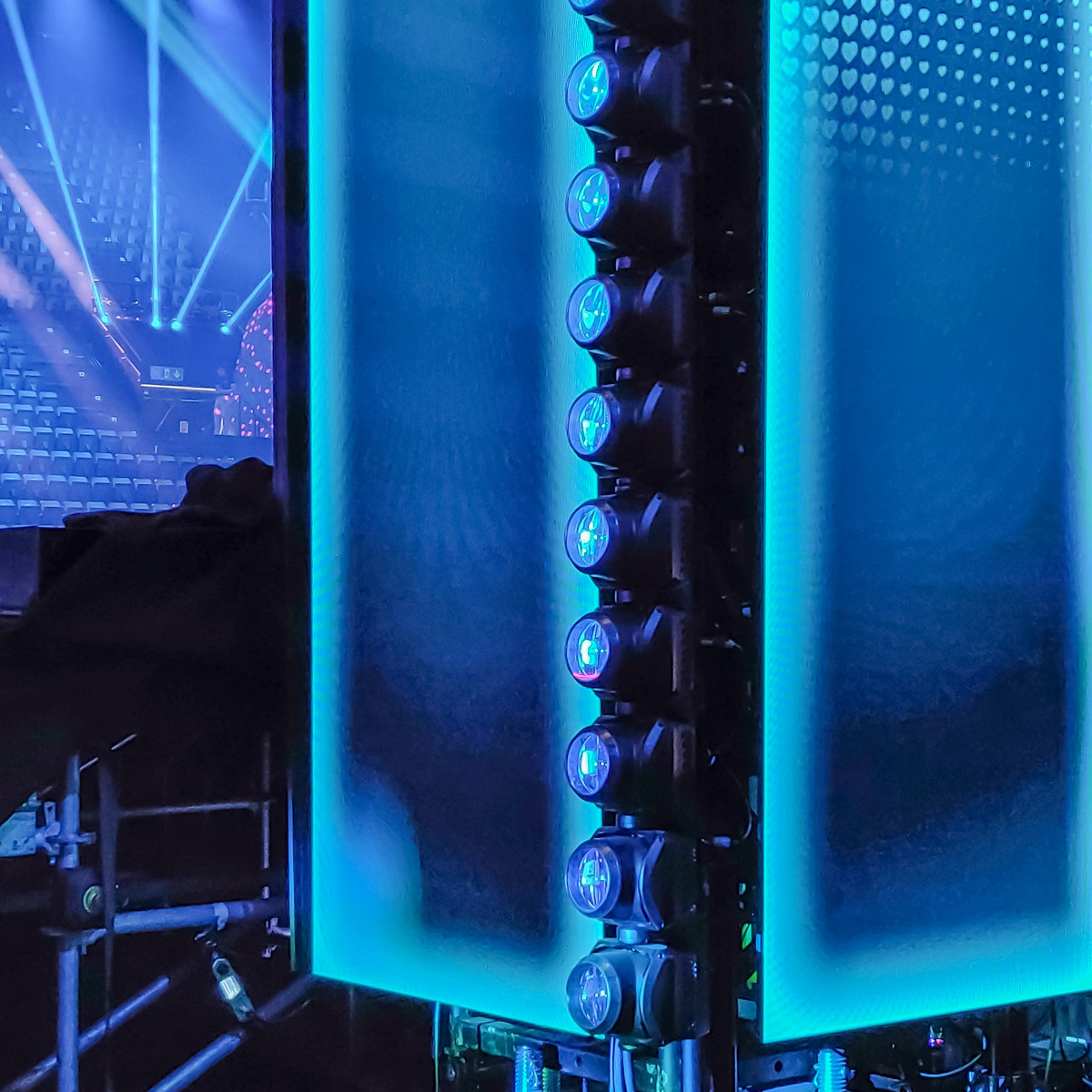
Edge to edge, all the way around they create this “Portal of Light”. For the activation shot, they create the job. We use it for dressing this light tunnel. So, we have them in front and back, that we can make reverse shot that you can see each side.
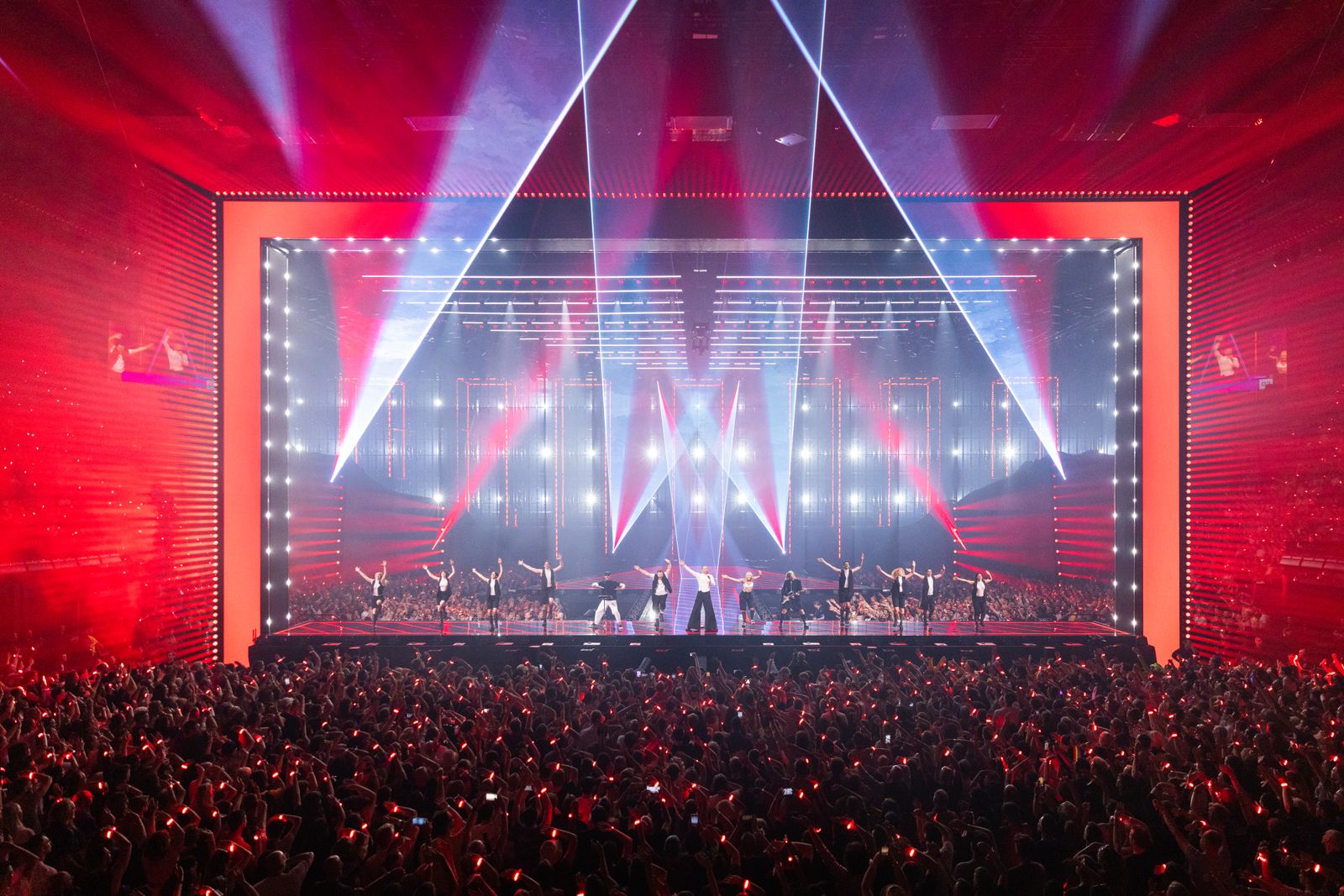
And we have embedded pixel lights. This is the same strobe that we have for the 3D-grid. That the ones that are vertical insight that frame that just change colours.
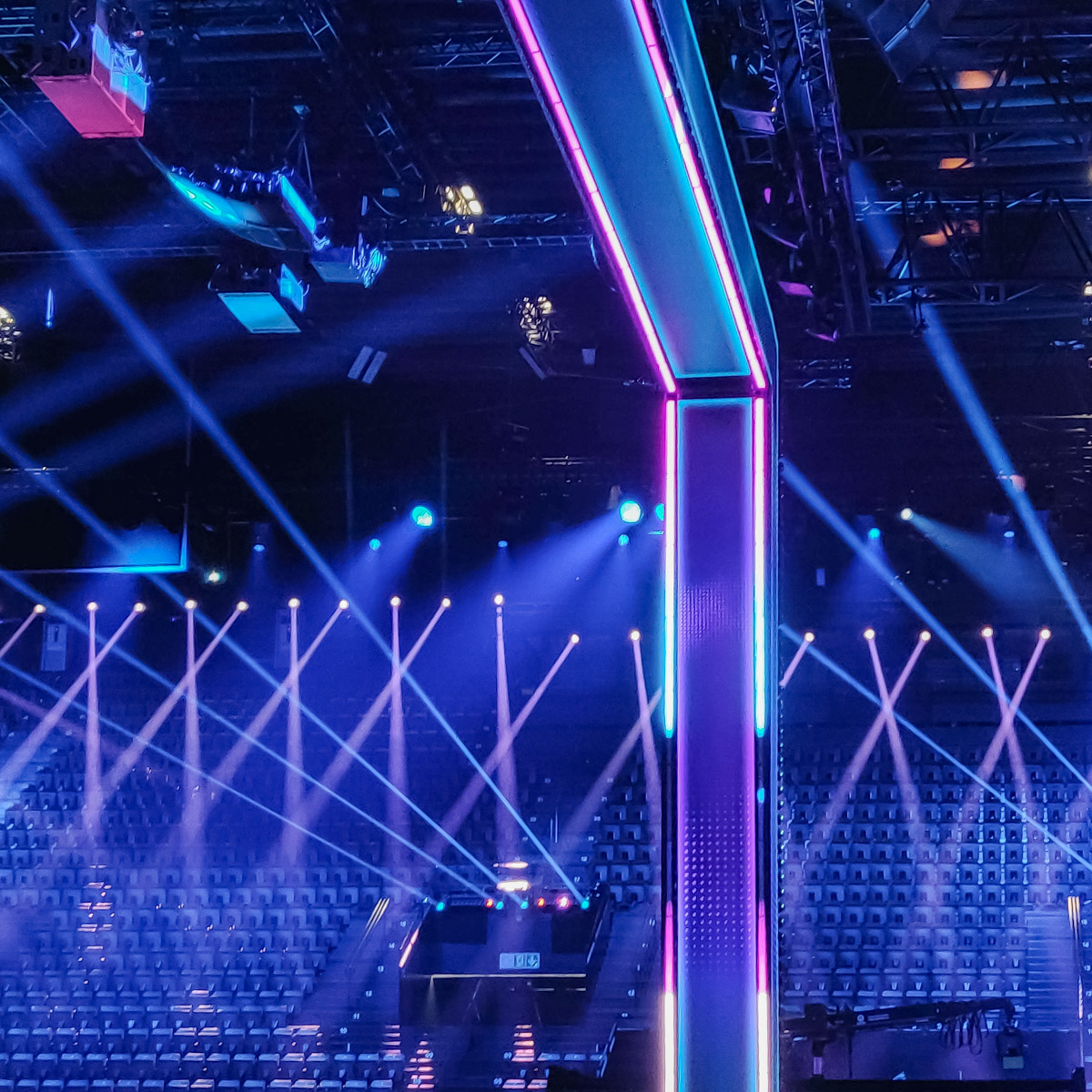

These Tornado, we have also on the perspectives so we can do this cool stuff. When you have hundred in a line, we can do this cool wave and like to ocean staff.
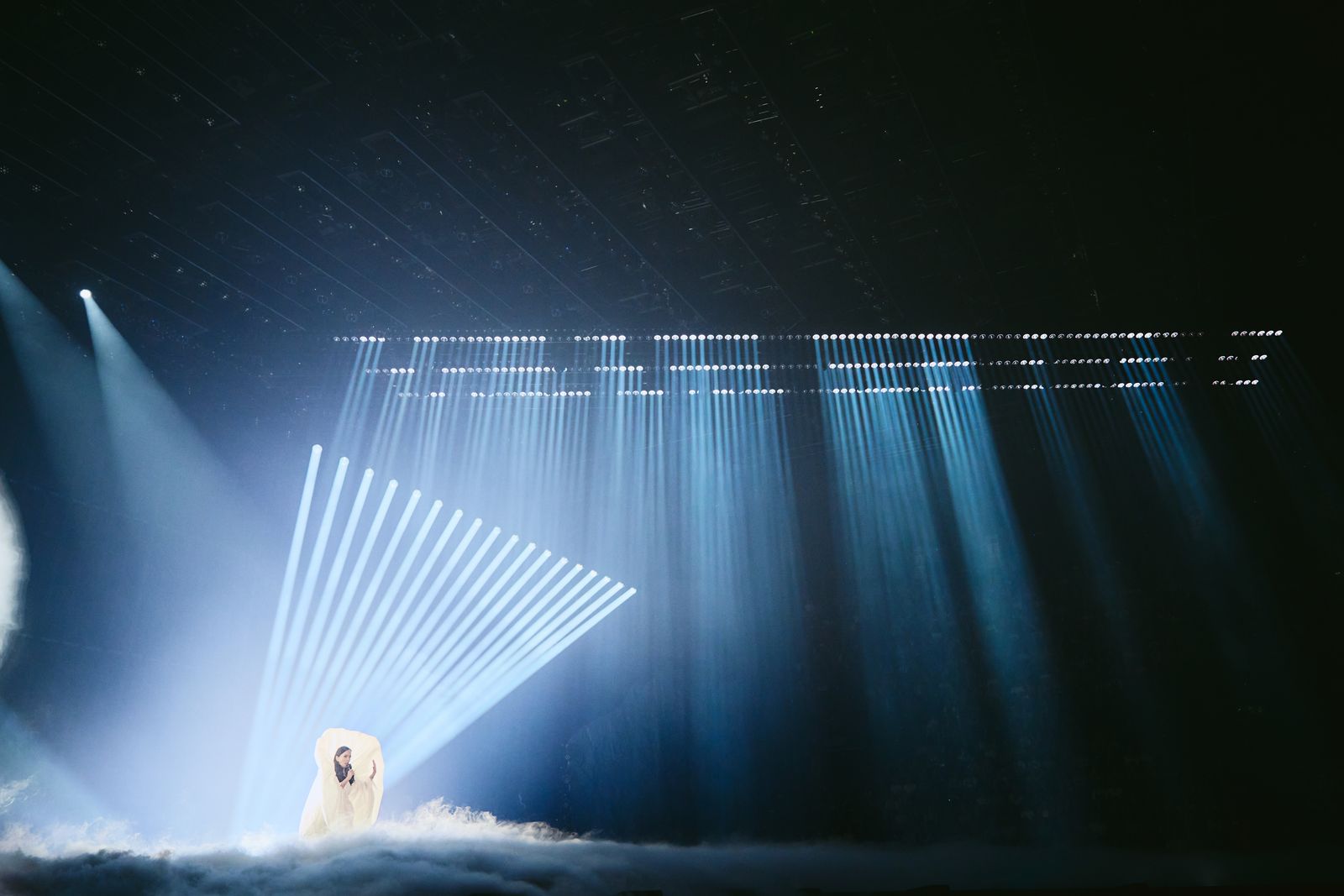
The ribs also move during certain songs.
Tim Routledge: There are no fix lights. Everything single one has pan and tilt. [N.D.L.R. 360° pan and 180° tilt].
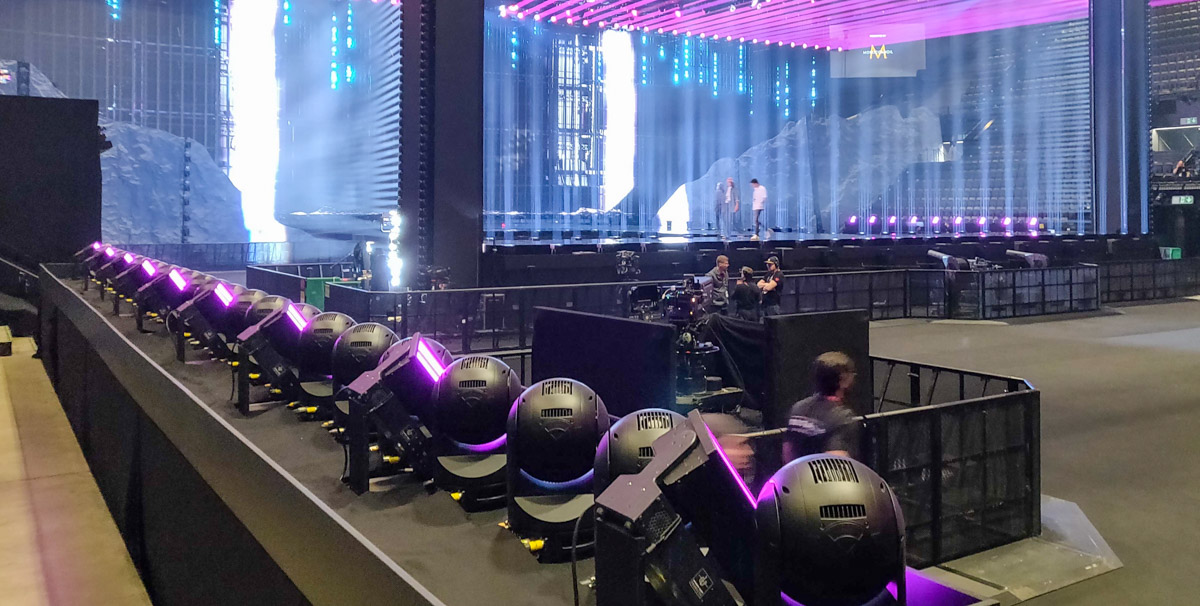
Are all the ribs composed of the same lighting?
Tim Routledge: I think there is three hundred of those patterns and each are five individual lights, and each can pan, tilt, change colours and zoom size to narrow to wide beams individually. This means that when you have 300 of those, time five, you have 1500 lights just, that mine, it’s mad!
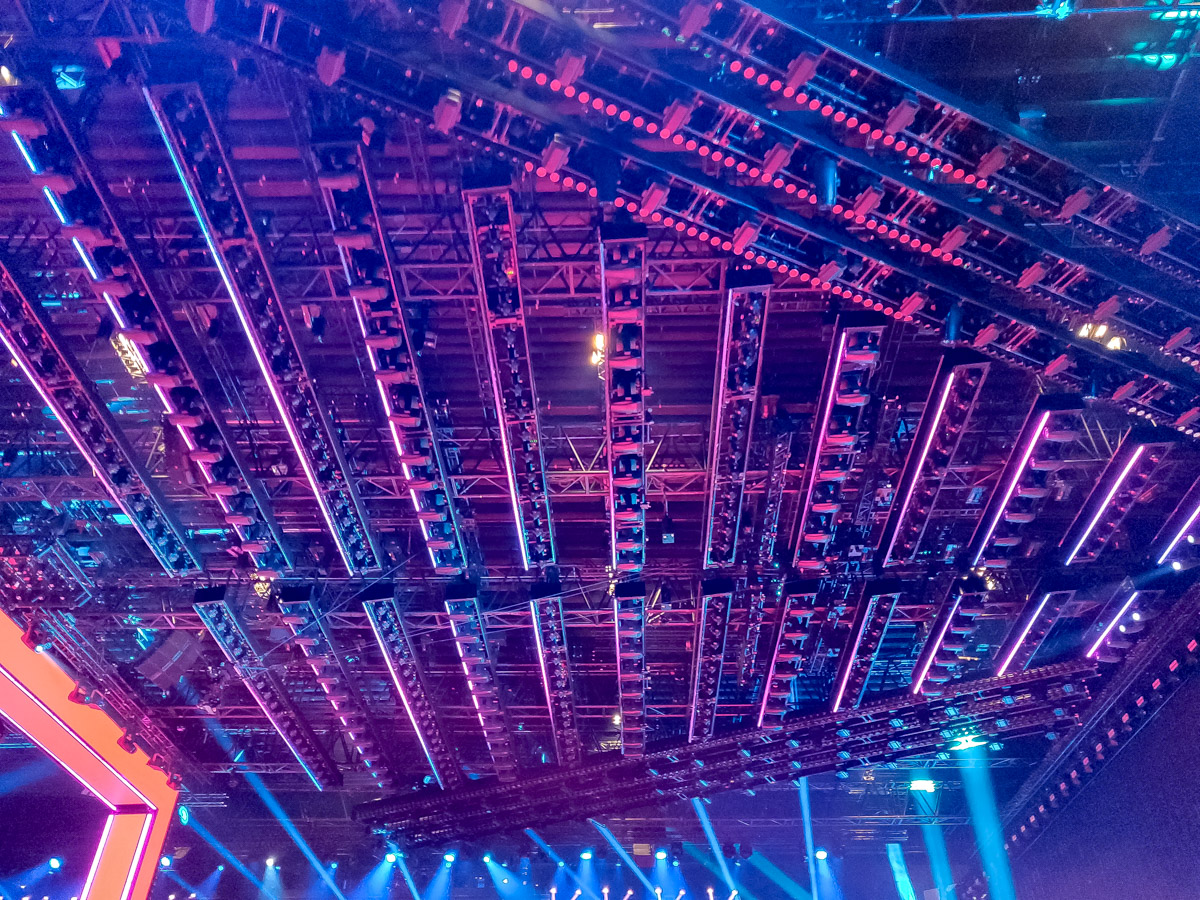
There is also a line on one side of the ribs.
Tim Routledge: They are pixel lights you have that in the grid and the frames is well. They are high power strobe, two lines, and in the middle high-power white. So, you can do cool and clean strobe space.
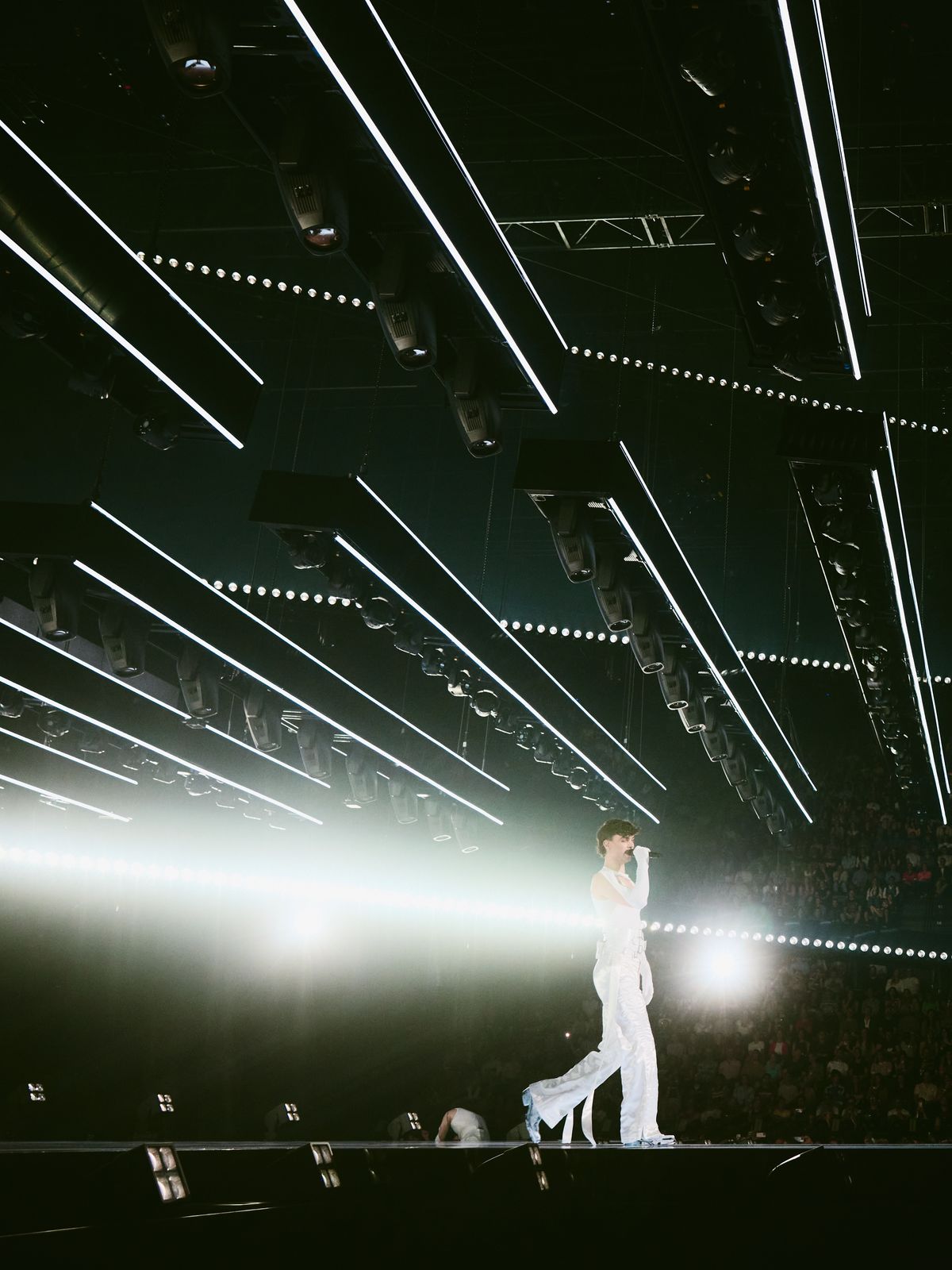
How are the Swiss mountains illuminated?
Tim Routledge: The mountain is to like a physical object. In it’s a home stage, you have the physical mountain and the digital mountain on the screen as weel. That, it can give you two layers with the video content.

In front of the physical ones, video projectors projecting their protection map onto the front of the mountains.
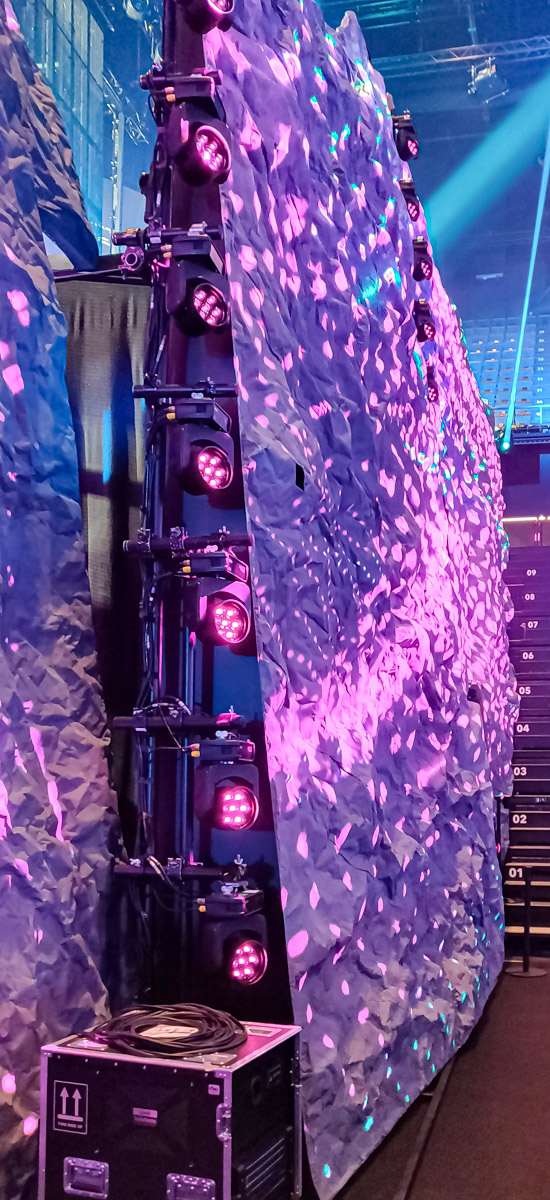
We have also embedded a punch of light as well. That we have whole rig behind those mountains. That we have all age last night with the big volume of light coming avec le top to make feel more three dimensions.
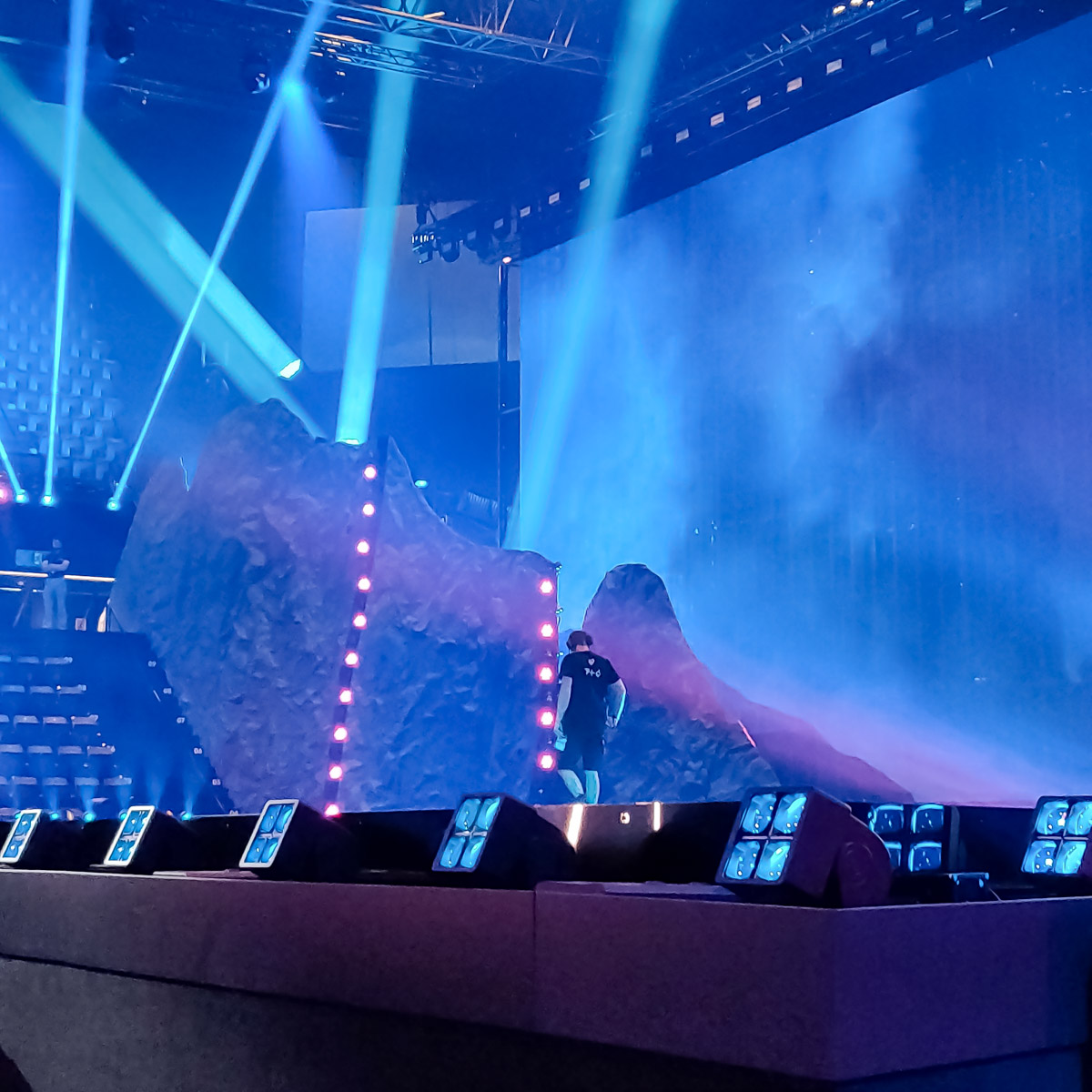
It’s also used to hide things backstage. That means, they have two purposes.
How large is the stage lighting control system?
Tim Routledge: We’re creating a huge playground of light with 4,500 lights. With 850 Universe channels, we are the largest lighting control system used on the show.
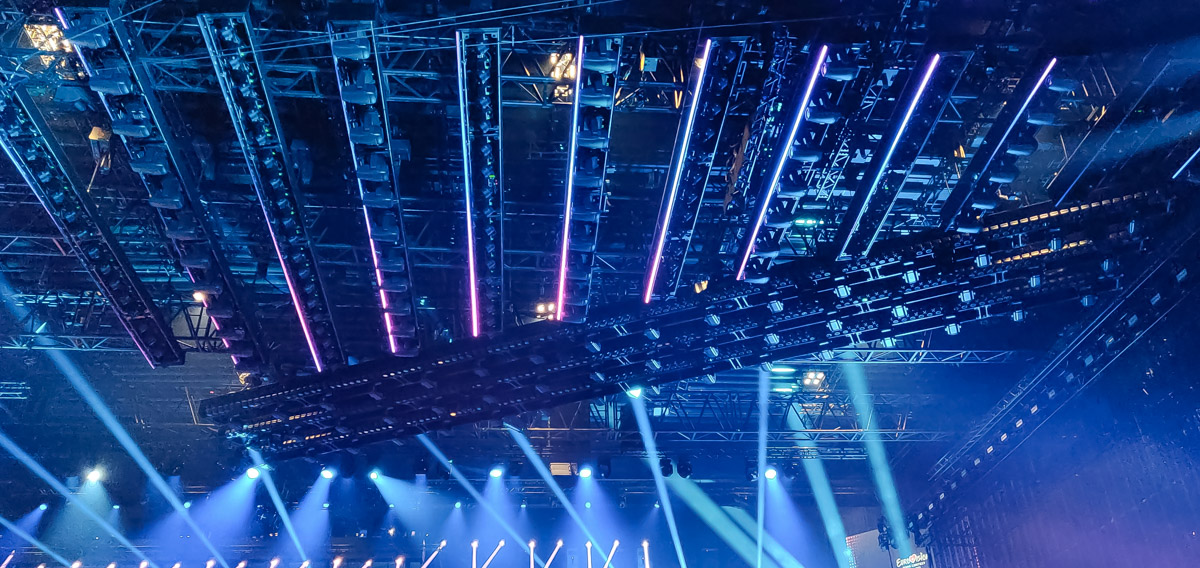
What projectors are you using for the stage?
Tim Routledge: We have a lot of Claypaky Arolla Aqua. Robe iForte due to the change of the faces. This the nicest light on people and on camera. Robe SVB1. GLP Creos which are brand new. A lot of Ayrton Kyamami, ACME Tornado, Claypaky Sharpy X Frame.
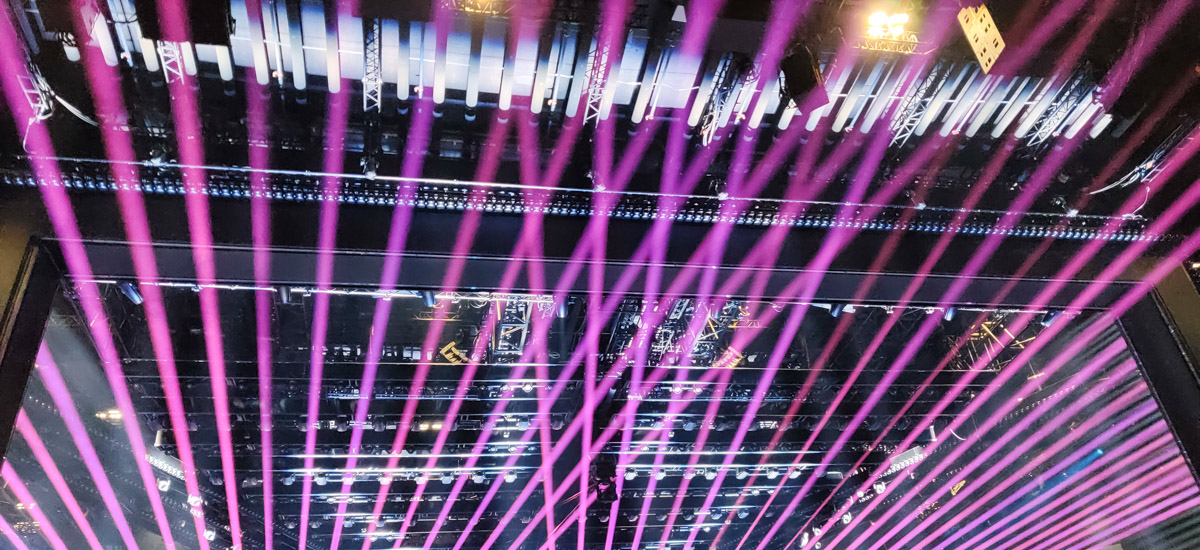
How do you select the projectors?
Tim Routledge: Lighting supplier from London provides all the equipment’s. We have also some technical partners in Ayrton, ACME, Claypaky, GLP who supply few equipment’s free of charge. Part of the ribs have been supply as a sponsoring type.


What type of screen is used as the stage background?
Tim Routledge: Roe Vanish screen which is a semi-transparent screen. It’s 8,9mm pixel pitch, this means the screen disappearing. It’s shown all the light from behind and make the screen 3-dimentional. We do a lot of things where we are driving content through the light with pixel maps with an entire wave of light using video content.
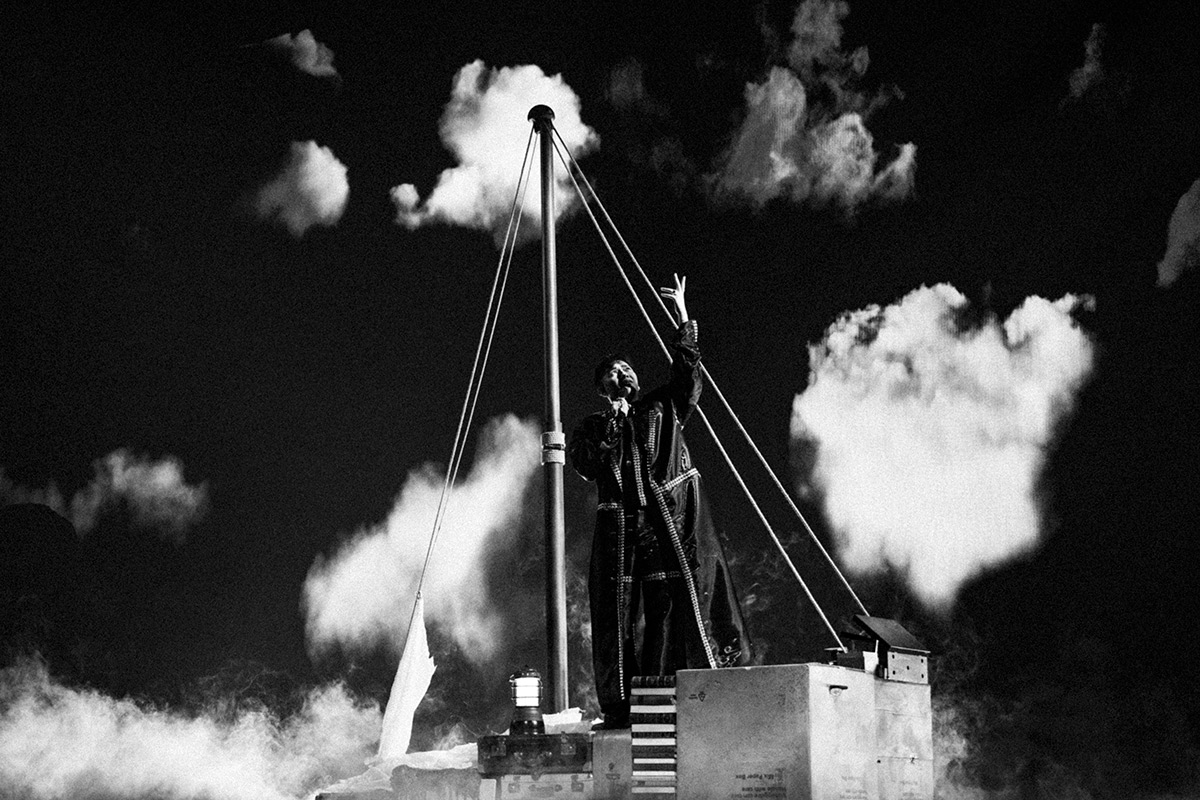
What type of lighting song do you prefer the most in your designs?
Tim Routledge: Sometimes it’s one’s with fewest of lights. Austria performance is beautiful. Very theatrical. France is very theatrical.
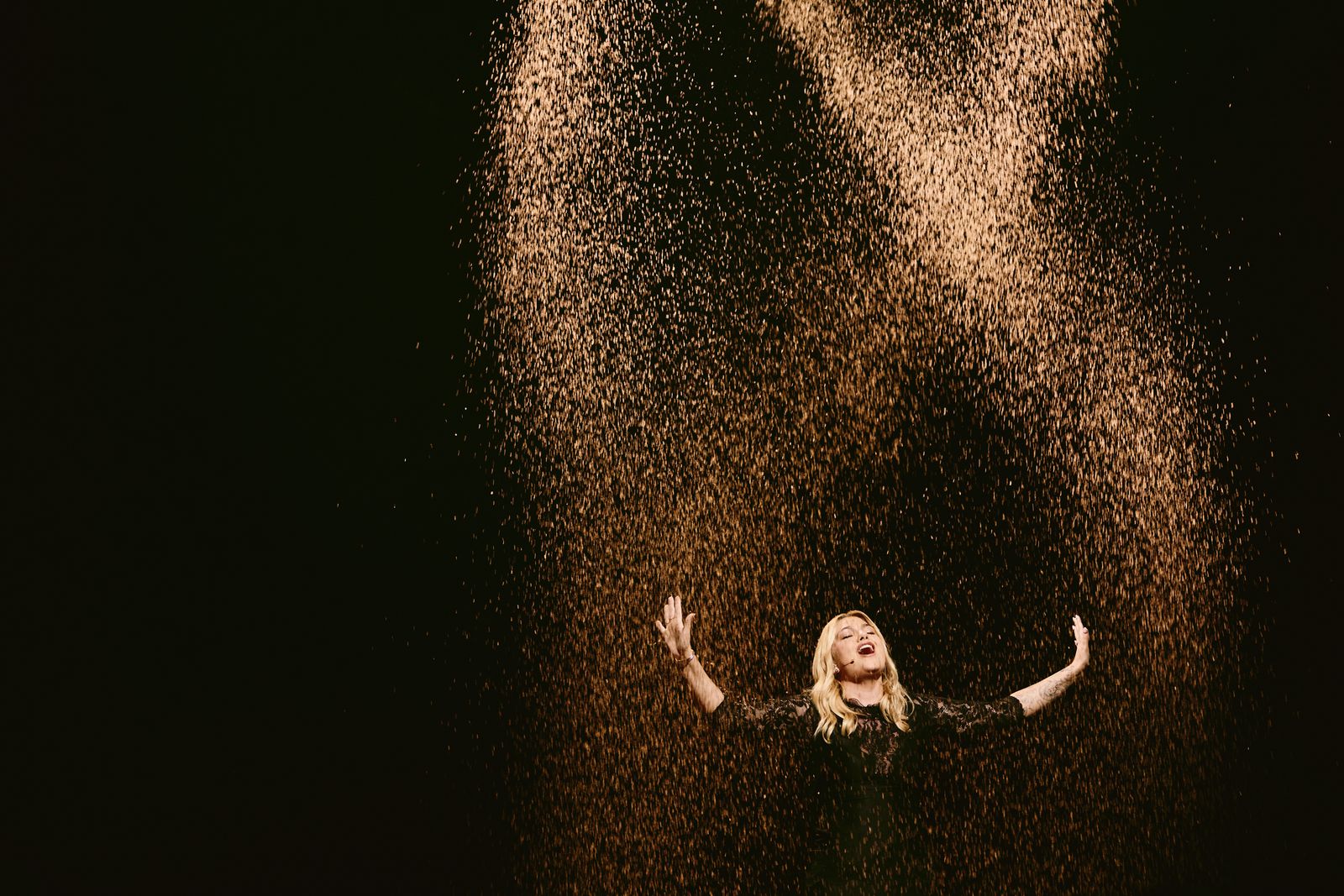
Sometimes, it’s the performance where you turn everything off. So, we have 4500 lights, but we don’t use them all the time. It will be too much and crazy. So, it’s nice to have these moments where you just take six lights and you go for nothing, and it’s so cool.
Why are there so many tracers of light in the show?
Tim Routledge: They are crisp and punchy on camera. And they give you a lot of negative space between the beams. The beam is ties.

They were a big trend about ten years of always use beams. I like a mixture. So, we tend to use a hybrid beams. We could also do big gobo or big floodlights. We like to use fixtures that can do more than one thing.
Interview in the St. Jakobshalle Basel of Eurovision 2025 on May 14, by Vincent Laganier.
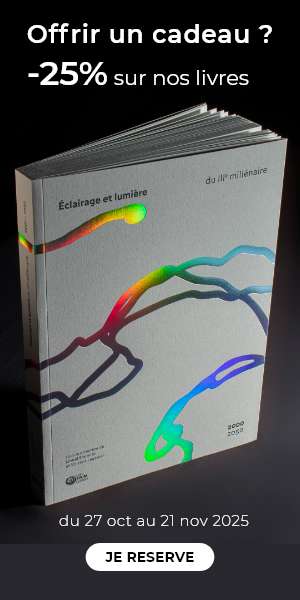
Dimensions of the Eurovision 2025 TV set
Stage frame
- Width: 24.2 m
- Height: 14 m
- Depth: 1.6 m
Height of the stage space
- Stage height: 2 m
- Height of the lighting bridges: 14 m
- Height under the roof of the hall: 17 m
- Dynamic height of the lighting bridges in relation to the stage: from 0.5 m to 12 m

Parallelepiped main stage
- Width: 14.8 m
- Depth: 13.6 m
- Height: 2 m
Scenic walkway to the frame
- Length: 8.5 m
- Width: 4.8 m
Secondary stage under the frame
- Width: 3 m
- Length: 24.2 m
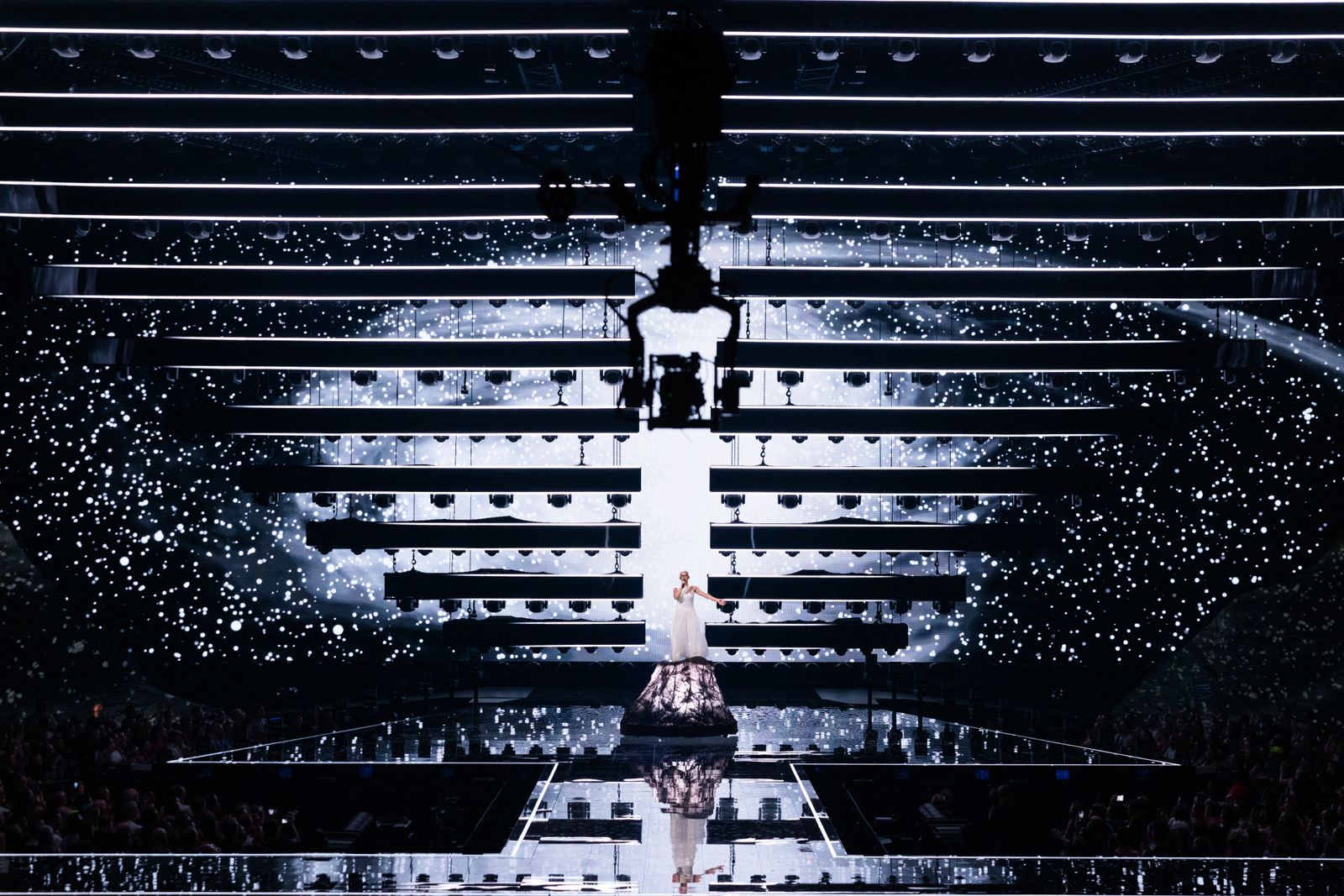
Mountain scenery
Both sides of the stage
- Width: 23.5 m
- Height: 9.3 m
Stage access ramps
For singers and stage probs
- Width: 3.5 m
- Length: 14.3 m in two flights
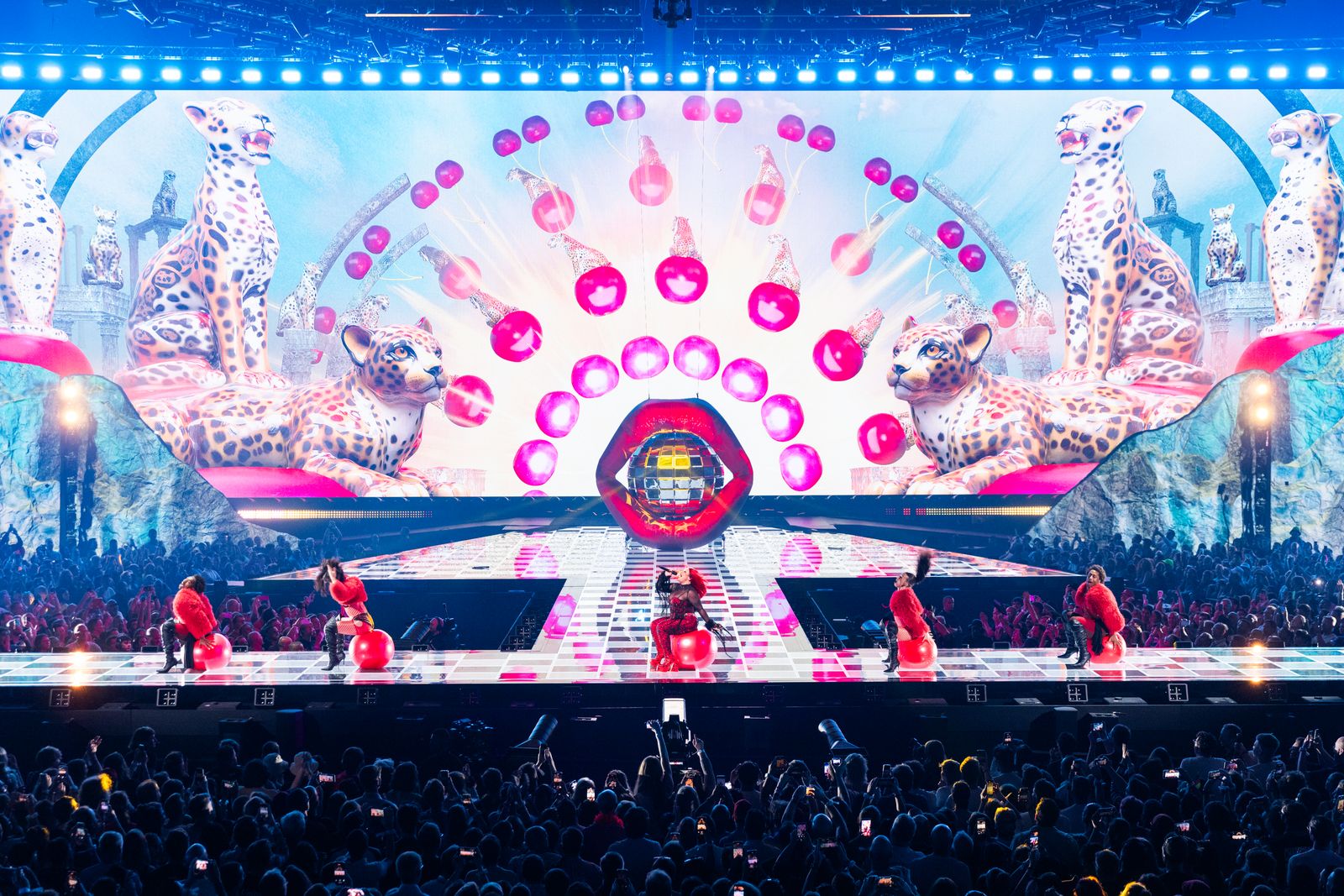
LED screen at the stage background
- Width: 48.4 m
- Height: 11.6 m
Light grid behind the LED display
- Depth: 2.6 m
- Light frame: about 3 m
- Light cube for opening TV screen: 7 x 7 m
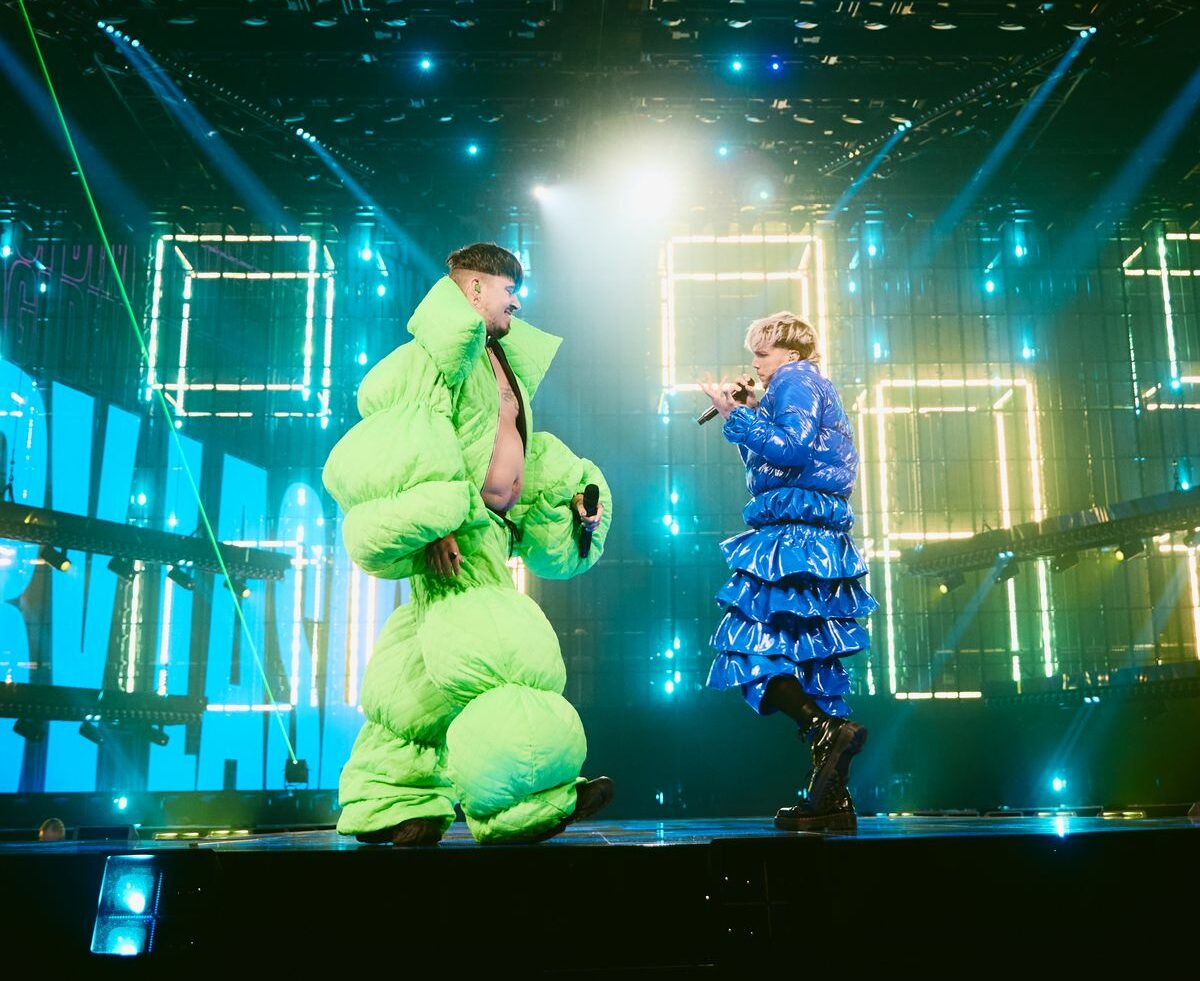
TV production and broadcast figures, Eurovision 2025
- 22 broadcast cameras, including 7 wireless and 2 overhead systems.
- 4,500 luminaires using mainly LEDs and lasers.
- 16 video projectors for video mapping on the mountains.
- 330,000 lighting channels.
- 2 km programmable LED strips.
- 15 km of scaffolding supporting the stage.
- 8 km of fiber optic cable feed the show.
- 8 km of IP cable for computer transmission.
- 42 seconds for stage prop changes.
- 30 stagehands and prop masters.
- 5 weeks of pre-programming for the lighting design.
- 100 pyrotechnic fire points.
- 8 types of special effects integrated into the scene.

- 2000 m² of stage space.
- 750 m² of LED video wall.
- 200 m² of LED flooring.
- 350 m² of mountain scenery.
- 150 loudspeakers.
- 100 wireless microphones.
- 250 earbuds used simultaneously.
- 450 radios.
- 160 intercom panels.
- 90 Bolero mobile units connecting the team.
- 250 people for production, 24 hours a day, 7 days a week.
- 3 TV shows, 2 semi-finals and 1 final of the song contest.
- 6 rehearsals and spinning.
- 6,500 tickets sold per show to fans in more than 83 countries.
- 35,000 tickets sold at the adjoining St. Jacob-Park football stadium on the day of the final.
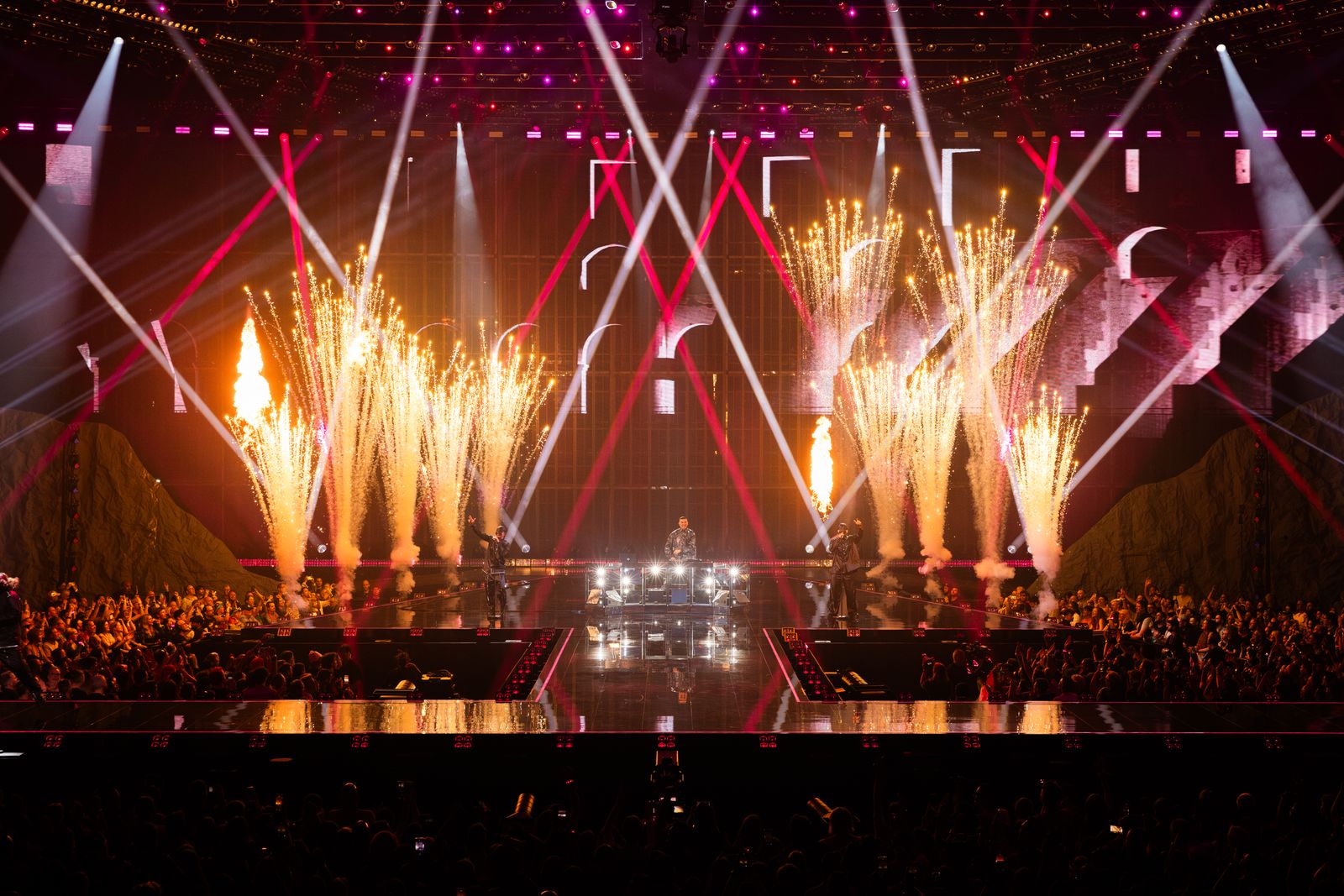

Photos of the lighting control room, LED screen and TV broadcasting
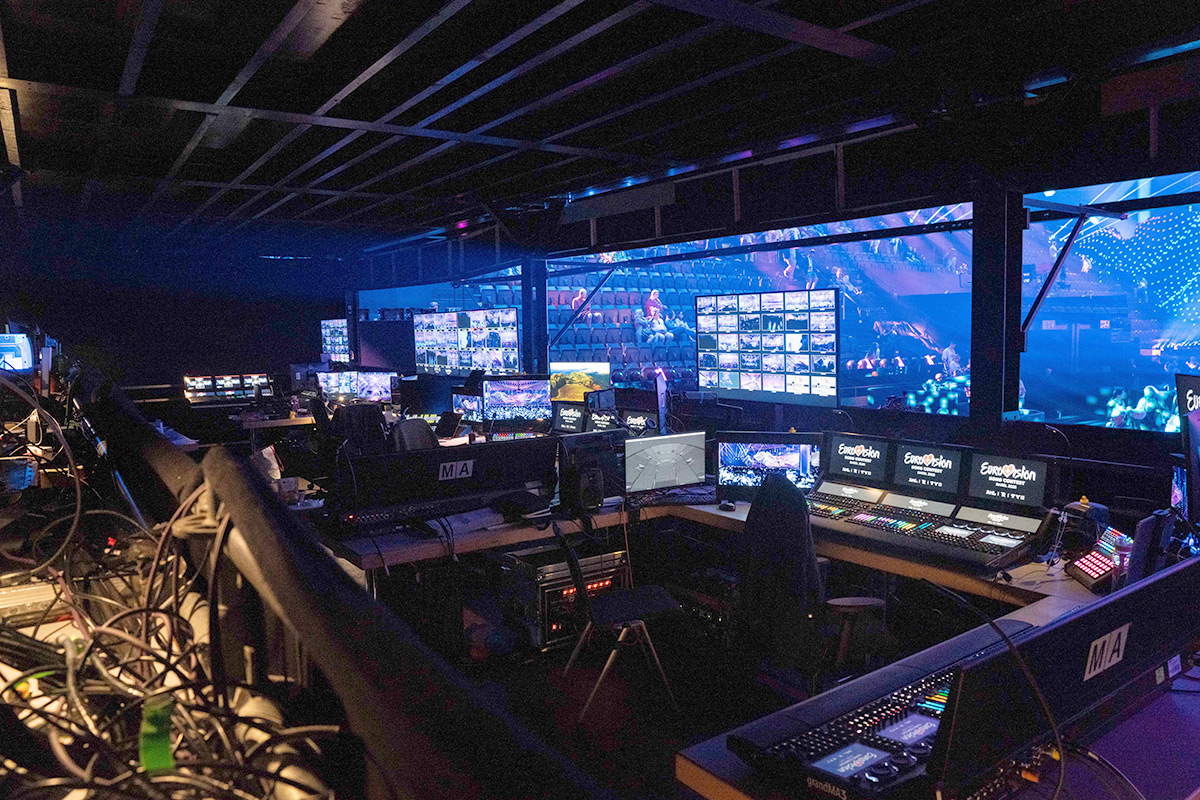
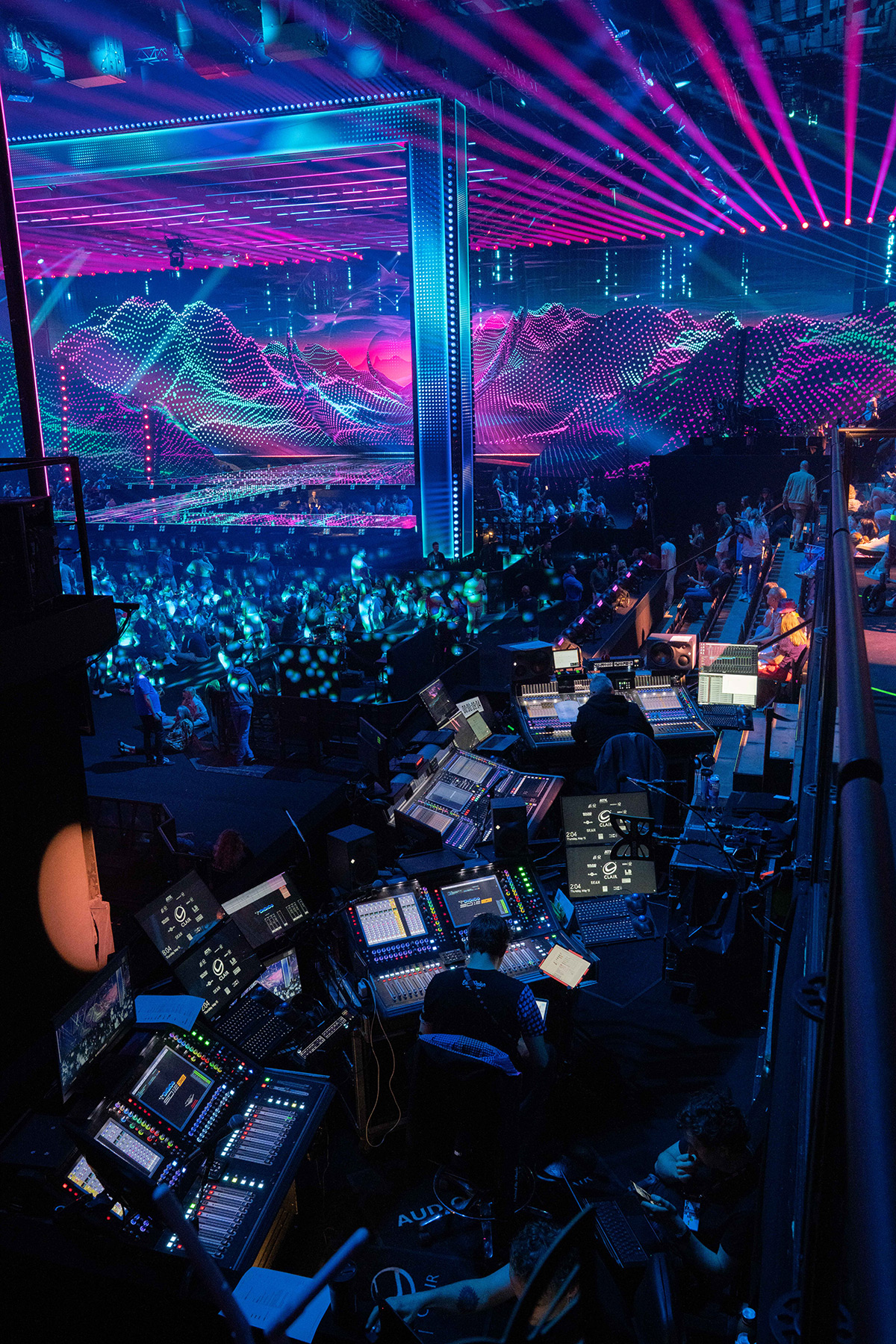
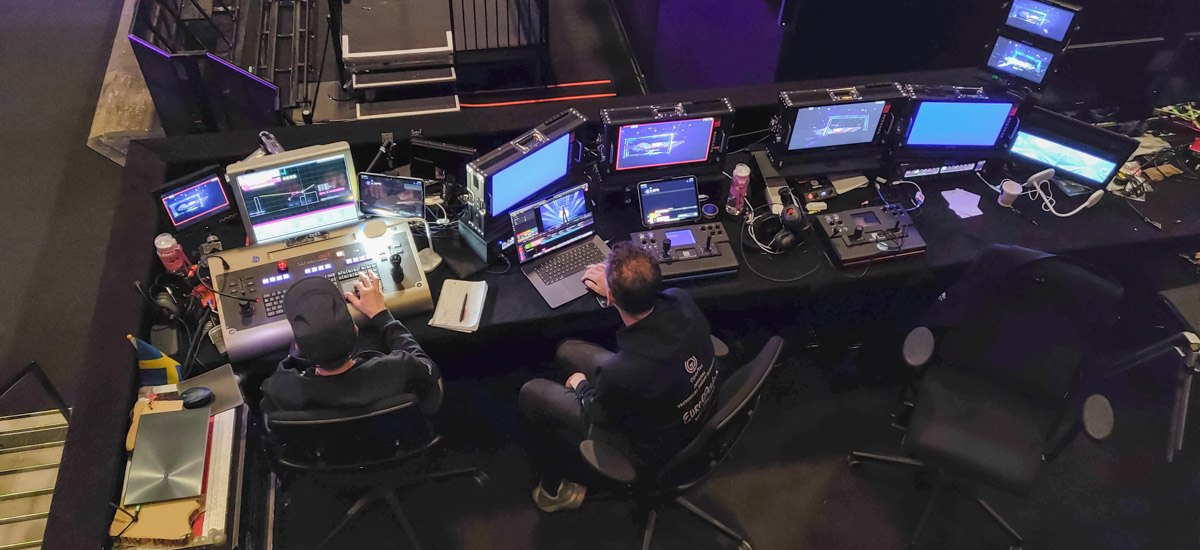
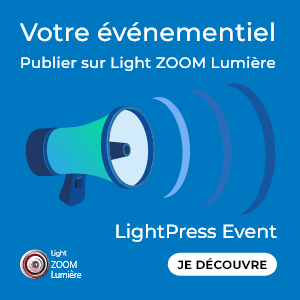
Eurovision 2025 winner: Austria, Wasted Love by JJ
For the Eurovision final, and because the show must go on, let’s take a look back at the winning song from 2025. Congratulations to Austria and the 24-year-old singer JJ, who triumphed at the 69th Eurovision Song Contest. With « Wasted Love, » the song get 436 points in the public vote. Johannes Pietsch, his real name, is already known in the realm of classical music. This marks the country’s third victory, the previous one being in 2014.
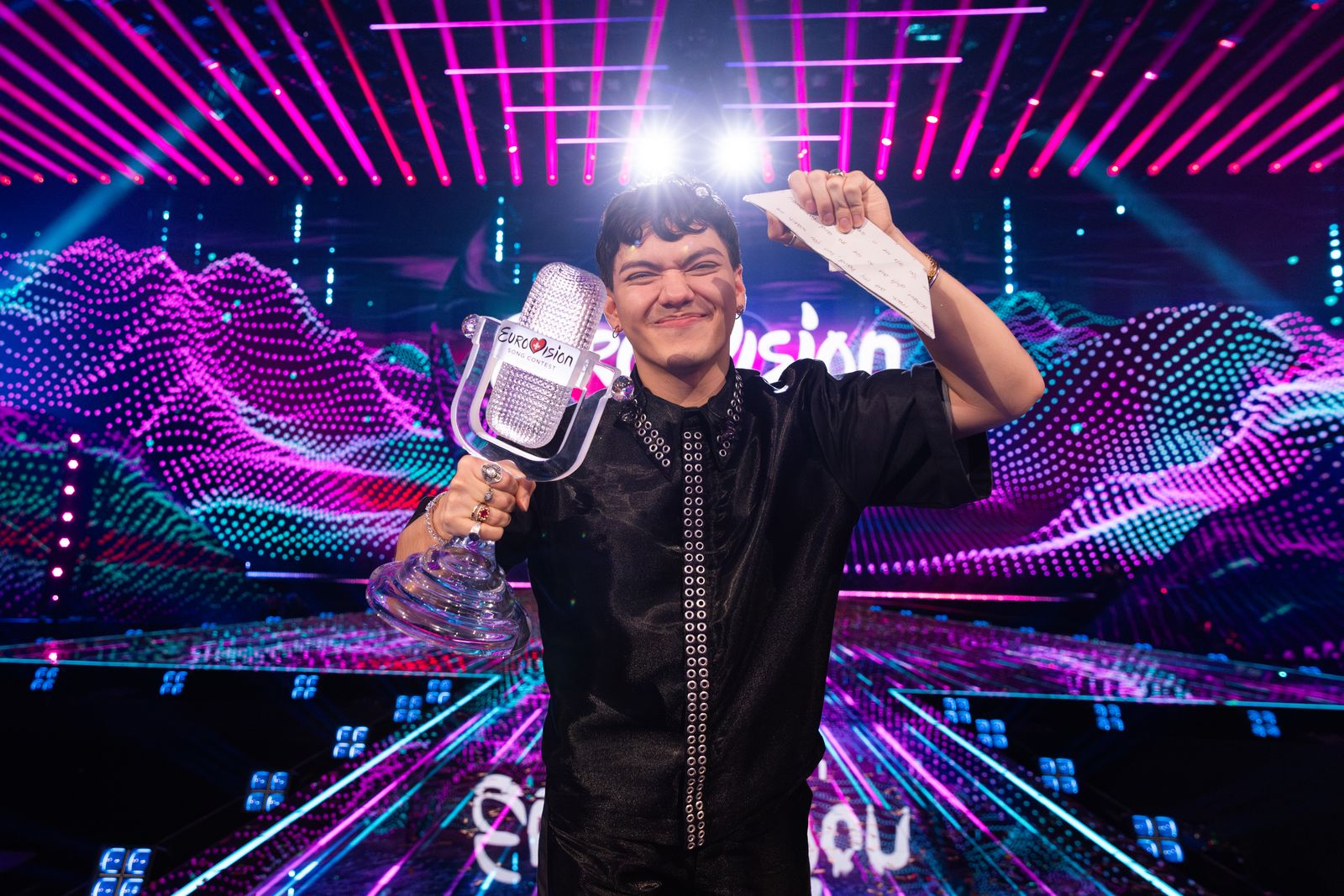
The performance, presented in black and white, begins with a close-up shot of the Austrian countertenor’s face, illuminated by side lighting as he moves from a courtyard to a garden. Gradually, the camera widens its framing to reveal that he is alone with a carrier light on an abandoned raft.
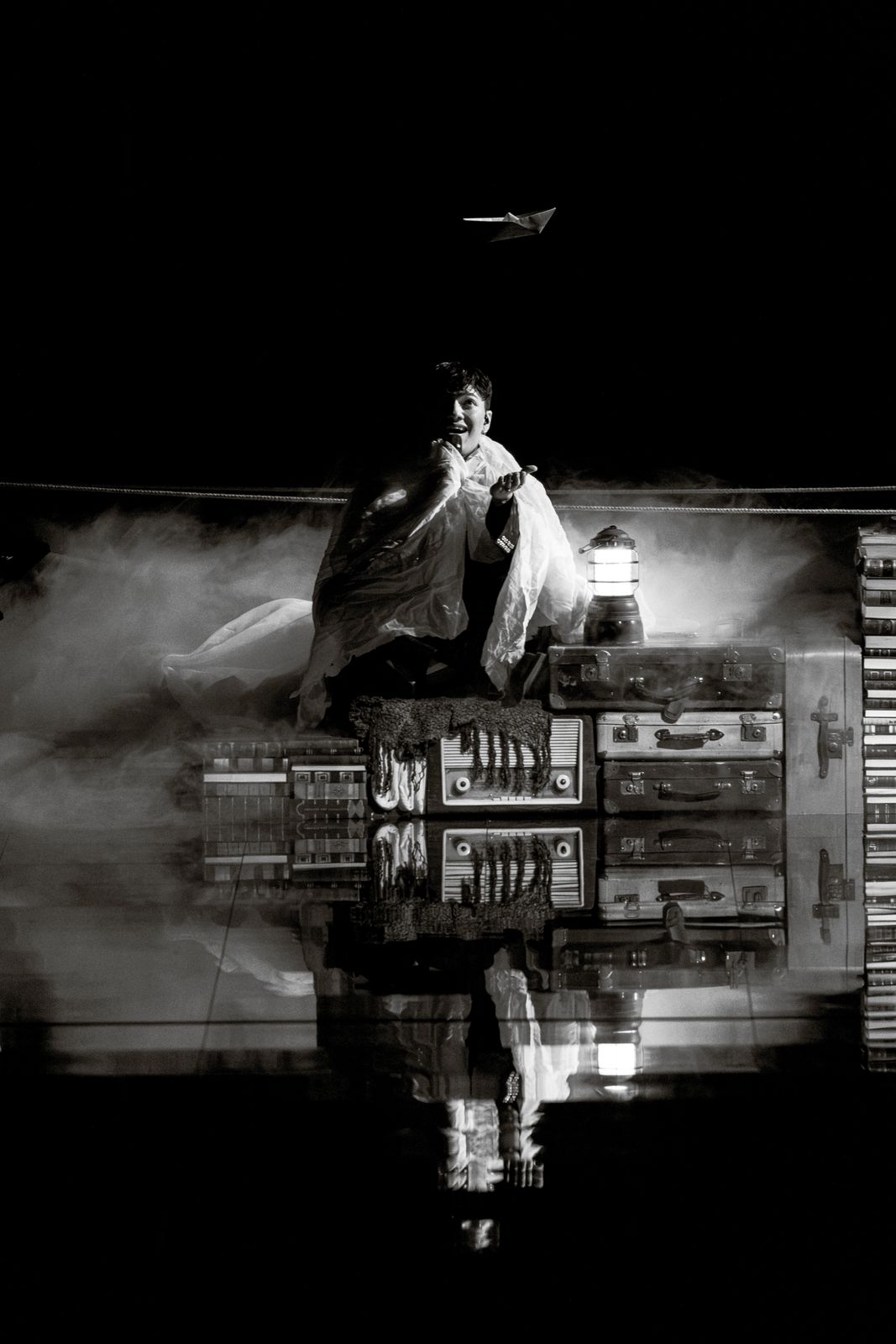
In the chorus, with its soaring vocals, the music transforms into a lyrical opera. Beams of backlit lights flicker. On the screen at the back of the stage, white clouds emerge amid the lightning, while the sea level undulates. At a rapid pace, he heightens the drama. As the white sail unfurls on the makeshift mast, the storm intensifies. The side lights continue to illuminate, quickly embracing one another.
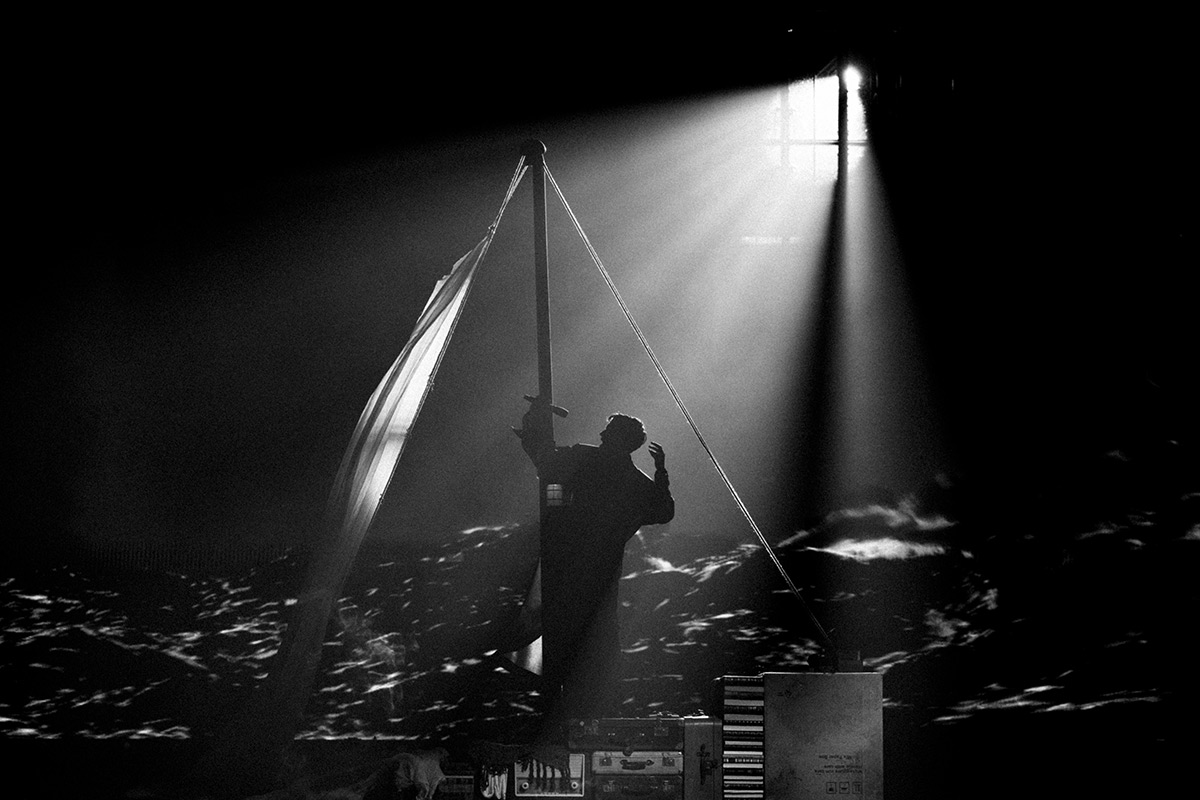
Towards the end of the track, the lyrical music shifts to techno. Several monumental headlights appear on the LED screen, projecting their beams in all directions.
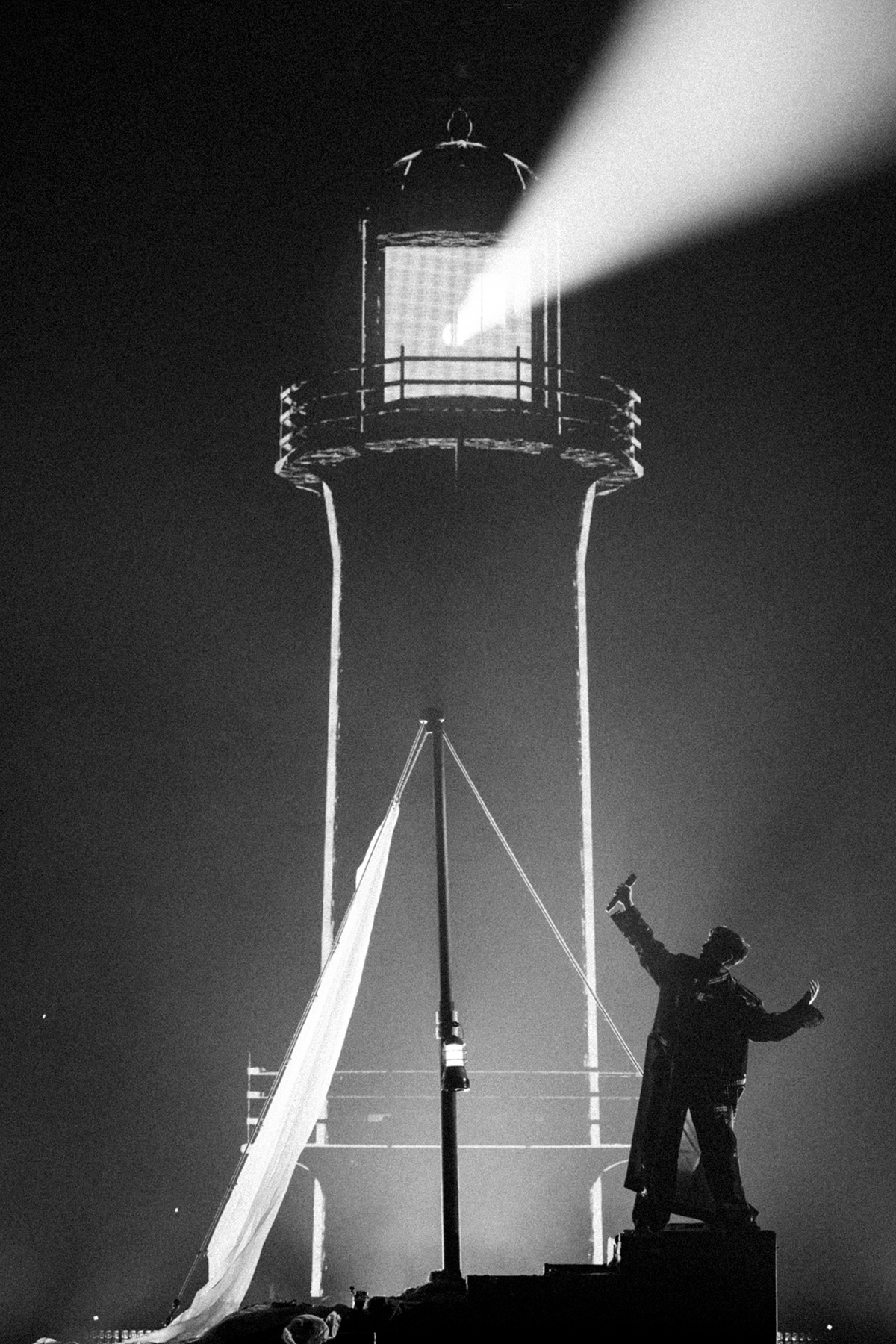
The sea roils behind the raft. The singer loses awareness. The camera shot fills the entire backdrop. The song concludes with a final ray from a lighthouse that dazzles the screen.

Eurovision 2025: France, Louane, maman, 7th place
Congratulations to Louane, who ranked seventh with the song « Maman. » The artistic direction on stage was magnificent, featuring a shower of corks falling from the sky.
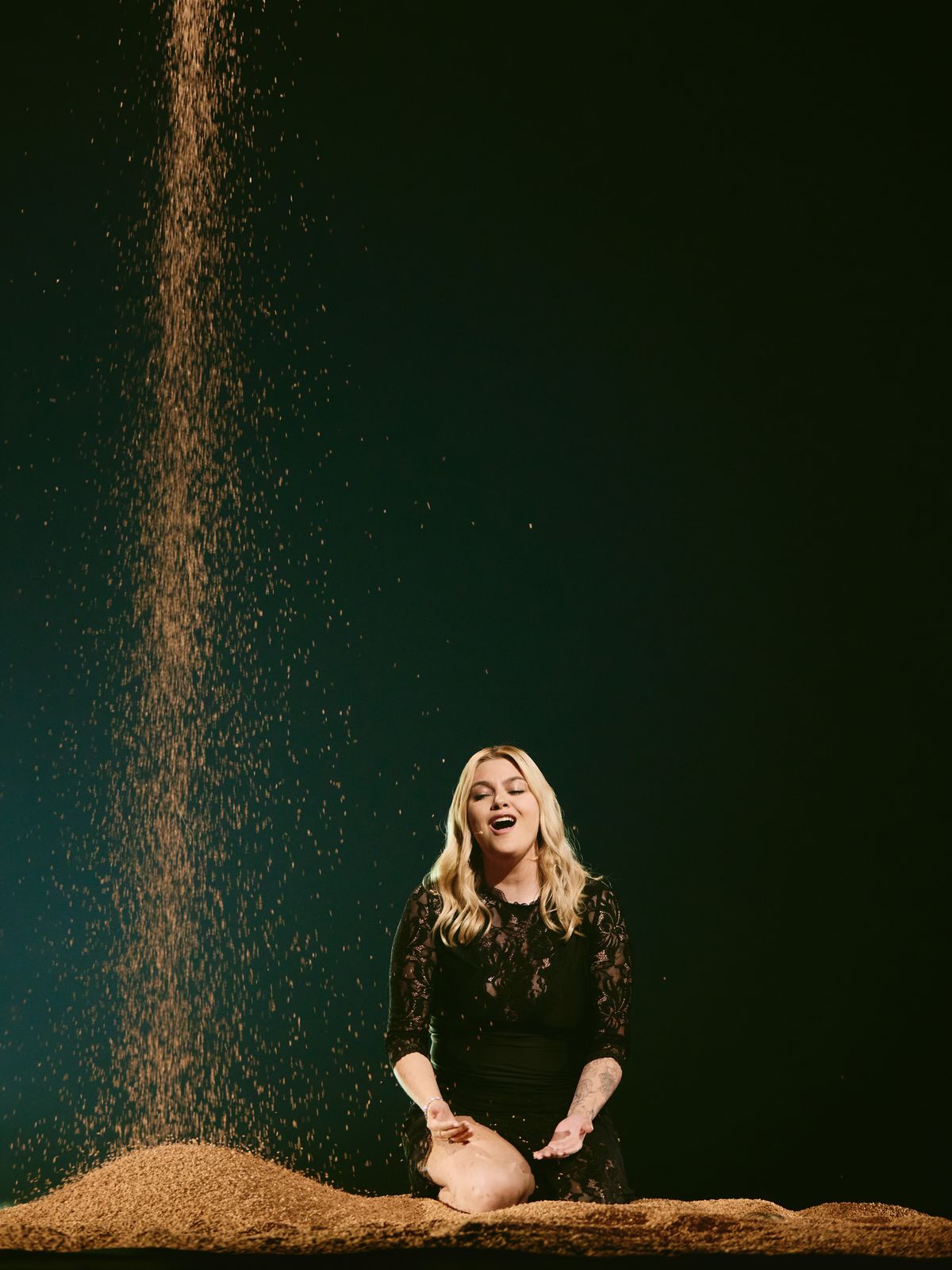
This stunning effect was created by Swedish choreographer Fredrik Rydman, who was brought on board by the French delegation for the occasion.
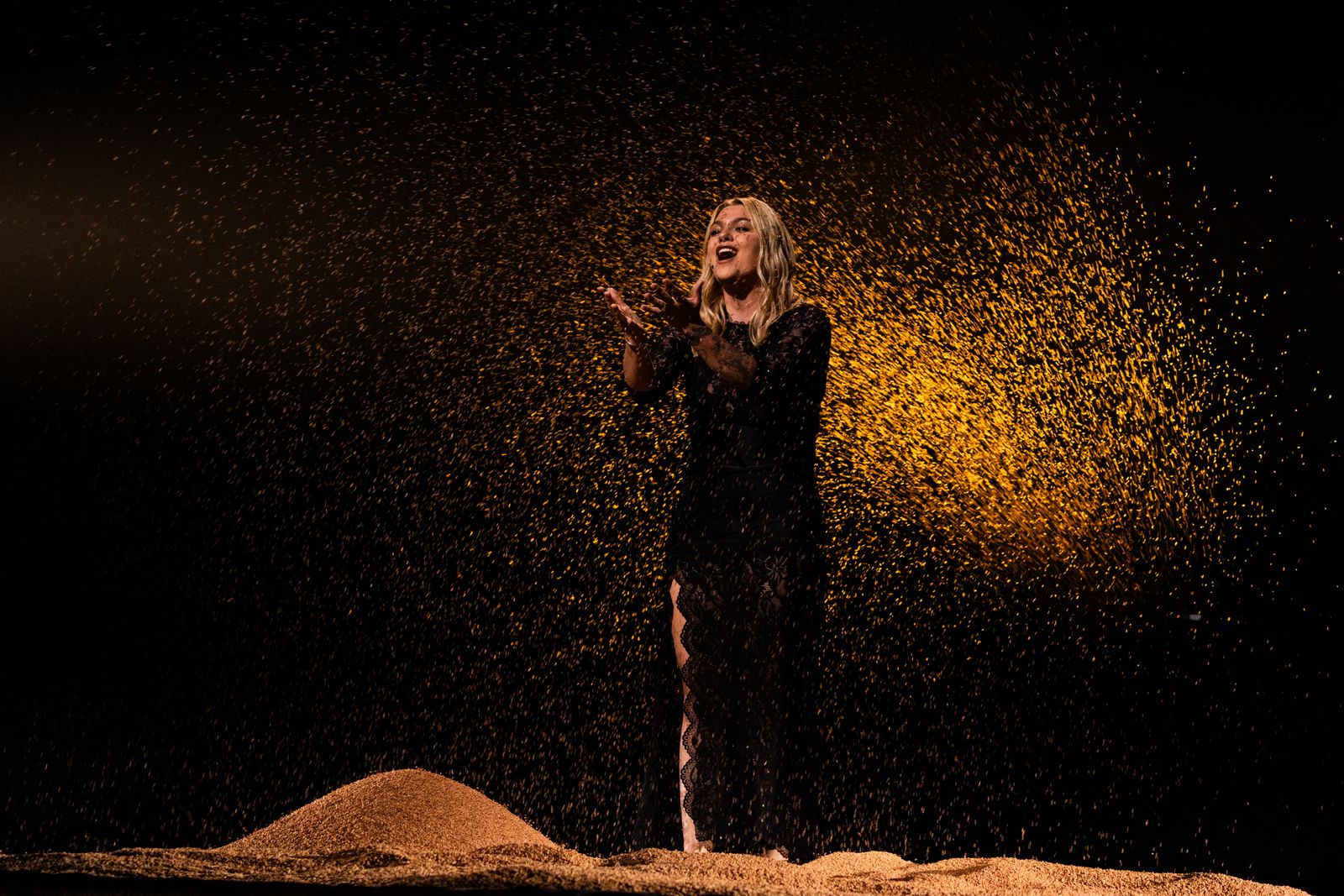
The performance symbolises the passage of time, akin to an hourglass slowly emptying. It represents the transmission between generations and the cycle of life, as Louane has become a mother herself.
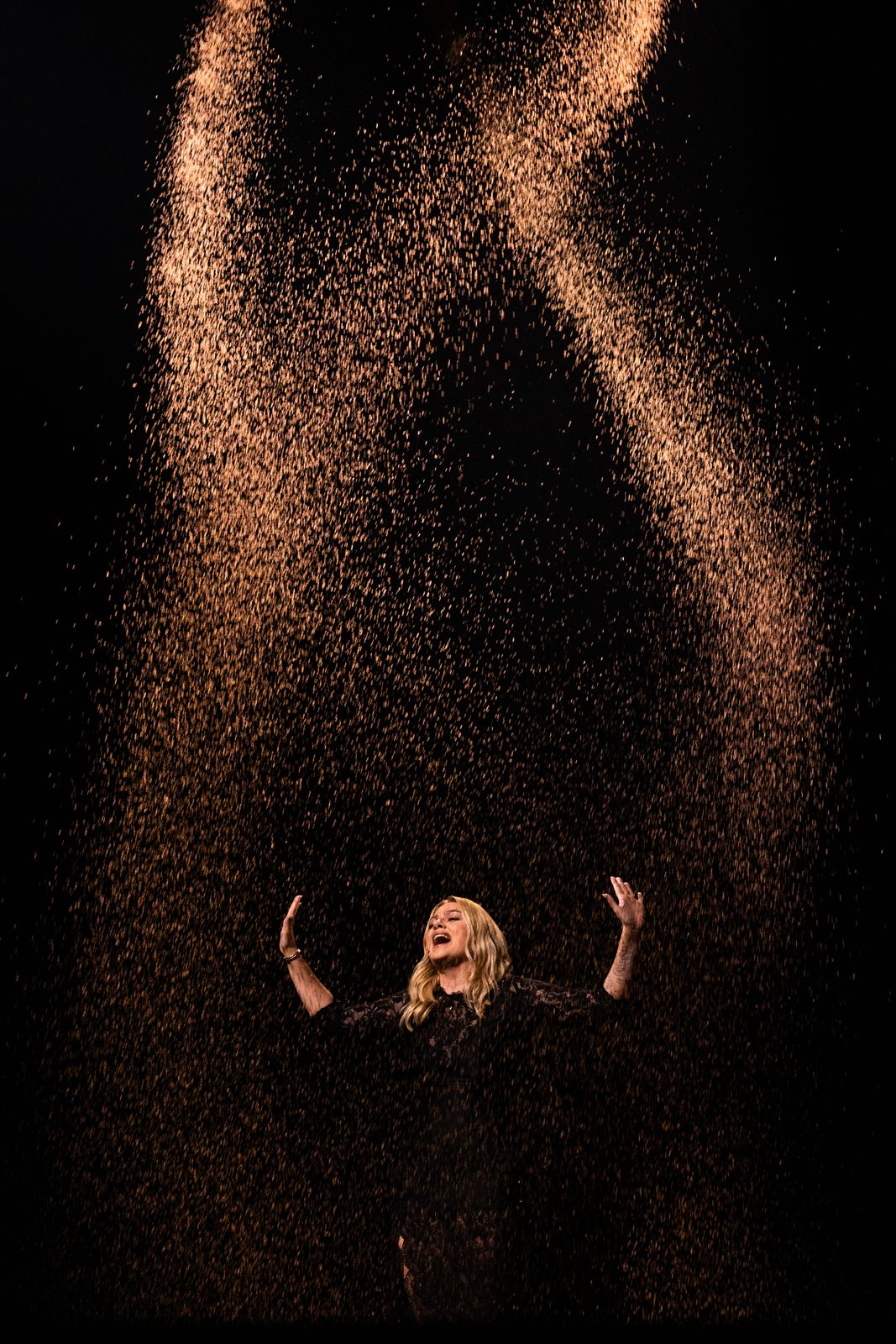
The only consolation for the unfortunate French candidate was that Louane won two Marcel-Bezençon prizes. These were awarded for the :
- best song of Eurovision 2025 by the press,
- best artistic performance by the commentators.
These prizes are named in honour of the Swiss Marcel Bezençon, the founder of the Eurovision Song Contest in 1956.
Thank you for the welcome at Eurovision 2025!
A big thank you to Damaris, Keara, and Carla for welcoming me to Eurovision 2025. The interviews with Peter, Florian, Tim, and Markus were brief but filled with a shared passion for the success of the TV show. The first rehearsal of the second semi-final that I attended on Wednesday afternoon was incredible. The same goes for the backstage tour of the arena featuring the ESC 2025 stage. This immersion allows me to better understand how the contest is executed, as well as its primary objective: to produce the Eurovision Song Contest with increasingly impressive television visuals. Once again, a successful endeavour. Long live the 2026 edition!



